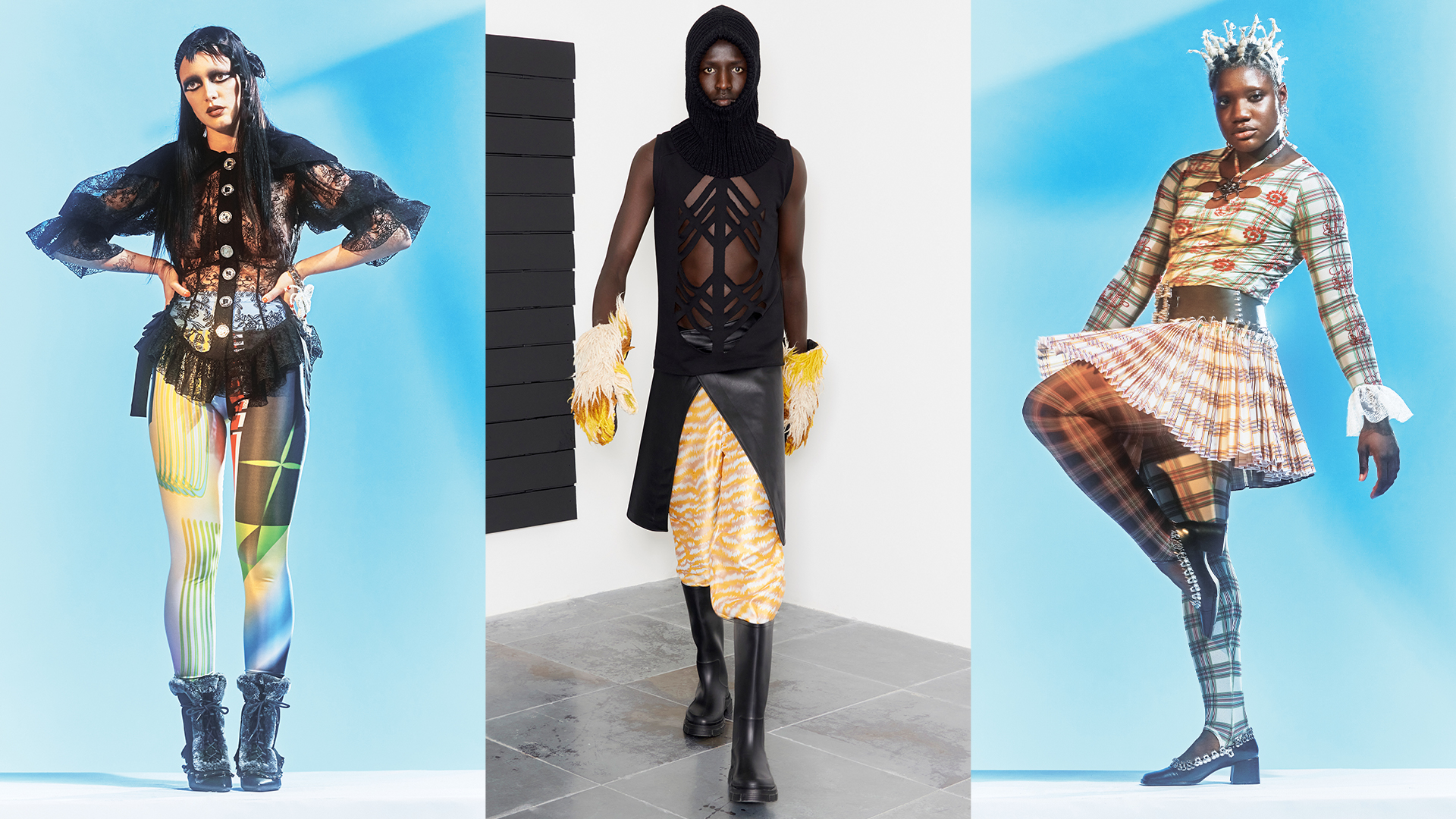And just like that we’ve left the Big Apple and its feast of runways (see our breakdown of NYFW here!) and now are home in the Big Smoke to see everything London’s talents has to offer. What’s there to be excited about this season? We have the fashion week return of ASAI, his first show since AW19!! There’s also collections from Harris Reed, Conner Ives, Nensi Dojaka, Mowalola, Julien Macdonald, JW Anderson, Christopher Kane, S.S. Daley and more to look forward to, as well as the much anticipated first collection from Daniel Lee at Burberry. Additionally, this year’s events have all been dedicated to the late legendary designer Vivienne Westwood. Check in here for everything you need to know about London Fashion Week AW23.

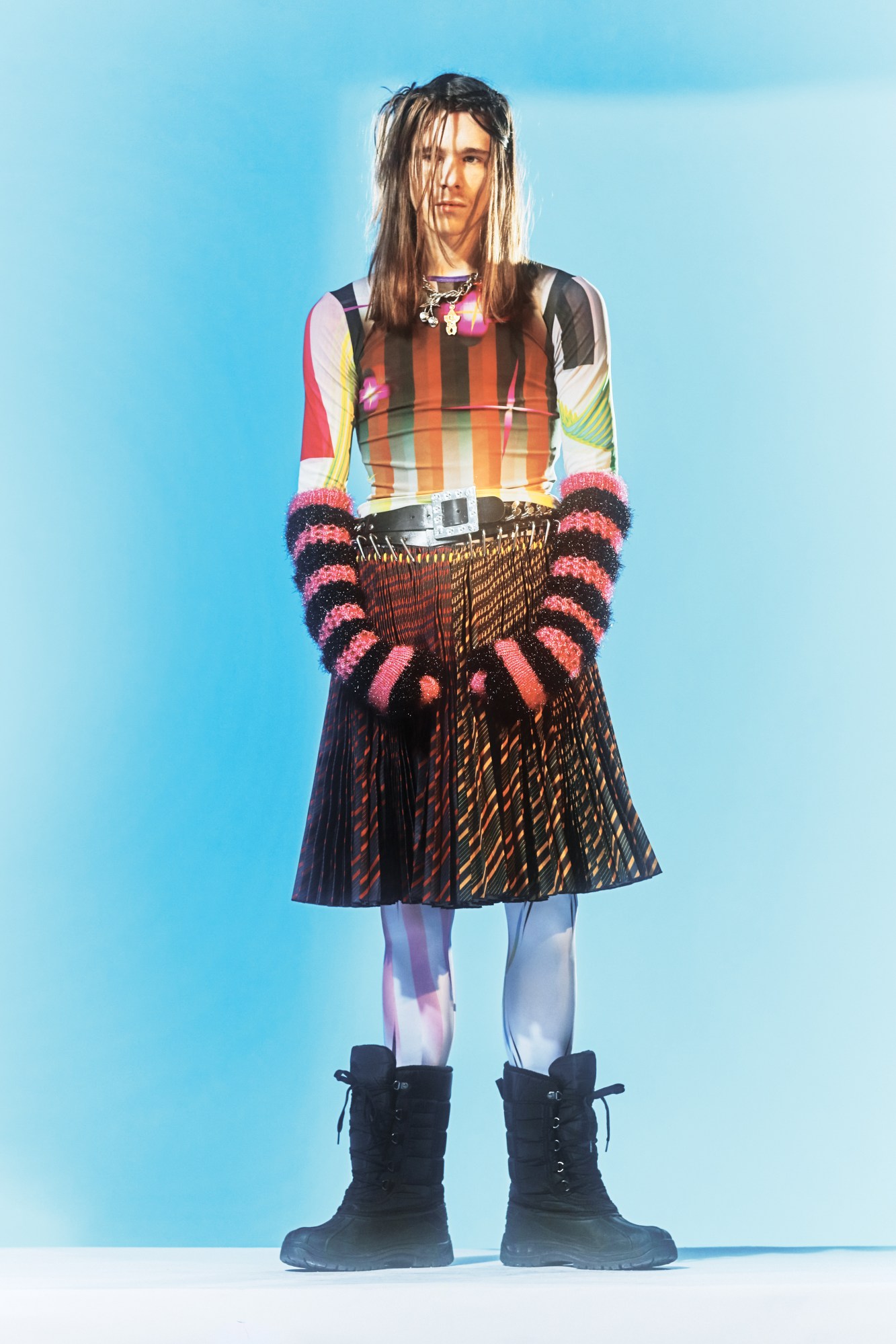
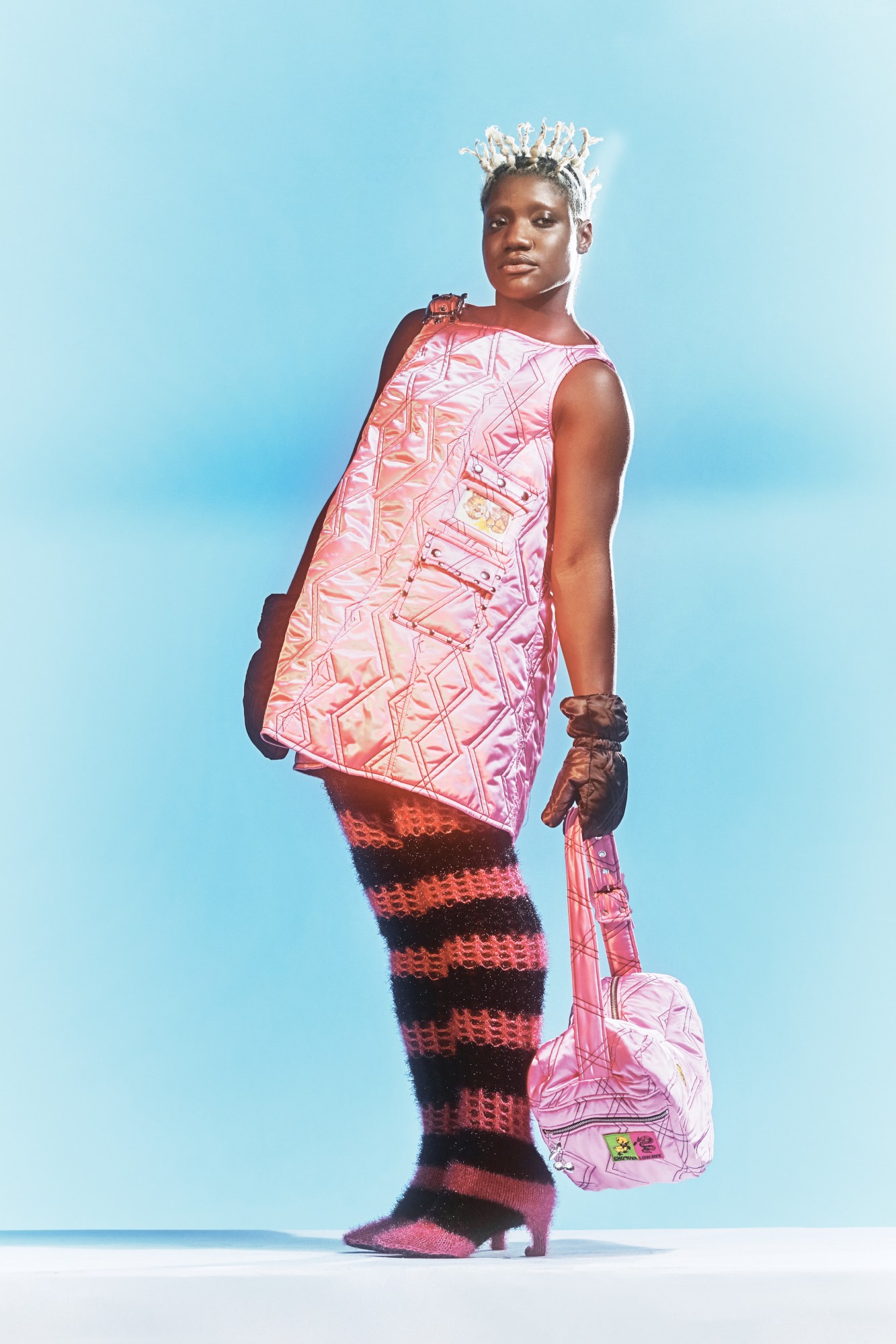
Chopova Lowena
Though they may have staged one of the standout shows of last season – made all the more impressive for the fact that it was their catwalk debut – Emma Chopova and Laura Lowena-Irons have decided to take a step back from the runway for AW23. And, to be honest, they couldn’t really care less about your thoughts on their decision to do so. Their confidence is, of course, amply reinforced by the calibre of the collection they’ve dropped by way of an ethereal lookbook shot by FKA twigs fave Aidan Zamiri, an exploration of the cross-section of 70s skiwear and British Regency attire. Unlikely an intersection as that may sound, through a perspective conditioned by a honed, magpie eclecticism, the duo discovered (or perhaps even created) common ground in an appetite for campy exuberance across the two eras; in the post-Industrial Revolution proclivity for decorative flamboyance – think candy stripes, delicate embroideries and puffs of pearlescent duchess satins – and the zany prints and synthetic zing of vintage slope attire.
Hybrid pieces feature – say, a black duchess satin trouser that includes a gaiter and a Georgian-era ruched knee in a quilted ski jacket fabric – but the result here is less mix-and-match costumery, and more an innovative excavation of an entirely new sartorial territory that comes through the careful overlapping and clashing of these distinct registers. Baggy pyjama-style pants feature the plastic-picture windows you’d expect of a childrens’ snow jacket, and sporty lycra leggings come in pastel Regency stripes with lace ruffles at the hem. Sugar pink matelassé quilting is used for an A-line shift dress, as well as classic cropped bombers, while the tie-on cap sleeves are blown up and reinterpreted as dresses and skirts.
Beyond the immediate theme, Chopova Lowena staples are reimagined – or, rather, staple Chopova Lowena motifs are introduced to new categories, a standout piece being a generously-proportioned leather jacket that features a carabiner-clipped belt at the hem. The brand’s trademark cutesiness is also carried through with recycled lace pieces that feature a folkloric storyboard and a puppy and a bunny rabbit exchanging gifts, mohair knit cardigans interwoven with ribbon details, and laced-bow prints across socks, poplin dresses and flounce-hem culottes. Indeed, whether for bombing down a black run or taking tea in a Regency-style tea salon, there’s more than enough here to tide you over until Emma and Laura decide to make their runway return. MS
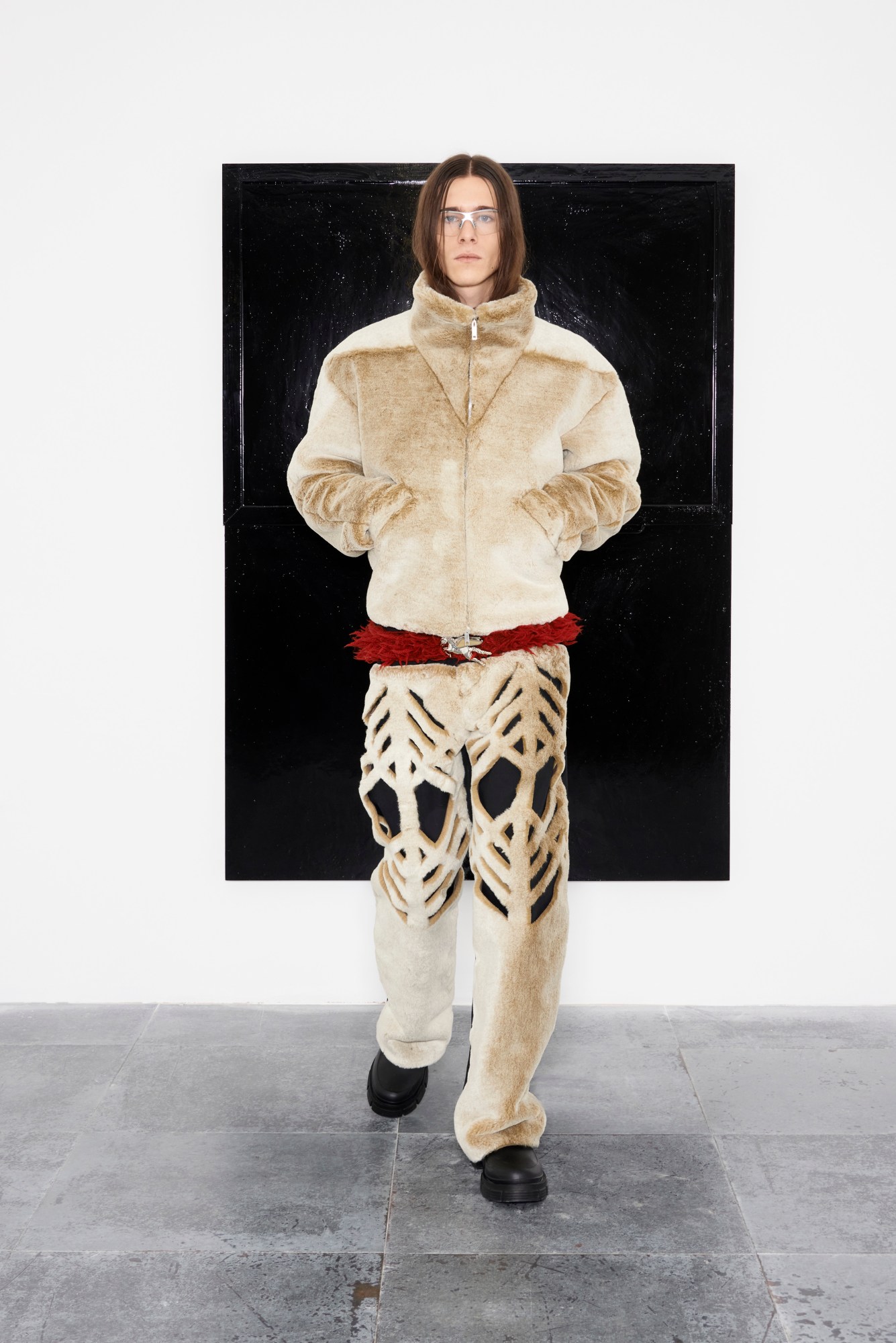
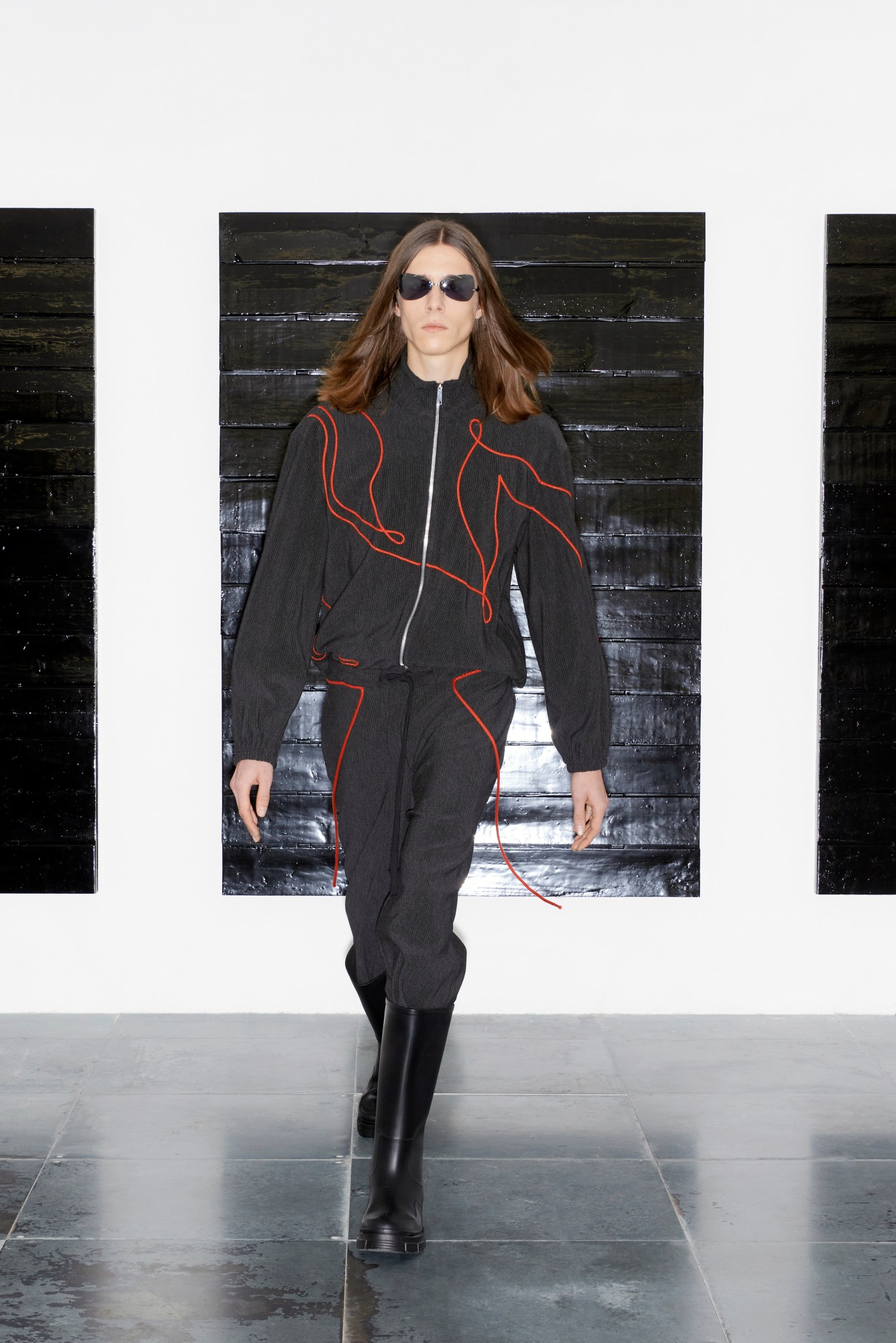
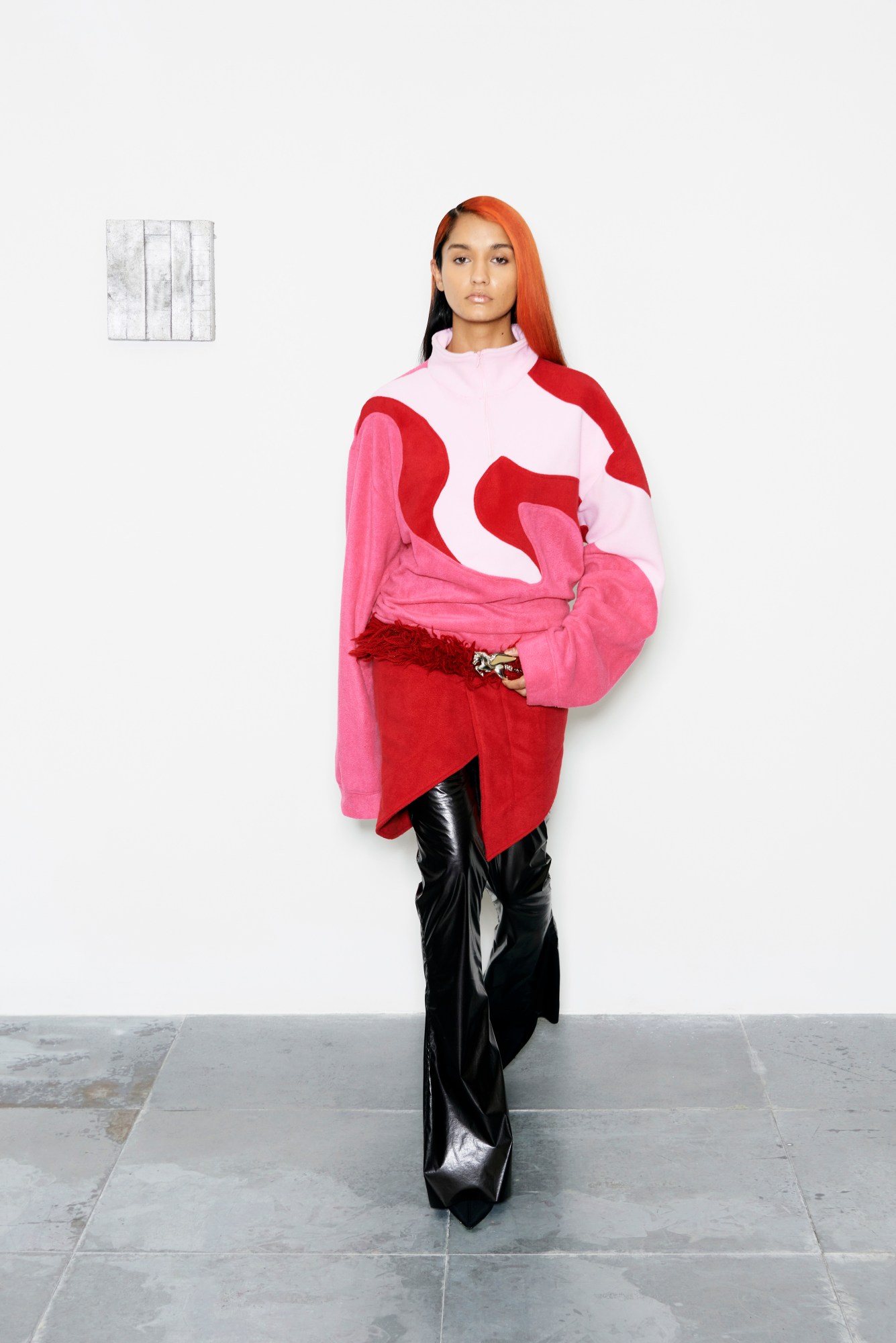
Av Vattev
For AW23, Antonio Vattev – the designer behind the eponymous label AV Vattev – opted for a nostalgic tack, looking back on the artists he first discovered on moving to London from Bulgaria to study at Central Saint Martins – artists that have figured as inspirational touchpoints ever since: Georgia O’Keeffe and Christo. Looking to the formal intricacies of their respective bodies of work – in particular to the romantic expressiveness of the former’s flower paintings and the structural precision of the latter’s wrapped monuments – this season sees the designer expand on his familiar vocabulary through novel fabrications and colourways.
Laser-cut diamond grids figure across knit vests in scarlet and teal and faux fur trousers that suggest a sumptuous ski-slope-ready tone – one only made strong by this season’s Halishte-trimmed nylon parkas. A turquoise leather coat brought back the cross-over straps we’ve previously seen on blazers, and the designer’s O’Keefe-inspired floral motif, once limited to colour-blocked knitted sweaters in expanded to knitted skirts, an olive leather pullover in a bomber silhouette, a coat constructed from panels of nylon and felted wool, and a fleece in lurid pink, white and scarlet hues. All in all, a collection that lived up to the legacies of the artists that inspired it. MS
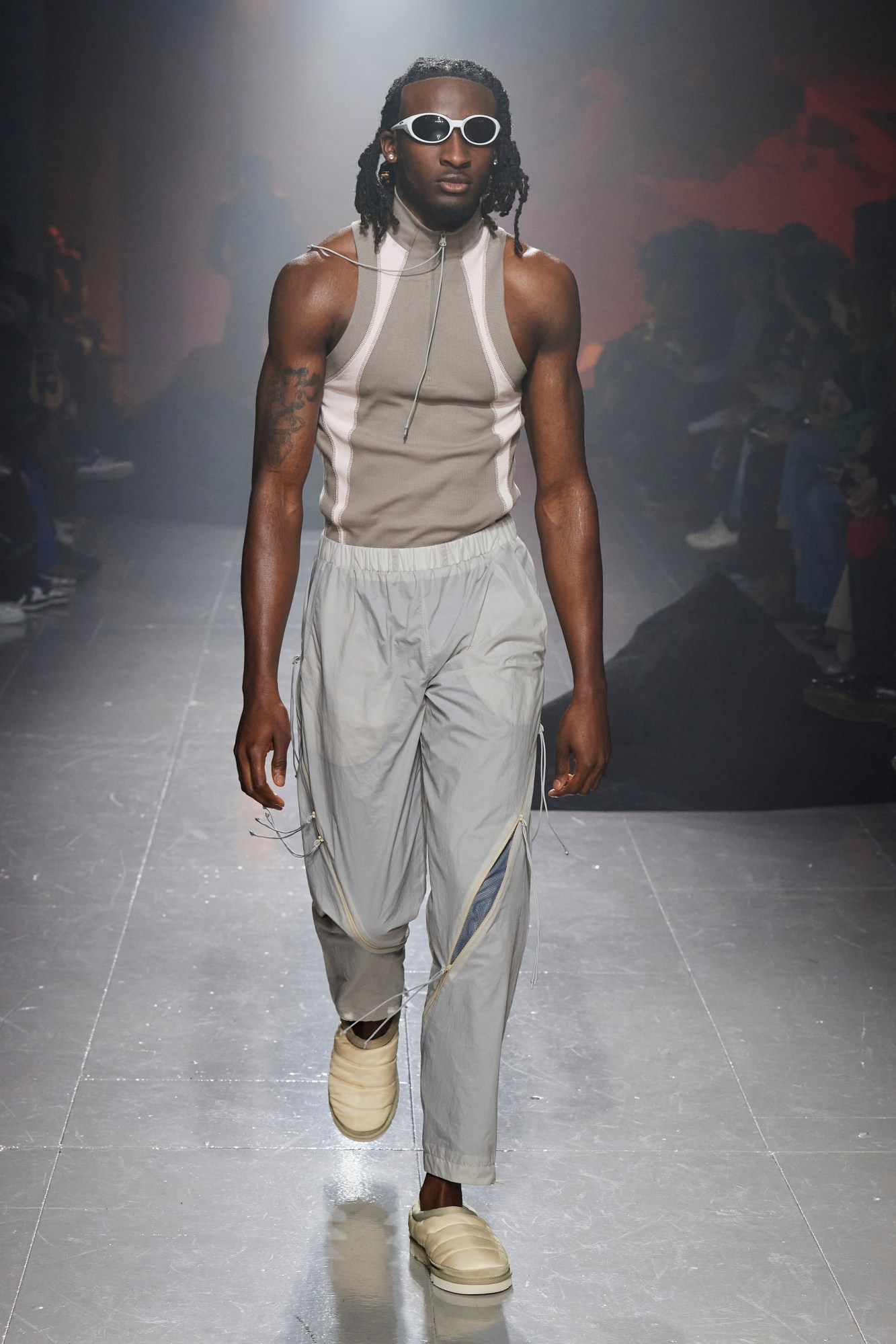
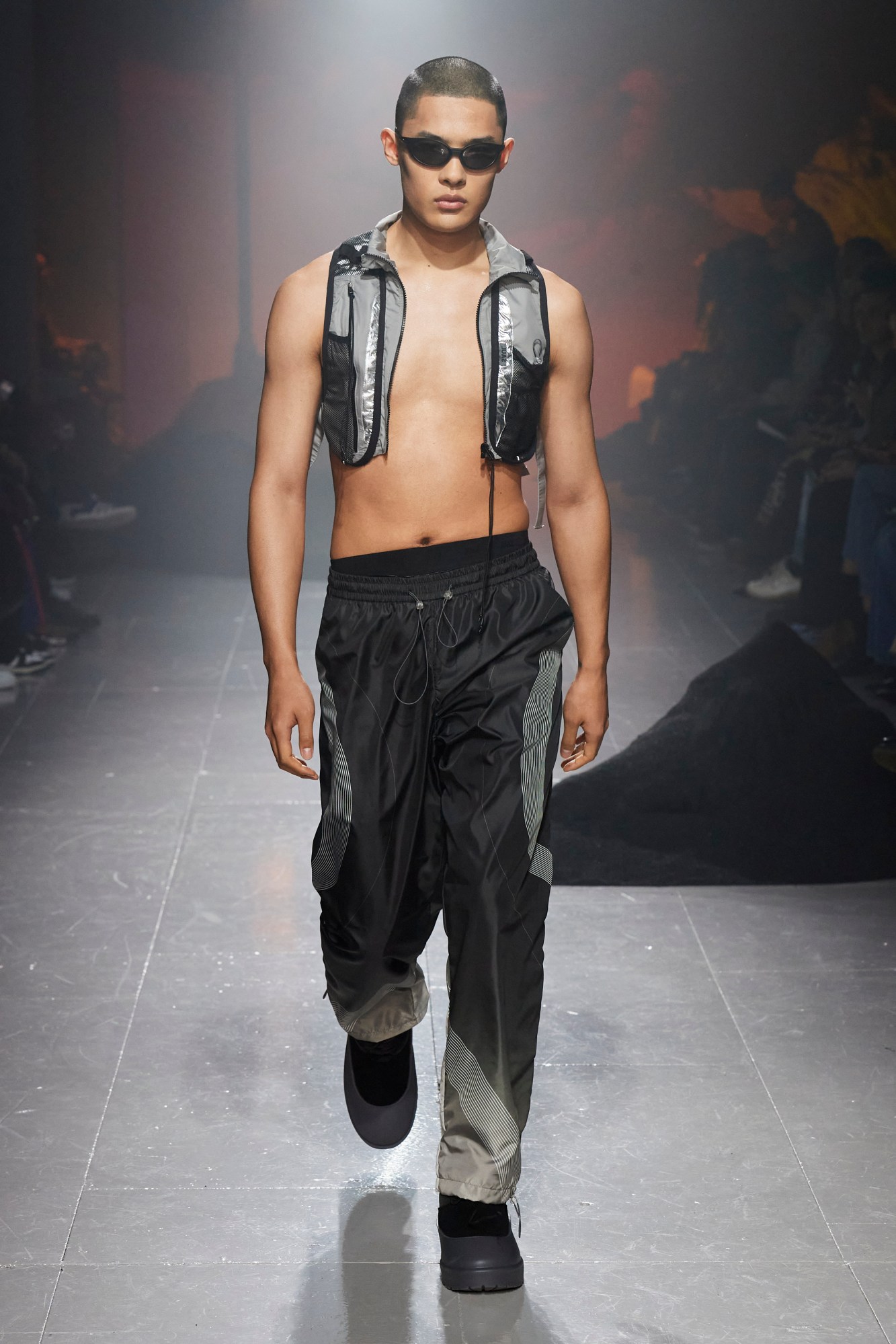
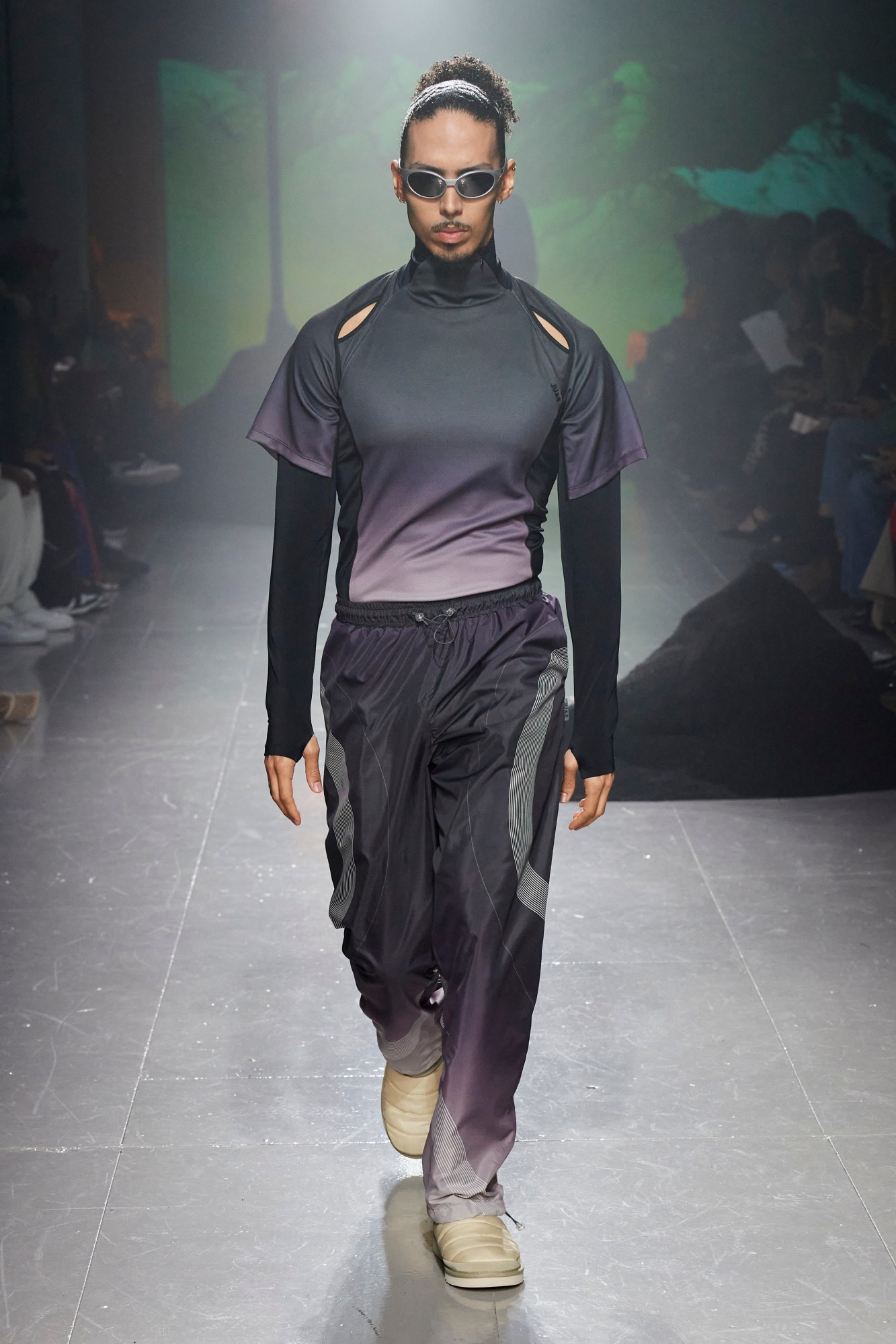
Saul Nash
The world might be slowly getting hotter, but Saul Nash is convinced that AW23 at least, is going to be chilly. Models shivered, rubbing their hands together, blowing into their palms to keep warm in the designer’s elegant, elevated take on activewear. This was skiwear via Zone 1 rather than Verbier, though, which makes sense, given the Londoner behind the collection. “When you grow up in London, you wear a lot of ski outerwear, but you never learn to ski”, Saul explains (see also: groups of fintech workers in Soho wearing identical Canada Goose jackets in balmy early October). “It’s a symbol of aspiration that’s juxtaposed with the realities of everyday living.” That ‘Juxtaposition’ was at the heart of this collection from the 2022 International Woolmark Prize winner (and the name of it too). These were technical pieces, functional but beautiful, tailored but casual. The presentation played into the idea of opposites too, with models in Merino knit sweaters with cleverly aerated ventilation, padded down coats with kinetic lines, soft cocooning gilets with zip off sleeves and the presence of a tailored jacket. Streetlamps dotted the runway as these models danced around each other artfully, as though this was the black run on Val d’Isère rather than central London. Padded Uggs and wrap around Oakleys completed the apres-ski effect, the burnt orange and hot red lining of the cleverly draped pieces, inspired by volcanic mountain ashes, further bringing the outside in. It’s almost enough to make you yearn for colder days and dark nights and wish spring would never come. Well, almost. RL


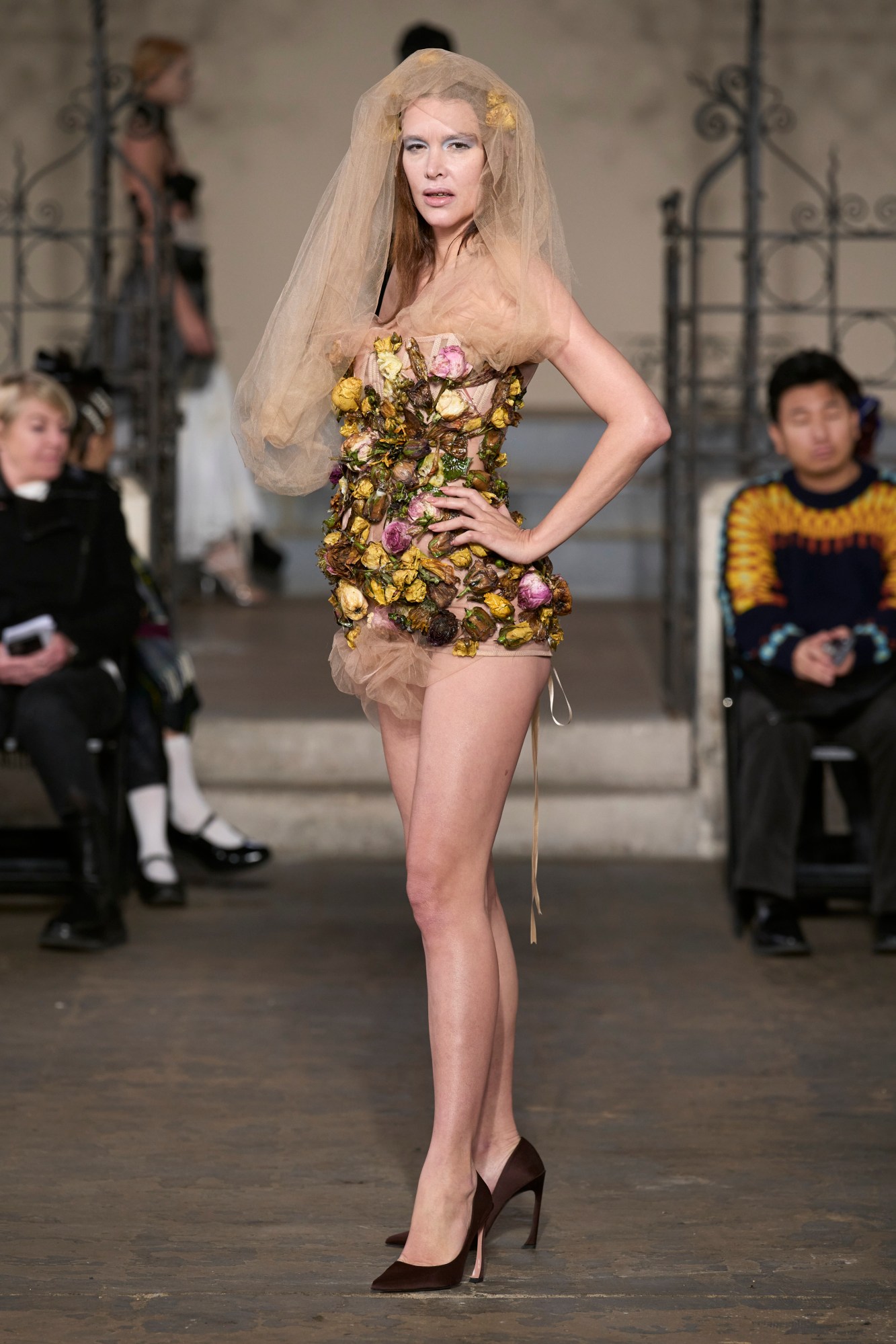
Dilara Findikoglu
At two in the morning, just ten hours before she was set to debut her AW23 collection, Dilara Findikoglu wrote a deeply personal letter to the guests later attending her show – which included Bimini Bon Boulash and RHOBH’s Lisa Rinna – about the pain and helplessness she felt about the earthquakes devastating her homeland, Turkey, as well as Syria. “Sometimes I feel like I’m trapped in my own reality inside my head, and because of the nature of my job I feel alienated from the real world, which for the most part is a good thing,” she expresses. “Even though what I try to create is sort of an escapism from all the corruption and the mess or sometimes even an antithesis for the existing fucked up system.” Responding to the natural disaster by asking her guests to donate, the collection itself was an exploration of a response to a different fucked up system: the patriarchy, specifically the control men have over women’s bodies and what they wear.
Set within an ancient, bare church with a cage-like chapel at the front, a crucifix lying on its side on the floor, and an ominous shadow looming on the cold stone wall from where it once hung, an ominous sound bath of raindrops echoed through the space as Dilara presented the looks of 34 “precious characters”. Feathered bras were left unfastened at the back. Briefs in sultry red velvet, smart pinstripes and motorbike leathers featured fly zipper detailing. Skirts with cinching waists from stiff, restrictive garments sit open or were removed entirely while corsetry details became markers of sexual expression as they sit on top of shaggy coats, bound arms behind model’s backs, or were covered in dying botanicals that looked like they’d become stuck to the undergarments of an intoxicated runaway bride. The stand-out look, however, was entitled Joan’s Knives and featured a black dress with the sort of silver cutlery knives you could imagine a 1950s housewife polishing, bent into a suit of armour over her body that rattled ferociously with every step. As the models performatively inhabited the space, running around lost, stumbling drunk, leaning provocatively against the church columns, they wore their sexuality, their confidence, their anxieties and their struggles all at once on their sleeves (or latex gloves), irrespective of how society expects them to behave. TG
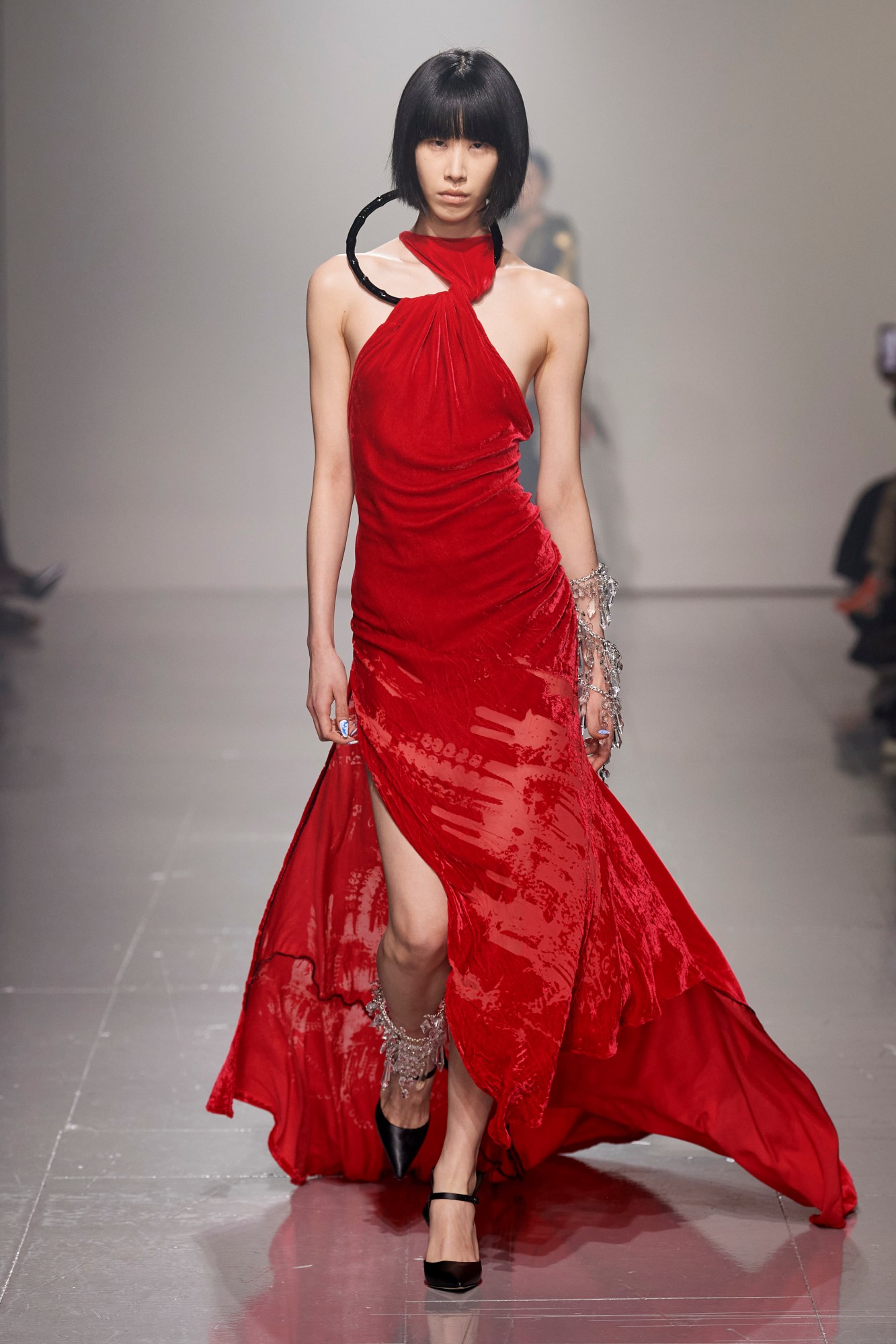
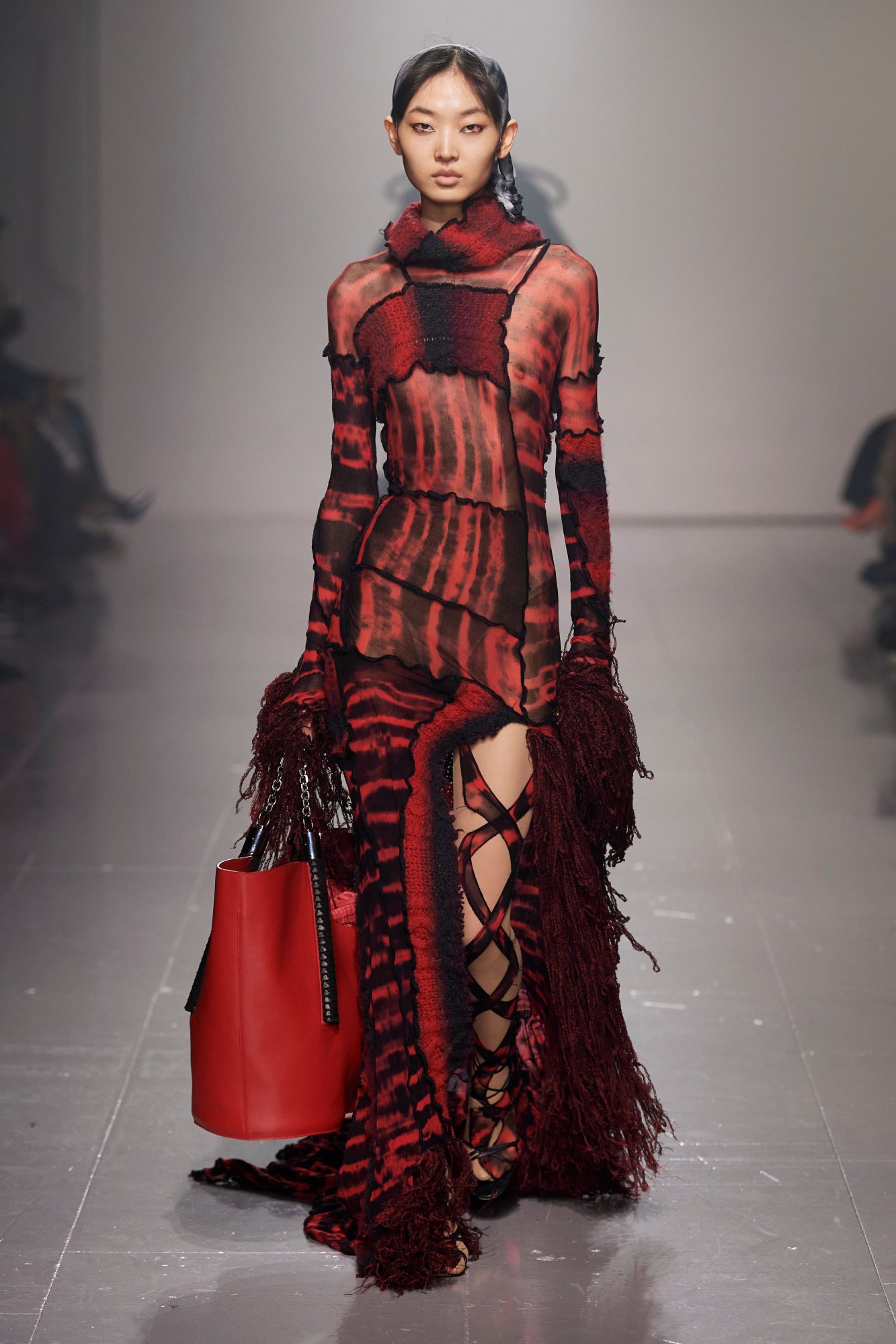

Asai
“It’s been a constant push and pull between trying to find my place in the industry. At a time when the world was going through so much chaos, I was seeking calm,” shares A Sai Ta, who hasn’t shown a collection for his label Asai since AW19. “When all of my other pillars fell down, fashion became the pillar that pushed me forward and could really ground me, where I can put all my energy into. I want to work from calm, not chaos. I have my intentions. I want to dream bigger.” Bigger was what we got for his runway return and the designer went full circle, opening the show with a red twisted halter dress with an off-centre ring around the model’s neck that paid homage to the opening look of his first Fashion East collection, an era that cemented him as one of London’s most exciting designers. Dangling from the models’ arm and leg, too, were drapings of crystals inspired by the chandeliers of Danh Võ. Knotted shaggy threads were patched into frayed gowns or piled into a haystack of a head-piece over a puffy pussy bow dress sheeted with a thin layer of gold. His sexy and deeply coveted ‘hot wok’ overlocked pieces became even sexier across one-shoulder garments, lacing up legs and distressed to reveal as much skin as possible. Distressed denim was everywhere too, making barely-there tiger print gowns, thigh-high boots fallen to the heel and ribbons of strands dangling to the floor from a corset. Weaponry continued to be a theme for Asai, with nunchucks holding leather across model’s chests and shocking leather spiked ball and chain bags. “Can you take my breath away?” asked the show notes. Asai, at least, has proven four years on that he can still take away ours. TG
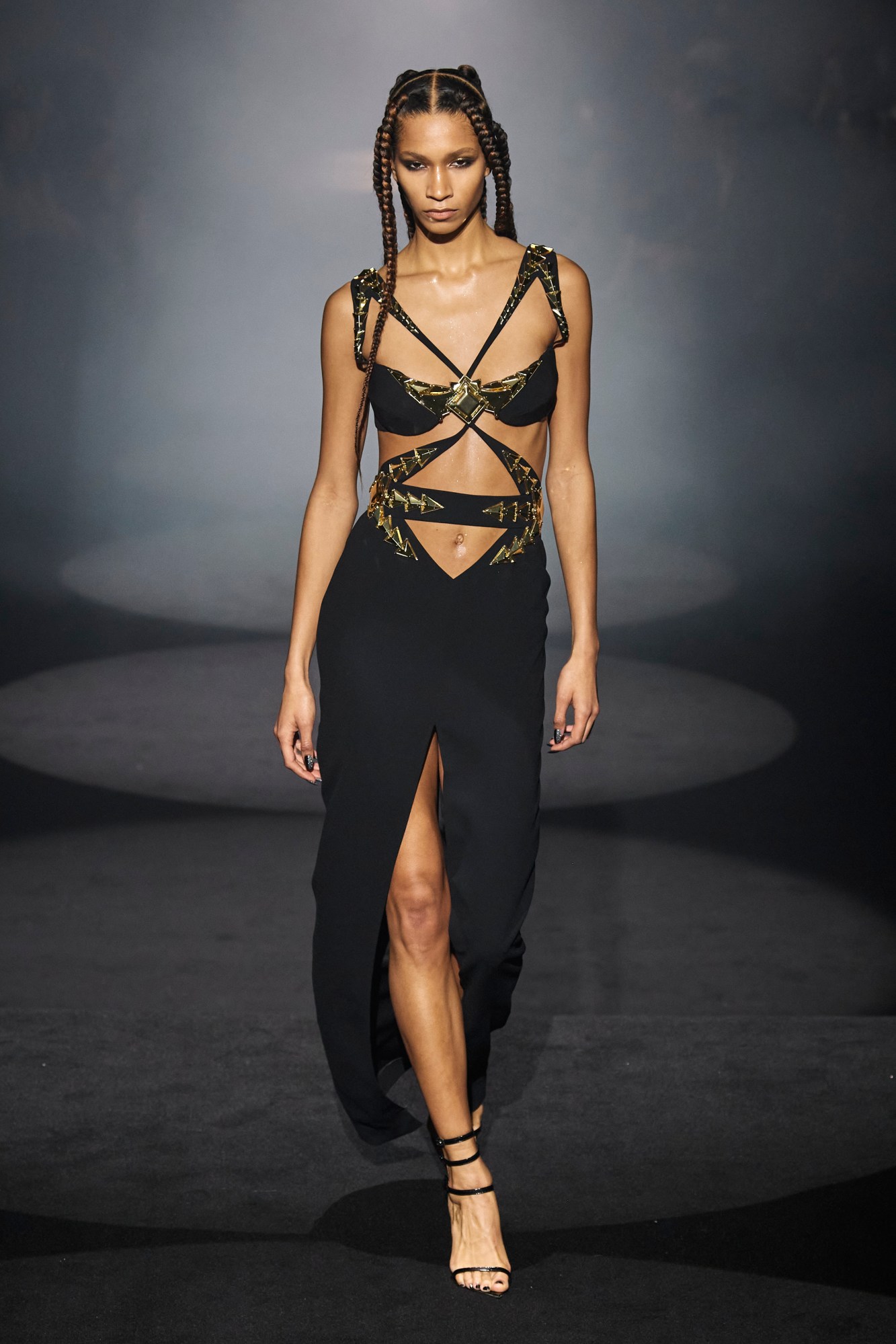
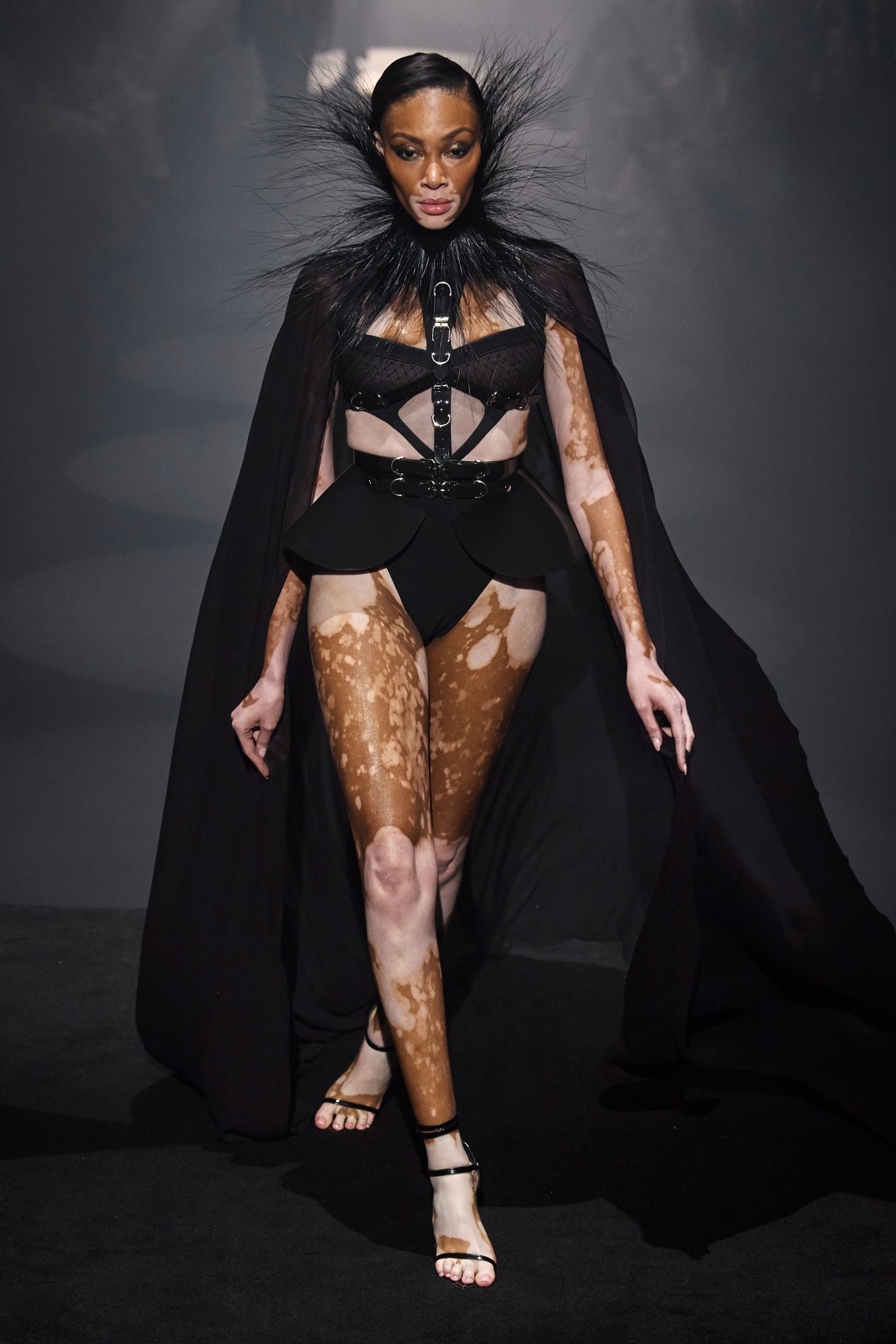
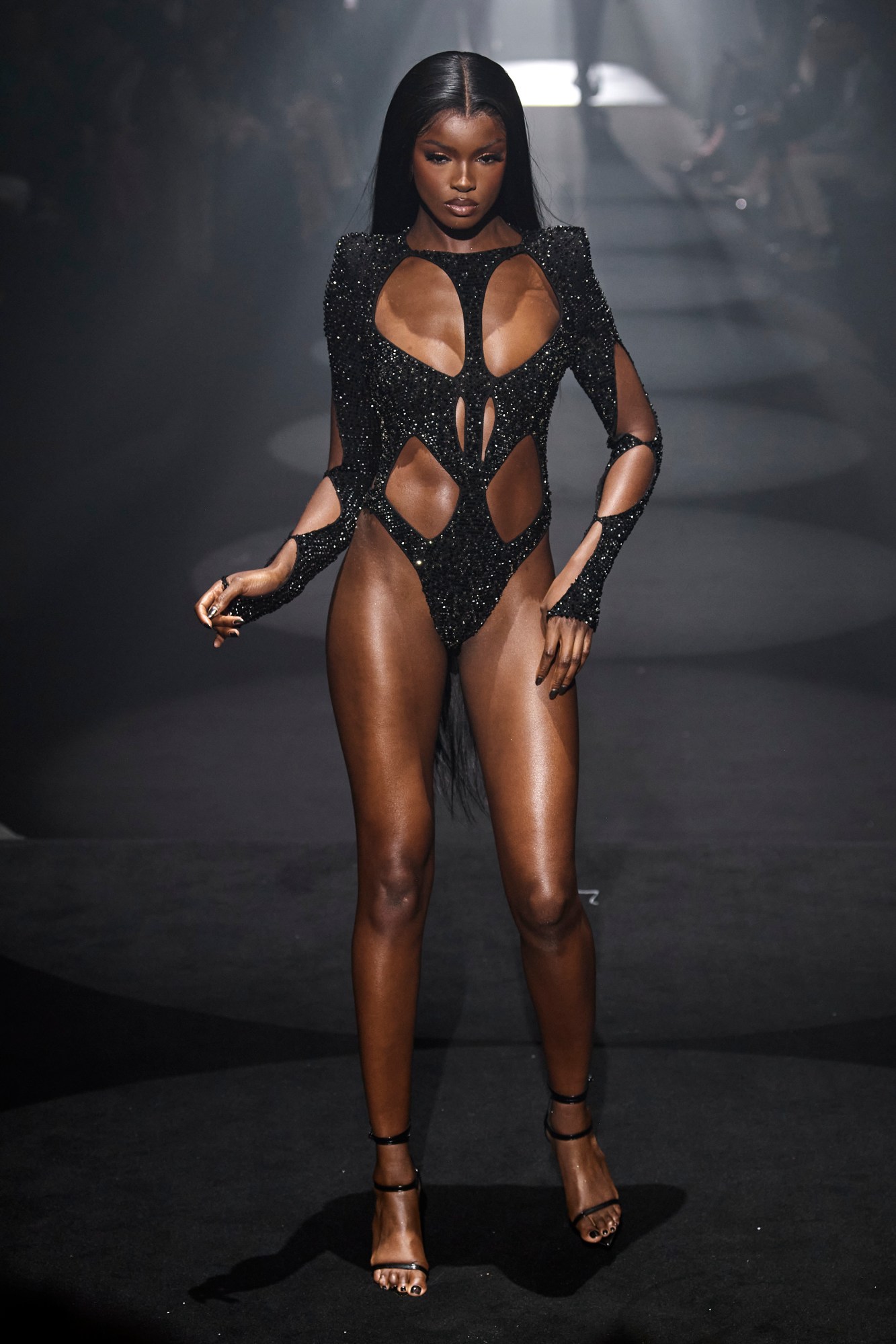
Julien Macdonald
A question we’ve been pondering: how exactly do you convince Beyonce to do a remix of “Break My Soul” and cancel the order where she replaces the words “break my soul” (the crux of the song!) with the words “Julien Macdonald”? Presumably the answer is: by virtue of being Julien Macdonald. The Welsh designer’s glorious comeback to the catwalk last night was a celebration of his own star power and legacy. Freemason’s Hall, packed with enough sequins and glitter that the runway was being hoovered before the show even began, was filled with what felt like half of London and most of Essex too (Gemma Collins was there). Julien named this collection “Out Of This World” and the presentation lived up to its name. Light beams and dry ice flooded the space, as models finally descended out of the smoke to end the designer’s three year hiatus. This was always going to be luxe. And the Julian x Gabriela collection was Julien Macdonald, elevated. A 2.0 kind of glamour. The designer’s staple glitz was reimagined on expertly cut out knitwear. Dramatic black feathers sprout out of high collars, pink ostrich decorate shoulders. Metallic gowns catch light beams. Glitter and mesh cutaways reveal flashes of skin on glamazonian models. Swirling black capes catch the spotlight at the top of the steps. Shoulders are padded. Every piece is expertly embellished. The theme song to The White Lotus is playing, but nobody realises right away (it’s loud in here!). Leomie Anderson is walking. Everyone’s phone cameras have the flash on. It is very much a sartorial sensory overload, and nothing, as the designer intended, is as it seems. For AW23 he wanted to create not just a comeback splash but another world entirely, inspired by strong women, by enchantment and elegance. The collection — for which the inspiration was “millennial mermaids, with their mythological features” — looked towards the future just as much as it relied on the brand’s past. By the time Winnie Harlow emerged from the swirling mists to Chaka Khan’s “I’m Every Woman”, we’re no longer pondering on how Julien Macdonald got that Beyonce remix. He’s back, baby! RL
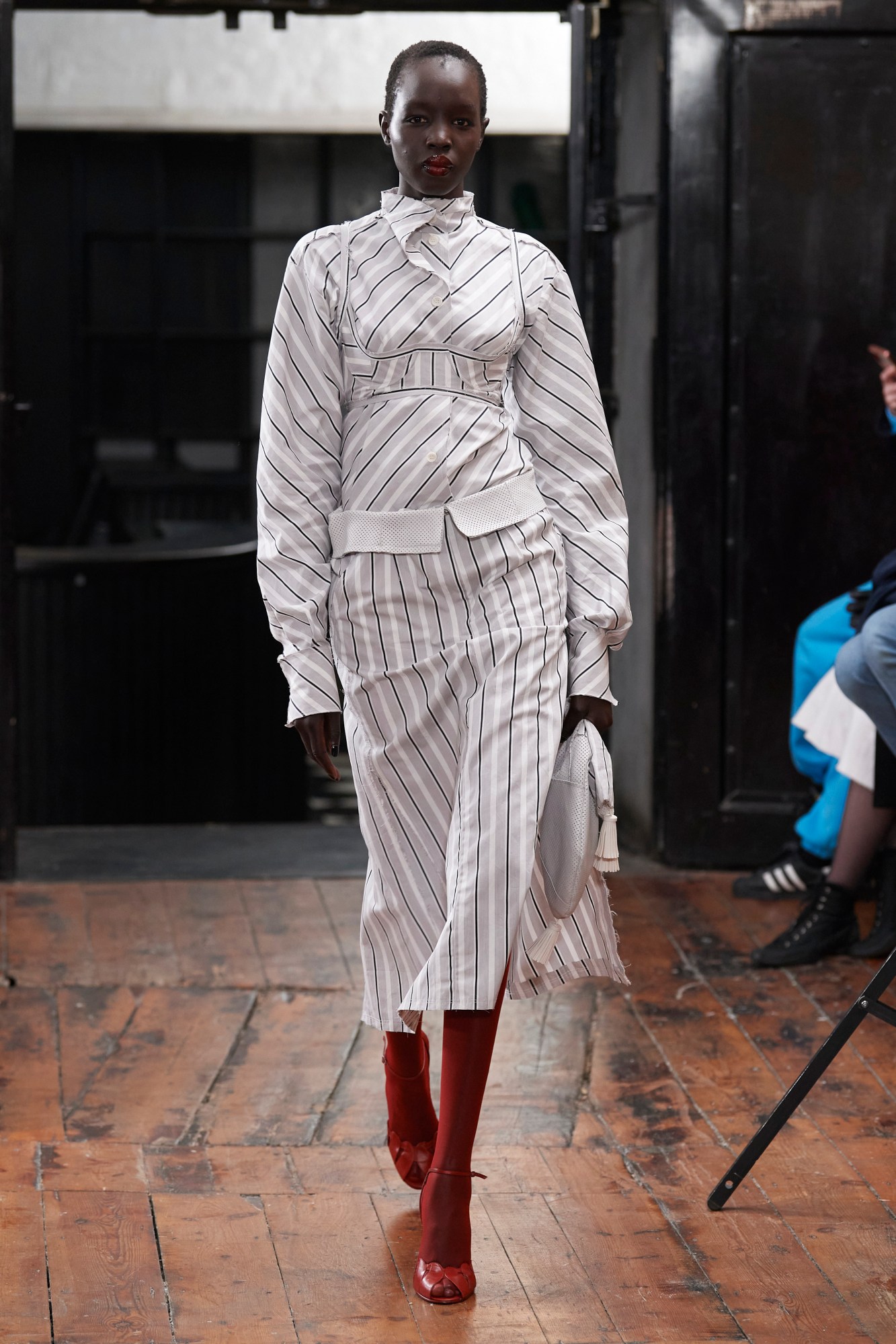


Talia Byre
Talia Byre, we presume, loves a girlfailure. So fittingly, the Liverpudlian designer’s AW23 was a celebration of womanhood in all its gory glory. Models stomped around the intimate setting of Borough’s Lant Street Wines, they followed in the footsteps of the leading women who went before them. Inspired by the women of The Graduate and Funny Girl, the technicolour influence of the 1960s flooded the collection, from screen-printed leopard motifs on wool and cashmere separates, to form fitting maxi dresses in onyx black cherry brown, red tights and chalky lilac poplin blouses. “Who said that life’s all about conformity and wedding bells?” Talia’s show notes asked us. Her AW23 collection was testament to that; this was a celebration of the female anti-hero, a character that’s awful and unrepentant for their awfulness. The carefree, colour-clashing – an ode to American painter Helen Frankenthaler’s colour palette and pioneering work, Jacob’s Ladder – and the fearlessness of each piece was the designer delivering a proverbial middle finger to the expectations that come with tradition. For the finale No Doubt’s seminal angry-girl classic Just A Girl blasted from the speakers, but it could just have easily have been Taylor Swift. These are, after all, clothes for women who don’t mind saying: it’s me, hi, I’m the problem, it’s me. RL
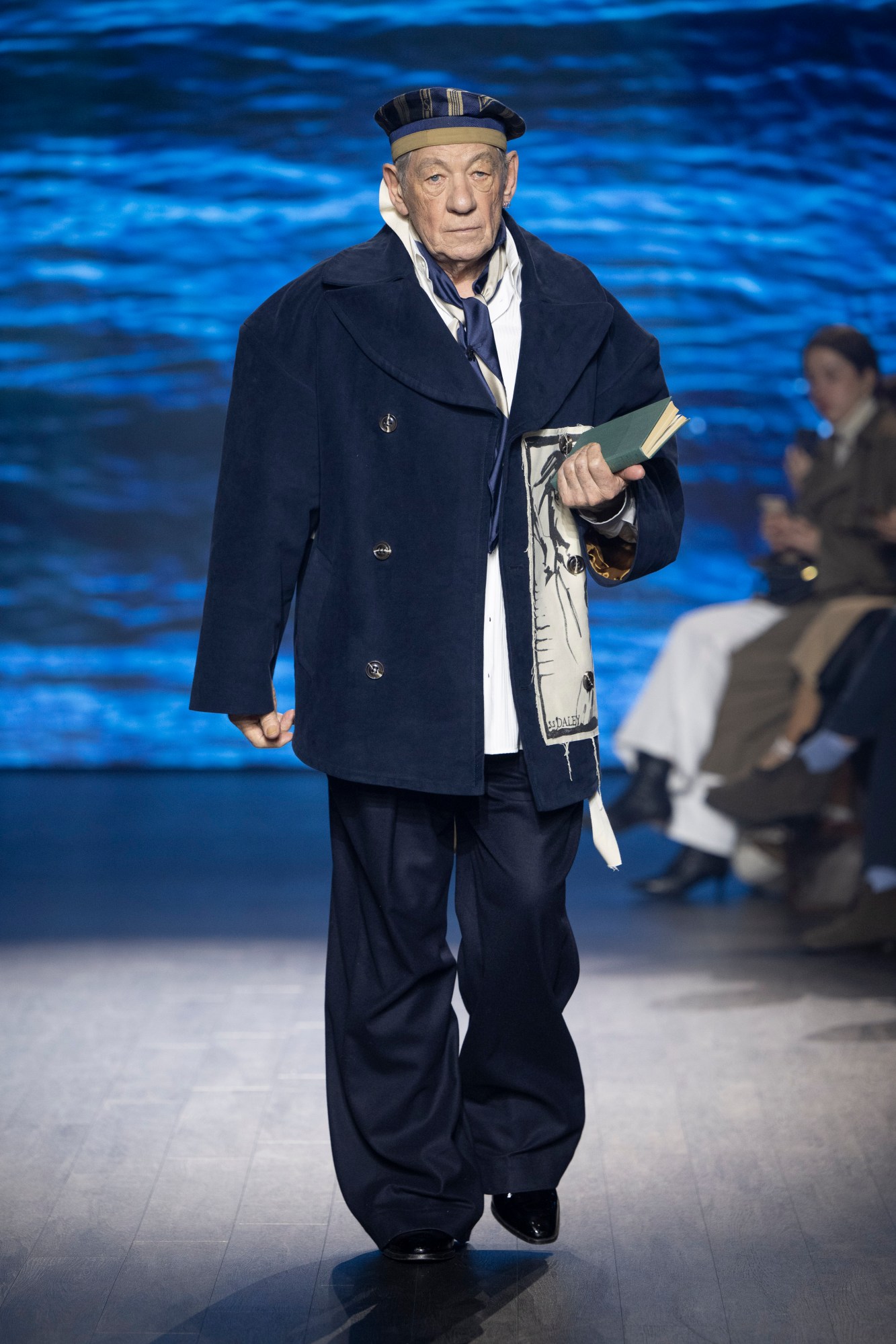
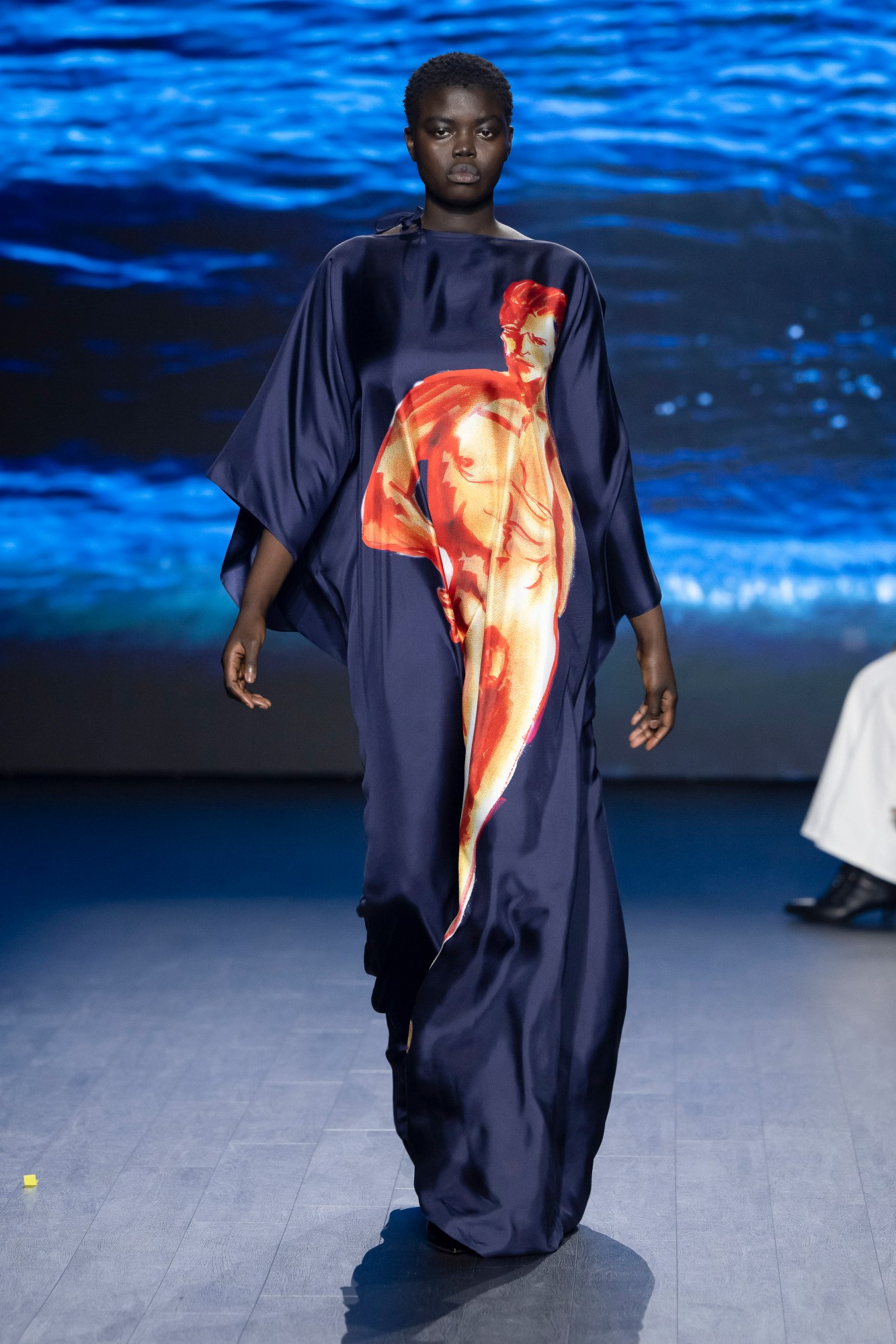
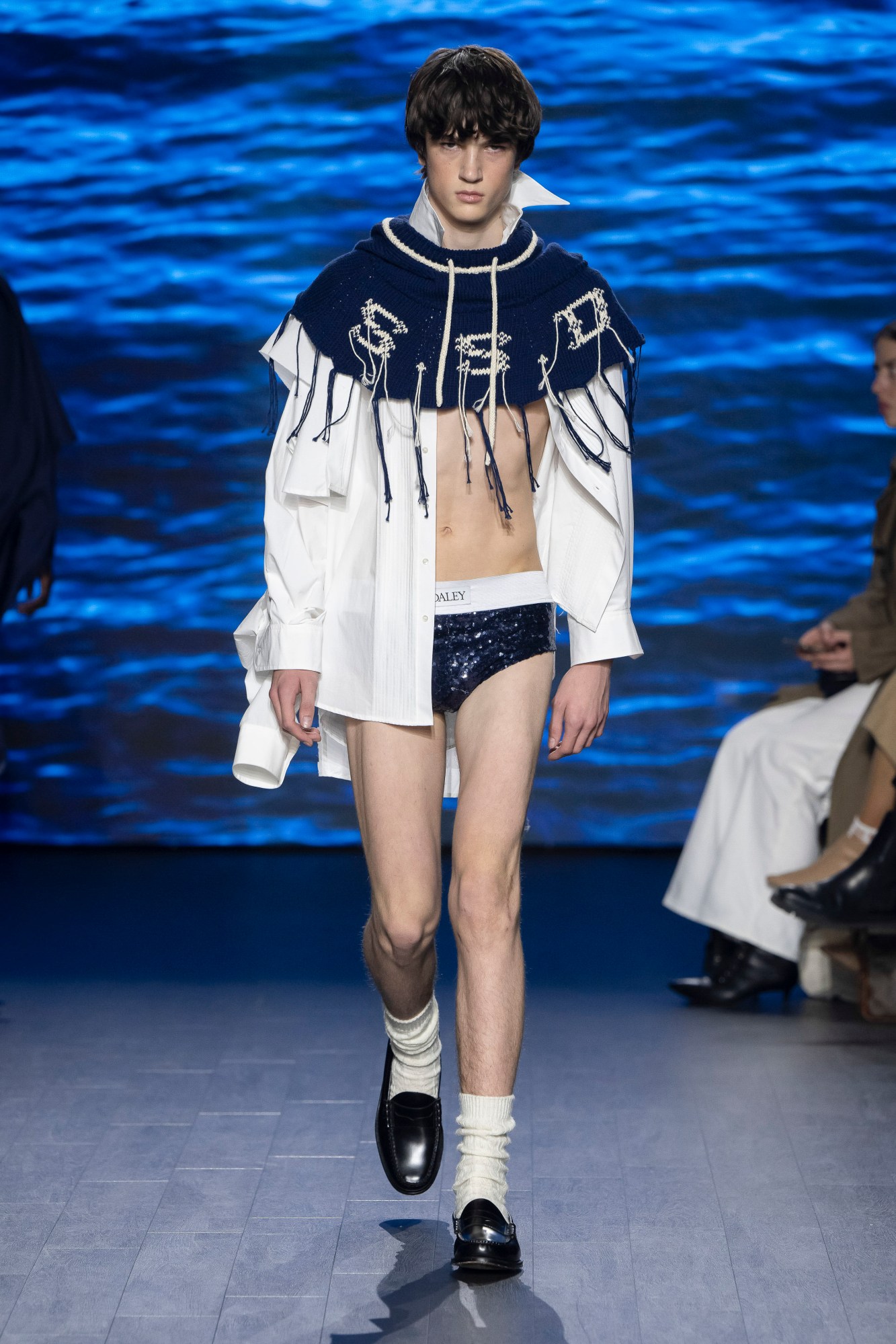
S.S. Daley
After winning both the LVMH prize and the Emerging Designer Prize at the British Fashion Awards in 2022, it was a bold choice for Steven Stokey Daley to change things up and set his sights for his brand S.S. Daley on new horizons. But it worked! Inspired by Kate Bush’s The Ninth Wave – a collection of songs itself inspired by a poem from Lord Alfred Tennyson that sat as a b-side to Hounds of Love – as well as the discovery of his great grandfather’s time at sea, Stokey Daley brought a collection of shipwrecked nautical pieces that were a slight departure from the twee aesthetics he’s become known for.
Opening the show was Sir Ian McKellen, reciting the aforementioned Tennyson poem wearing a navy peacoat with a drawing of a male lover attached, literally kept close to his body while out at sea, along with matching wide-leg trousers and a silk sailor’s hat and scarf. The queer vibes continued across sequined briefs and boxer shorts paired with shredded knits with dangling threads, as if the model’s clothes had disintegrated under the sun stranded on an island; shirting and gowns decorated with orange-toned male pin-ups like a gender-swapped version of the popular tattoos; and frilly shorts belted by ship bunting. There were still some of the usual S.S. Daley signatures here, too – singlets with tied-key-hole detailing and knits with cutouts, stunning animal prints embedded or quotes from the inspirations of the show – but there was also an expansion into technical clothing with a gold and blue striped cagoule with an asymmetrical zip and silk lining, as well as lieutenant pocketed cargo pants, both with cute rope tie detailing. Steven may be on a winning streak right now, but this collection showed he was still ready to traverse, and even conquer, new waters. TG
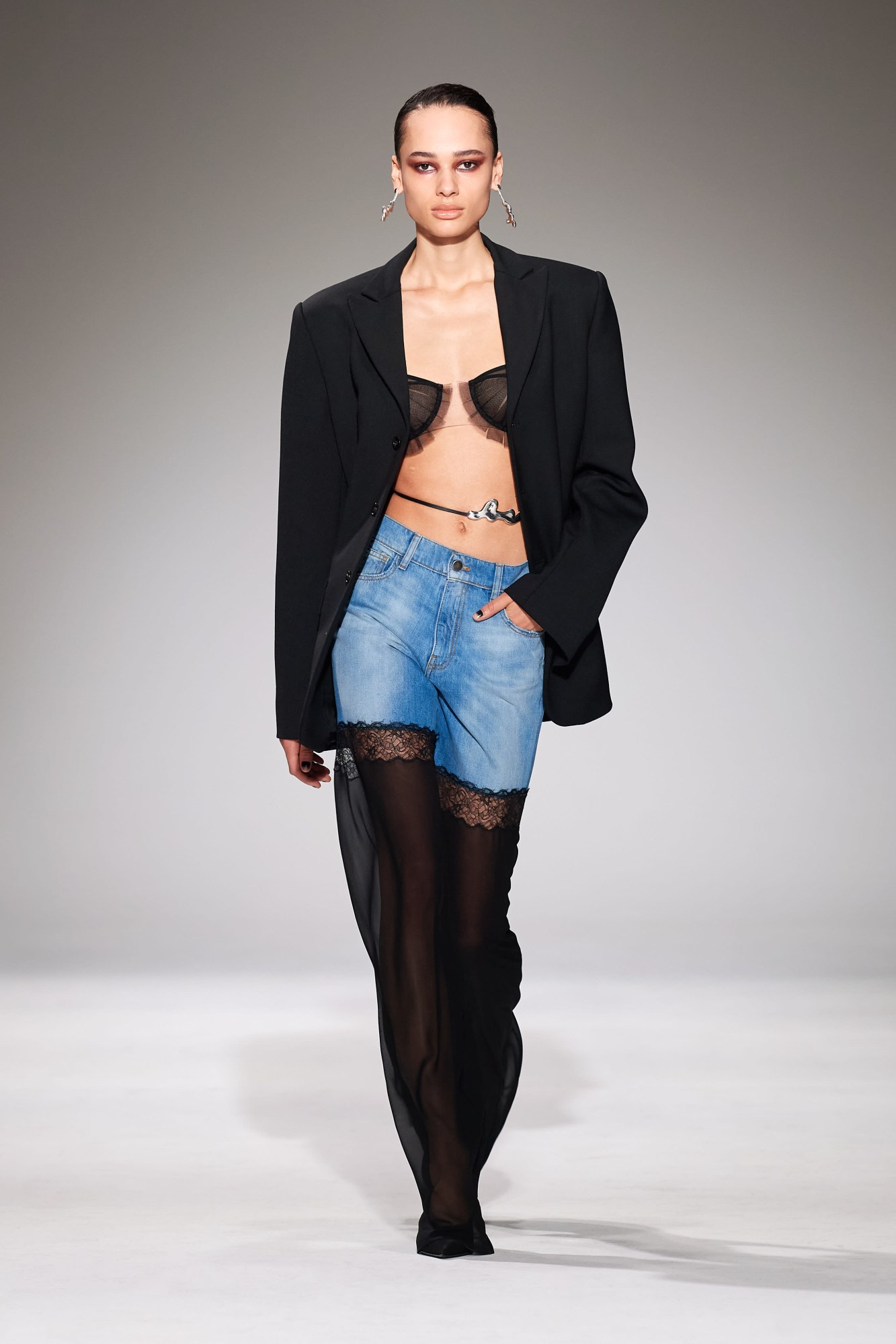

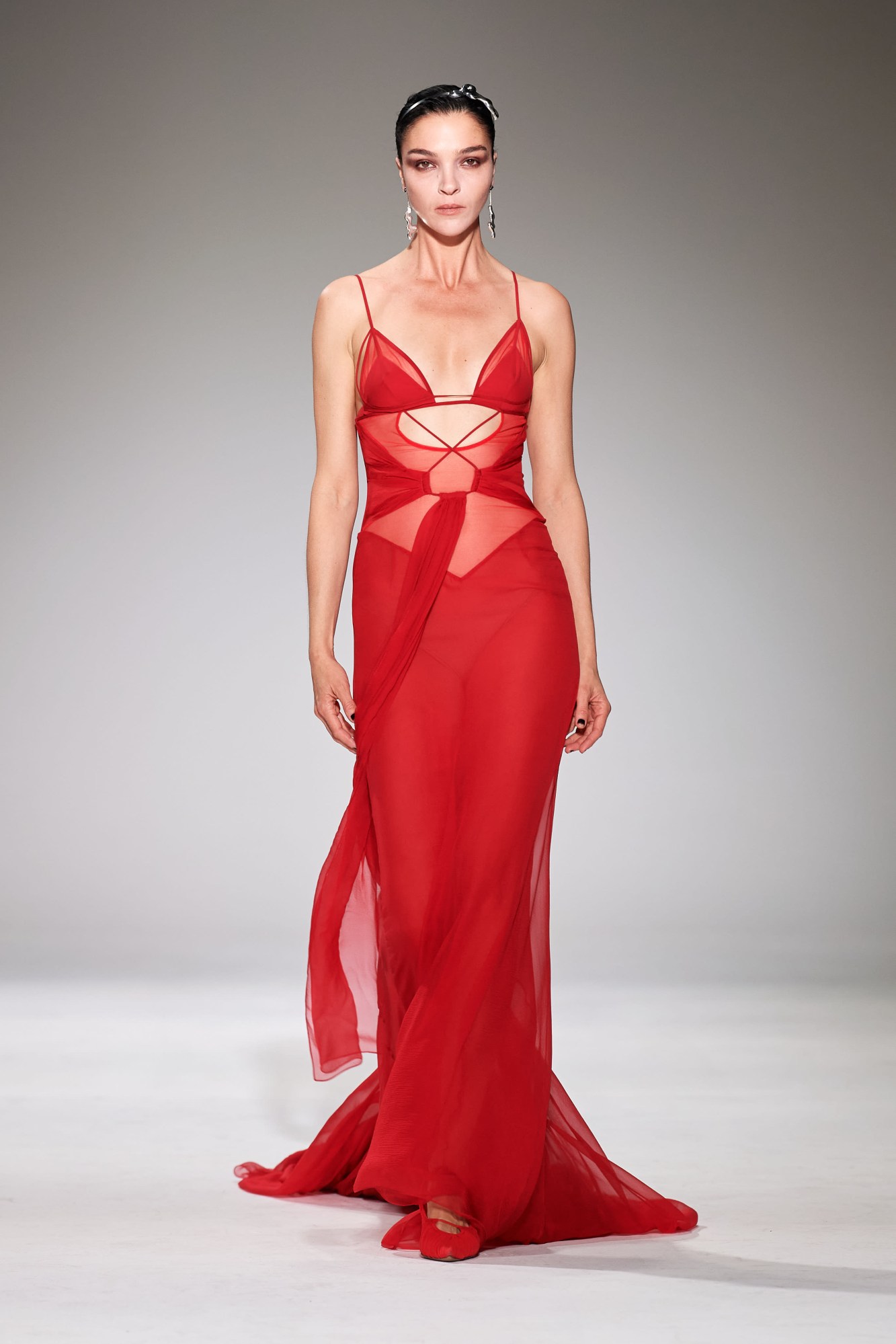
Nensi Dojaka
Over just four years, Nensi Dojaka has made a name as a key protagonist in the resurgence of slinky womenswear, whipping up confections that venerate and empower their wears with sheer scrims of jersey, chiffon, silk and tulle. This season, rather than reinvent the wheel that she has helped to create, she reiterated her mastery of all things sheer and strappy, building on her tried and tested formula and looking to a perennial source of inspiration for her latest collection: flowers. A flounced scarlet silk crepe minidress and the underlay of a diaphanous knitted sheath gown featured assymetrical, petal like cutouts that framed the bust, and frills of tulle bloomed from bra cups and technical lycra leggings. Elsewhere, Nensi’s trademark intricate spaghetti-strap scaffolding could be seen on geometrically panelled evening dresses that cleverly fused the delicacy of lingerie with the svelteness of a red-carpet gown, an ethos that also informed a Swarovski spangled naked dress. MS
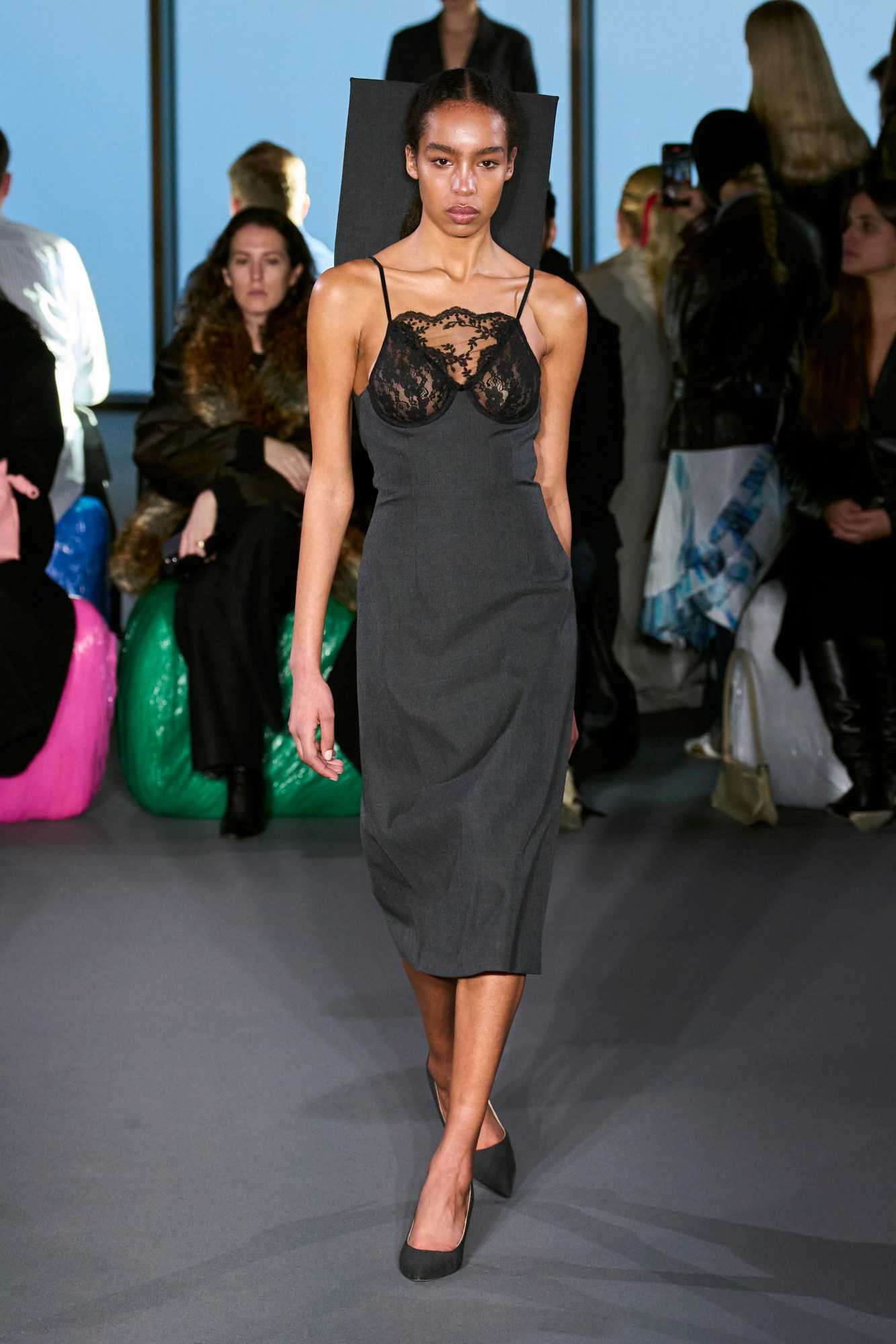
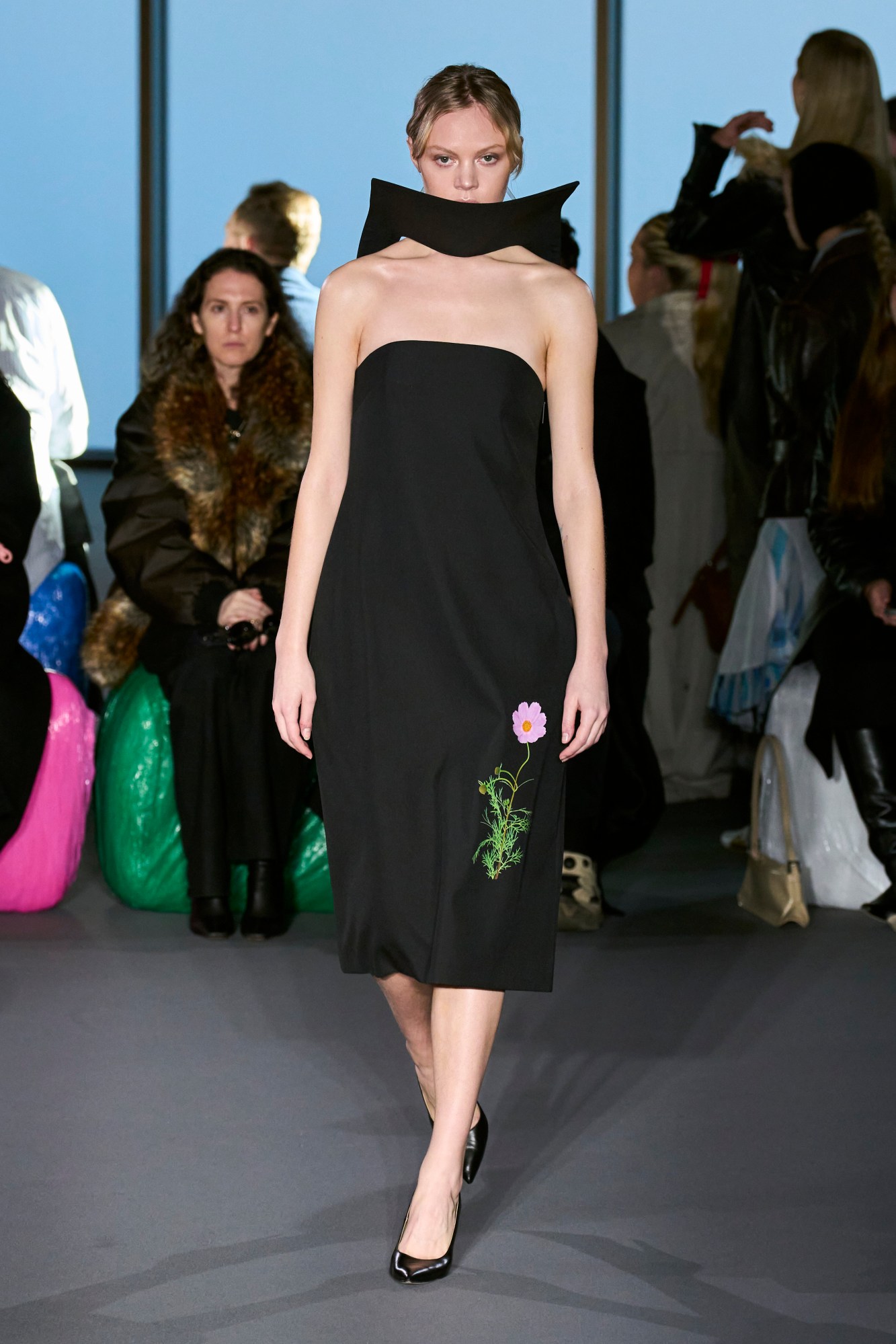
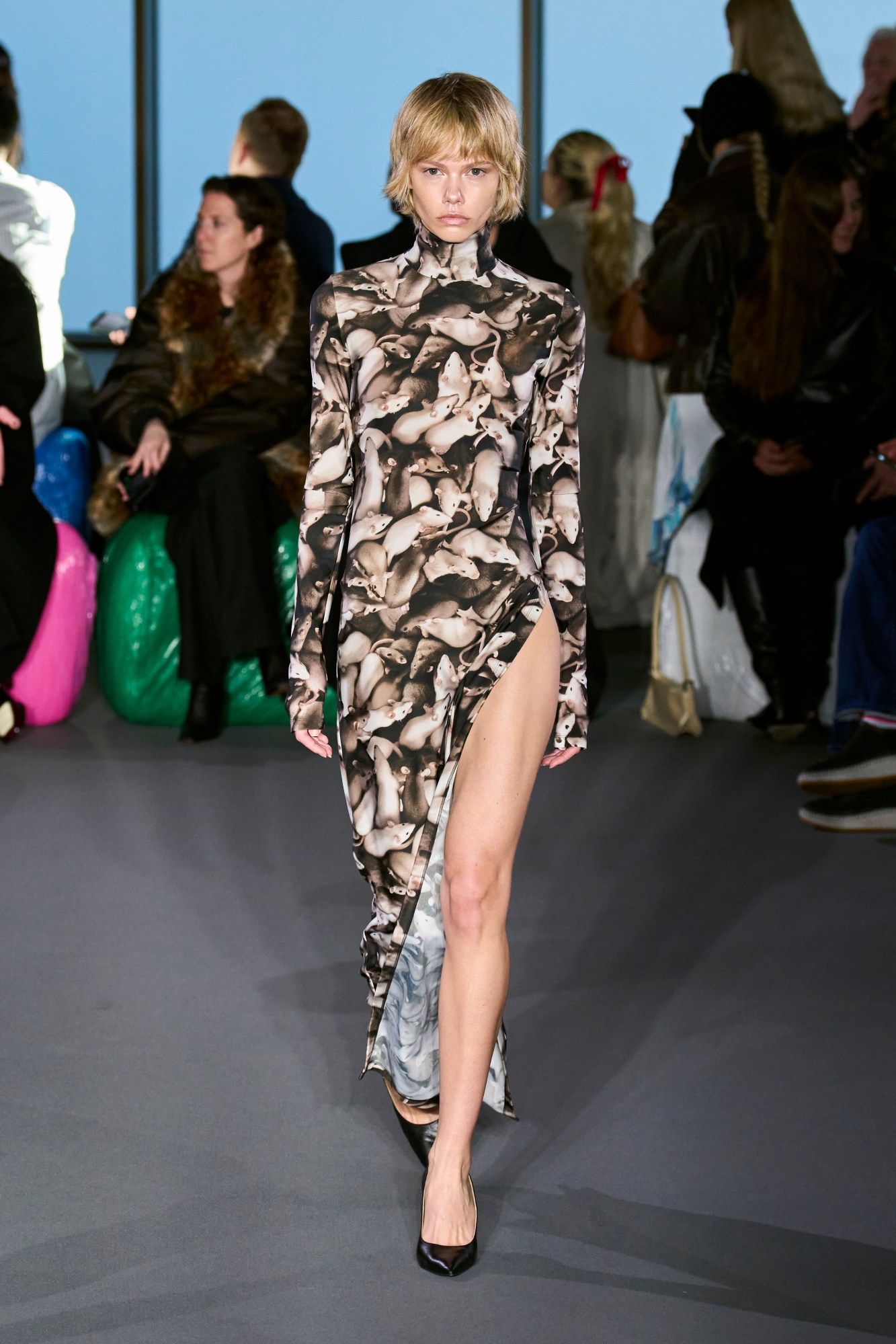
Christopher Kane
What do piglets, mice and chicks have in common? They’re all “working-class animals,” according to Christopher Kane, who drew on them for A.I.-generated prints in his latest show, an homage to the Glasgow-born designer’s memories of the outfits worn by his mother, aunts and neighbours in the 1980s: the uniforms of waitresses, housewives, cleaners and bartenders. With guests perched on humble hay bales wrapped in brightly-coloured plastic, there was a mood of down-to-earth humility in the air. The show opened with uniform-like grey and navy dresses, albeit with pin-sharp silhouettes and sculpturally stiff geometric upstanding collars that he later called “chopping boards”. Indeed, this was a show that looked to the mundane. Some of those dresses came with floral motifs, but not the usual wildflowers or romantic roses — they were the unassuming urban kinds that grow between tiles that you rarely even notice in the city. “I never go for the beautiful flowers,” he explained after the show. “I always go for the working-class flowers. Really humble. They’re always just trodden on.”
What was clear was that Christopher was toying with the unexpected, once again looking to his own biography as a wellspring of references to be elevated into high-concept sartorial experiments. Ruffled bustles on skirts resembled fastened bin bags, placed at the front and backs of streamlined tailoring and pencil skirts. “They were meant to be intestines at the front, unravelling, and then it became an intestine bustle,” Christopher added. “Then it was almost like waddle, like duck waddle, waddling along like a black swan, an ugly duckling.” His mission is to create a wardrobe that feels slightly disturbing, perverse even,“for those who desire clothes that challenge sartorial tastes and standards,” as he put it. Here, the mundane and banal was elevated into something intellectual and beautiful. Make no mistake: these are interesting clothes for interesting women, and more importantly, a celebration of working-class Britain at a time of widening disparity between social classes. “Life is beautiful for some more than others,” a voice on the soundtrack repeated, along with the sound of a purring cat. Christopher’s collection made it clear that there is beauty to be found in the everyday life of so many working-class people in this country, which is a beautiful idea in and of itself. OA
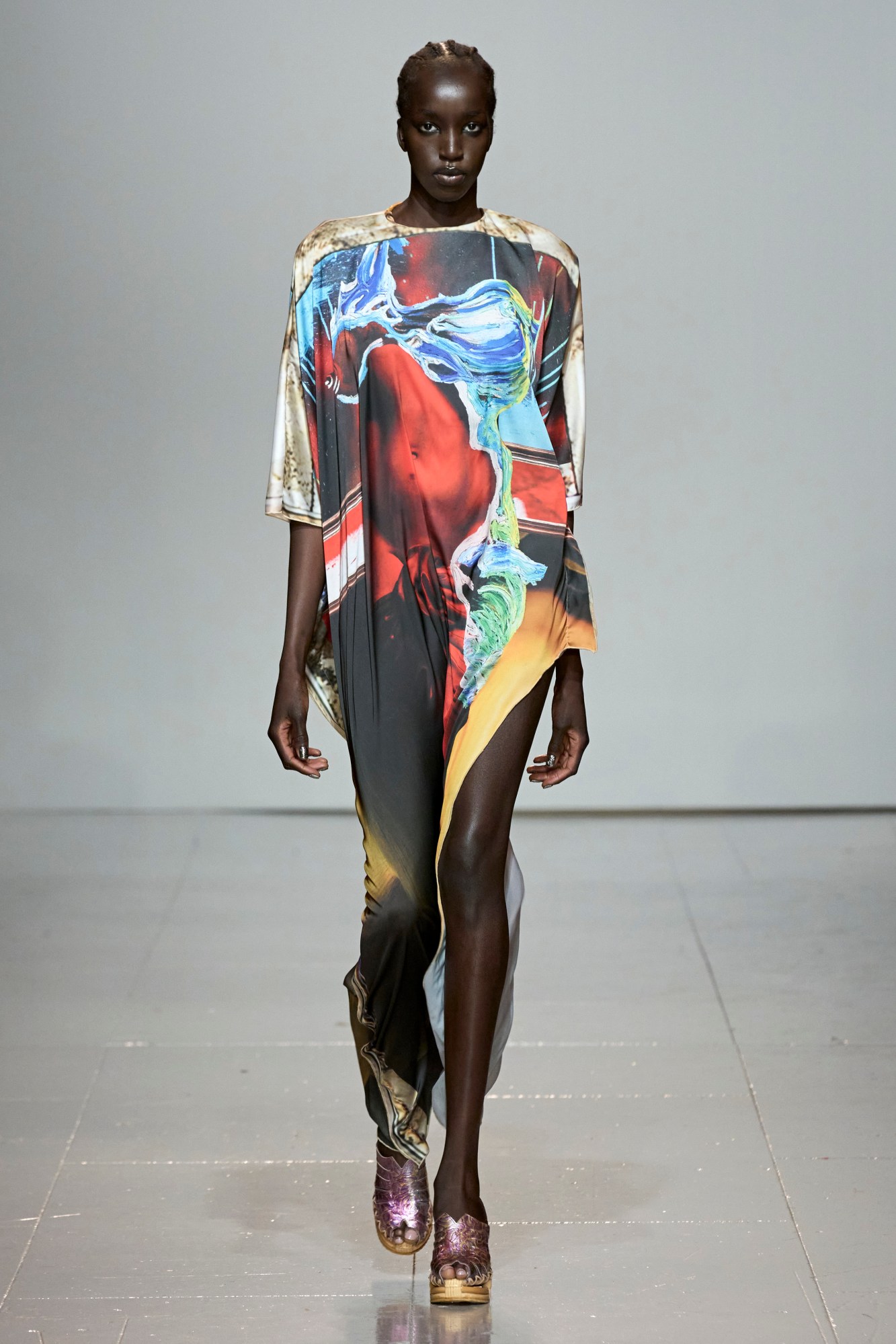
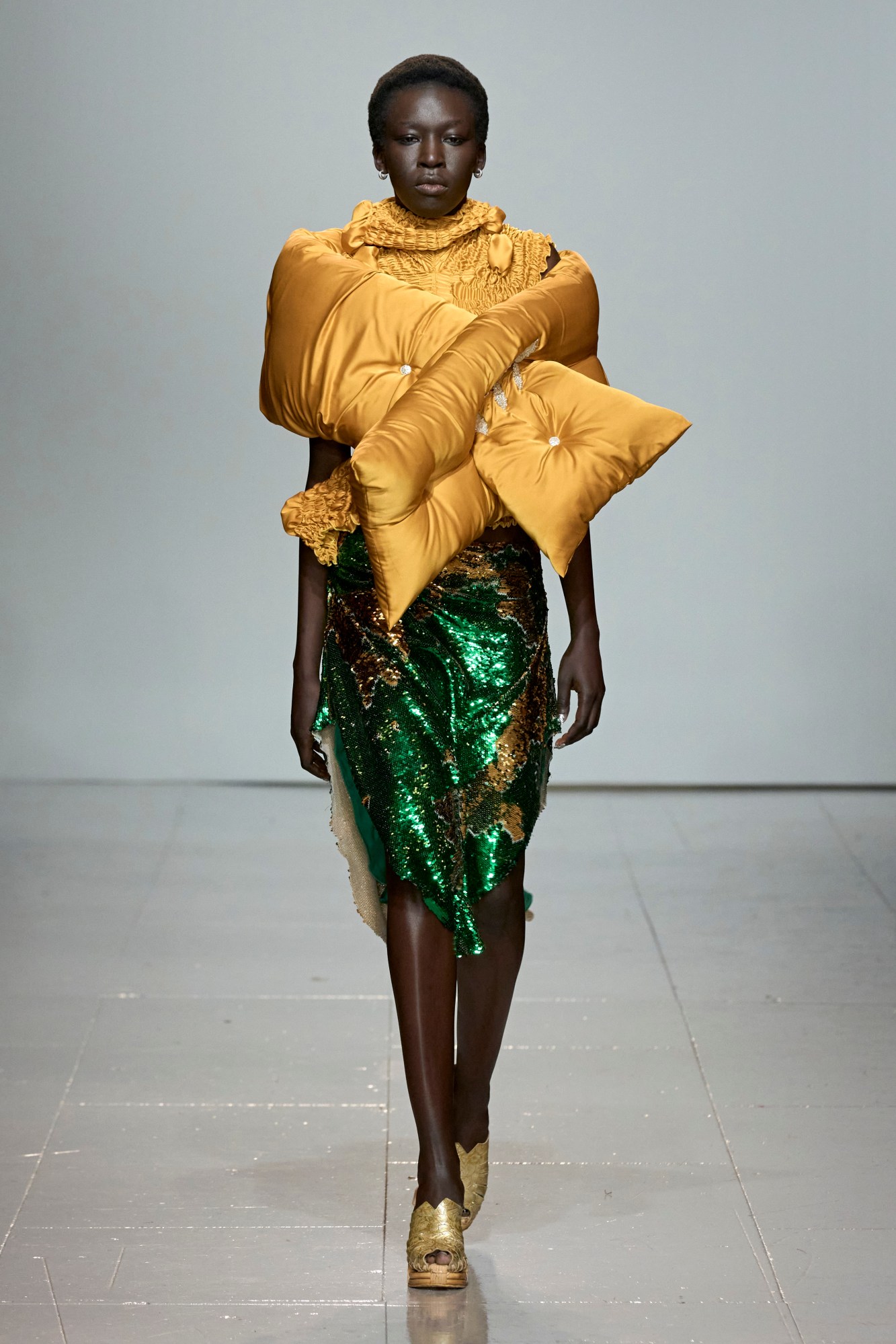

Feben
No one needs telling that times are currently pretty damn tough, but one thing we do need, though, are clothes to see us through them. For her AW23 collection, Scales, Feben offered her interpretation of outfits of protection. Rather than a straightforward, armoured vision (though granted, notions of armour did inform this season’s shimmering drapes of green-gold sequined chiffon and the chainmail knit of a column dress), her sophomore runway collection built on the notions of contrast and juxtaposition that have informed her work to date, finding strength in unexpected niches.
Deepening the exploration of tarot that was first introduced last season, Feben chose to focus on one card in particular, The Chariot – a cipher for the power to be found in moving onwards, and the importance of accepting one’s innate contrasts in doing so. Severe tailoring was counterposed by gowns with swooning drapes that implied romance and tender vulnerability. Iterations of the designers signature twist dresses – bobbled column-like sheath silhouettes crafted from yards of undulating satins – were punctuated with hard metal tokens. They also figured on a cropped padded bolero, appearing like bullets caught in protective gear, their wearers striding on with poise and grace. MS

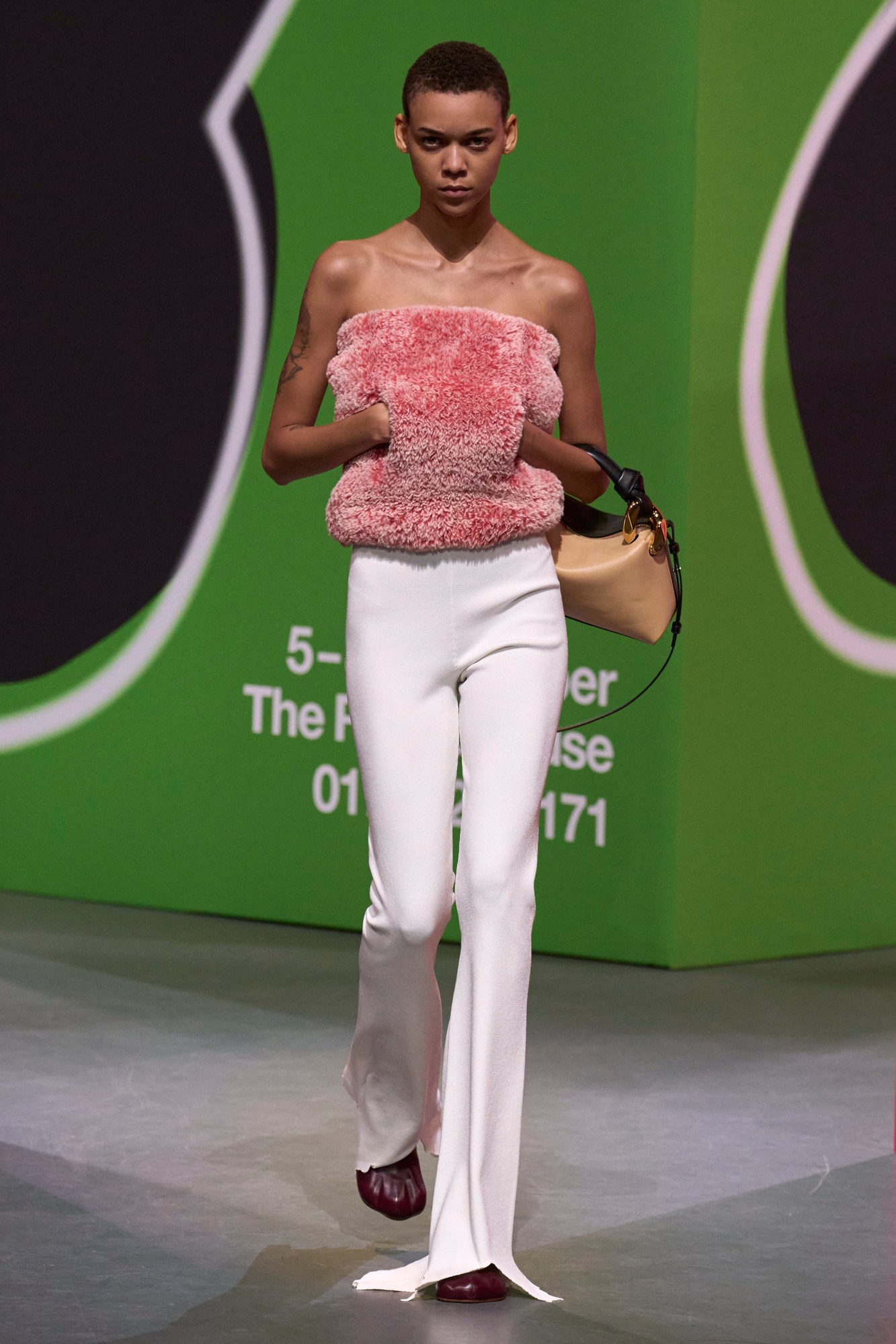
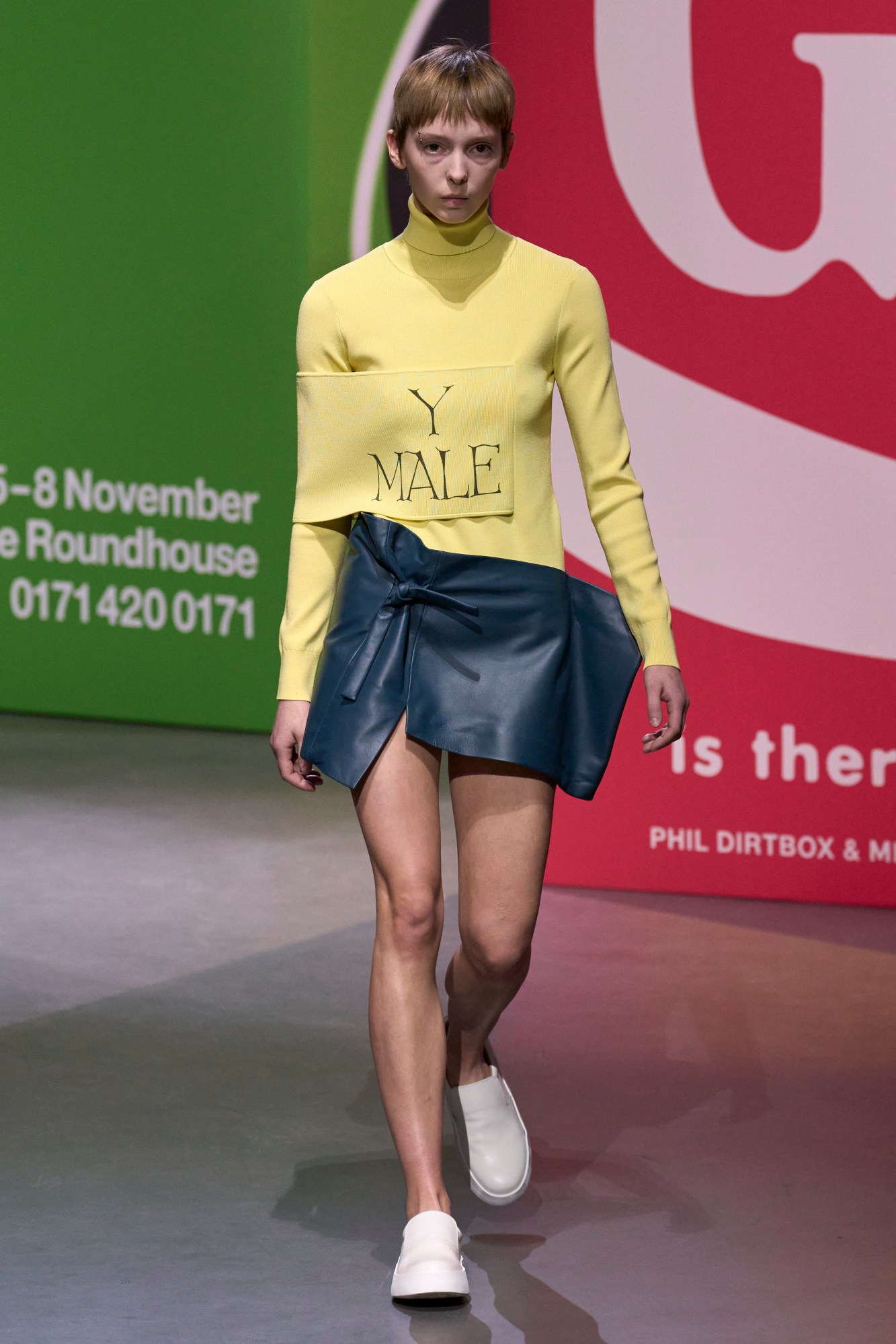
JW Anderson
Review to come.
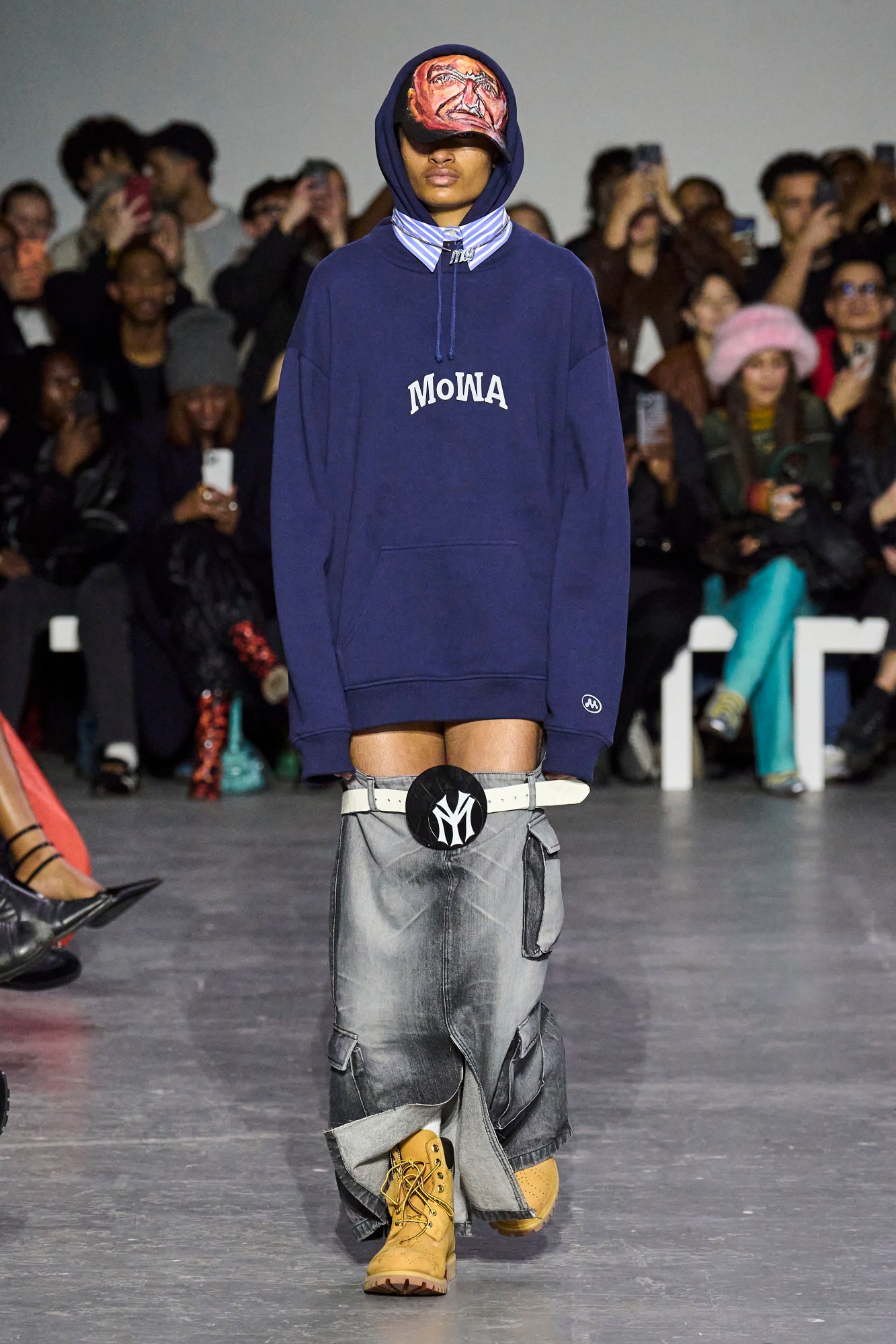

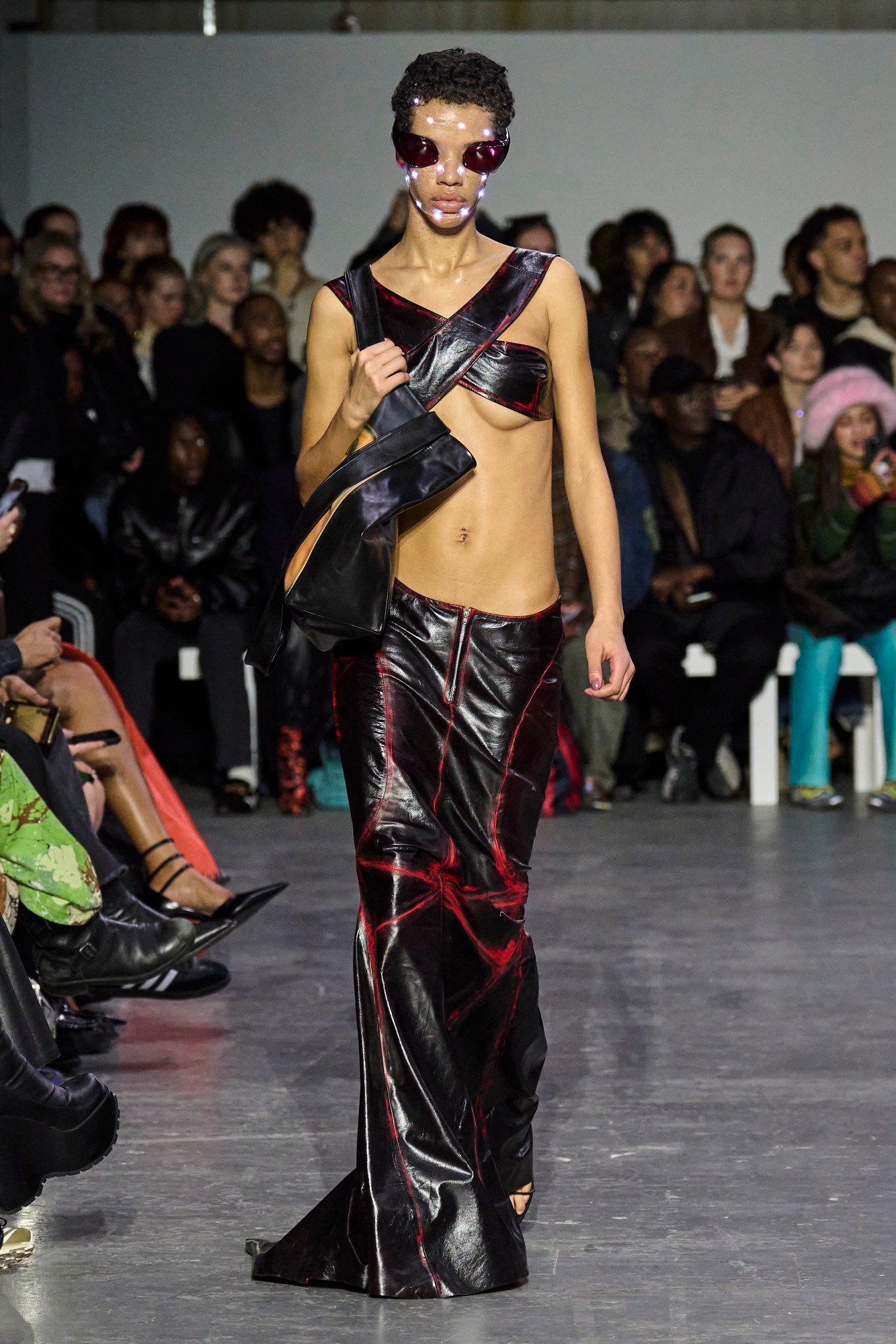
Mowalola
If there’s anyone who could pack a show in London to the rafters at 10pm, it’s Mowalola, and last night that’s just what she did. Showing her first full collection in the city since her Fashion East days, the designer fielded a red-pilled (in the OG Matrix, rather than the contemporary political sense) collection that explored our tumultuous relationships with technology — how we’ve basically become slaves to the algorithm, and businesses that build them. Such apocalyptic ground is, of course, natural territory for Mowa — who, back at the beginning of the pandemic, expressed her dismay at how boring the reality of what seemed like the end of the world actually was — but for all the collection’s nihilistic thematic undercurrents, this was perhaps one of the designer’s most accomplished bodies of work to date. Set against a backdrop of bootleg copies of New York’s cultural iconography (where better, after all, to situate the collection than global capitalism’s beating heart), hefty denim and columnar silhouettes in black ponyskin — often featuring face coverings and reverse-wraparound bug-eyed sunglasses — converted a sense of sinister, at-times fetishistic, corporate flair. Louch hoodies and biro-scrawled leather bombers suggested a dissident hacker-ish spirit — a generation of feisty rebels challenging the status quo, of which Mowalola is certainly a part. The cherry on top, though, was the abundant return of the designer’s hyped leatherwork, longline macintosh coats featuring trompe l’oeil body prints, skirts cut to look like they were caught falling down about the knees, bandeau tops and skirts, and trousers with windowpane cutouts. After all, if the end of the world is nigh, you at least want to look hot when it comes! MS
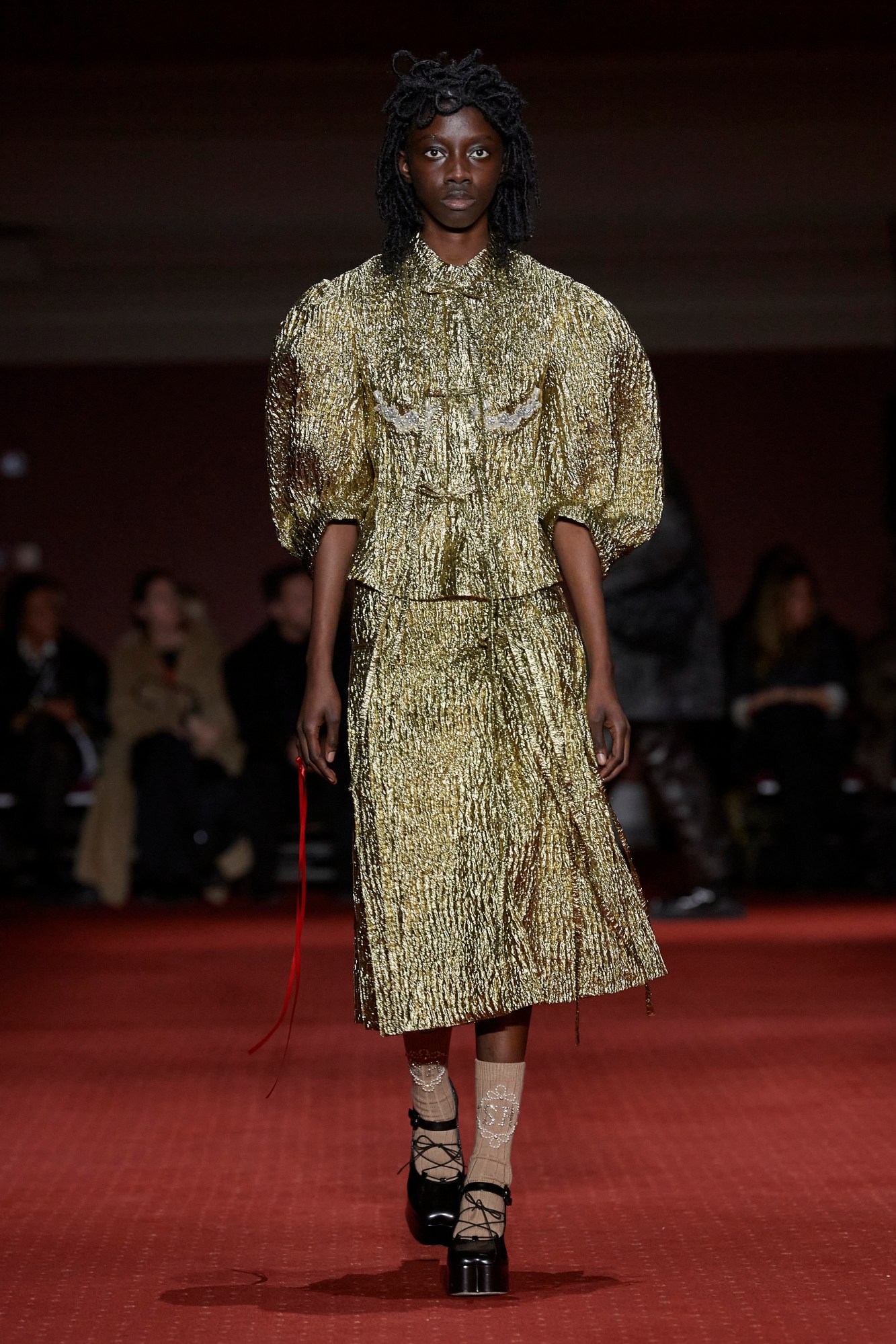
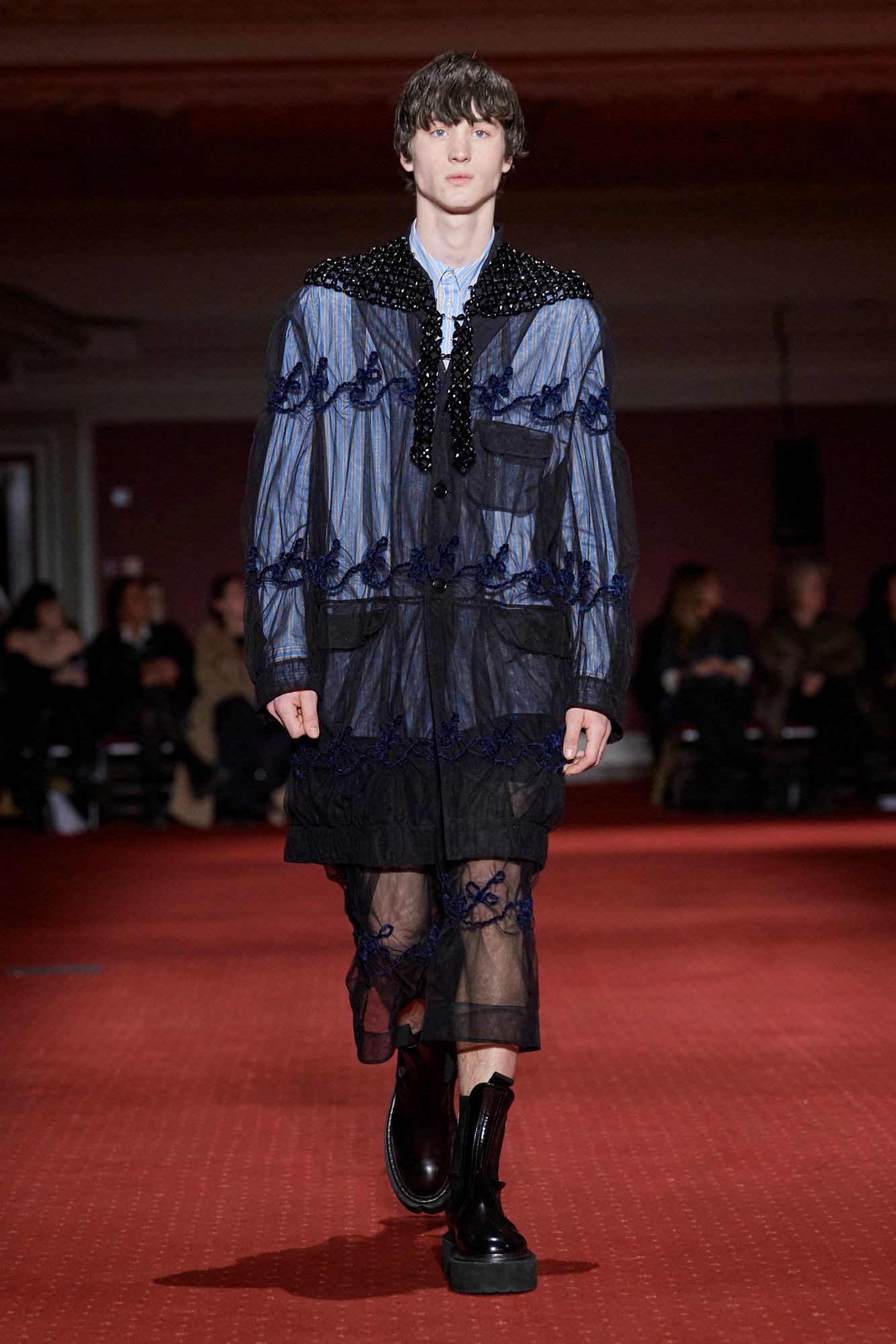
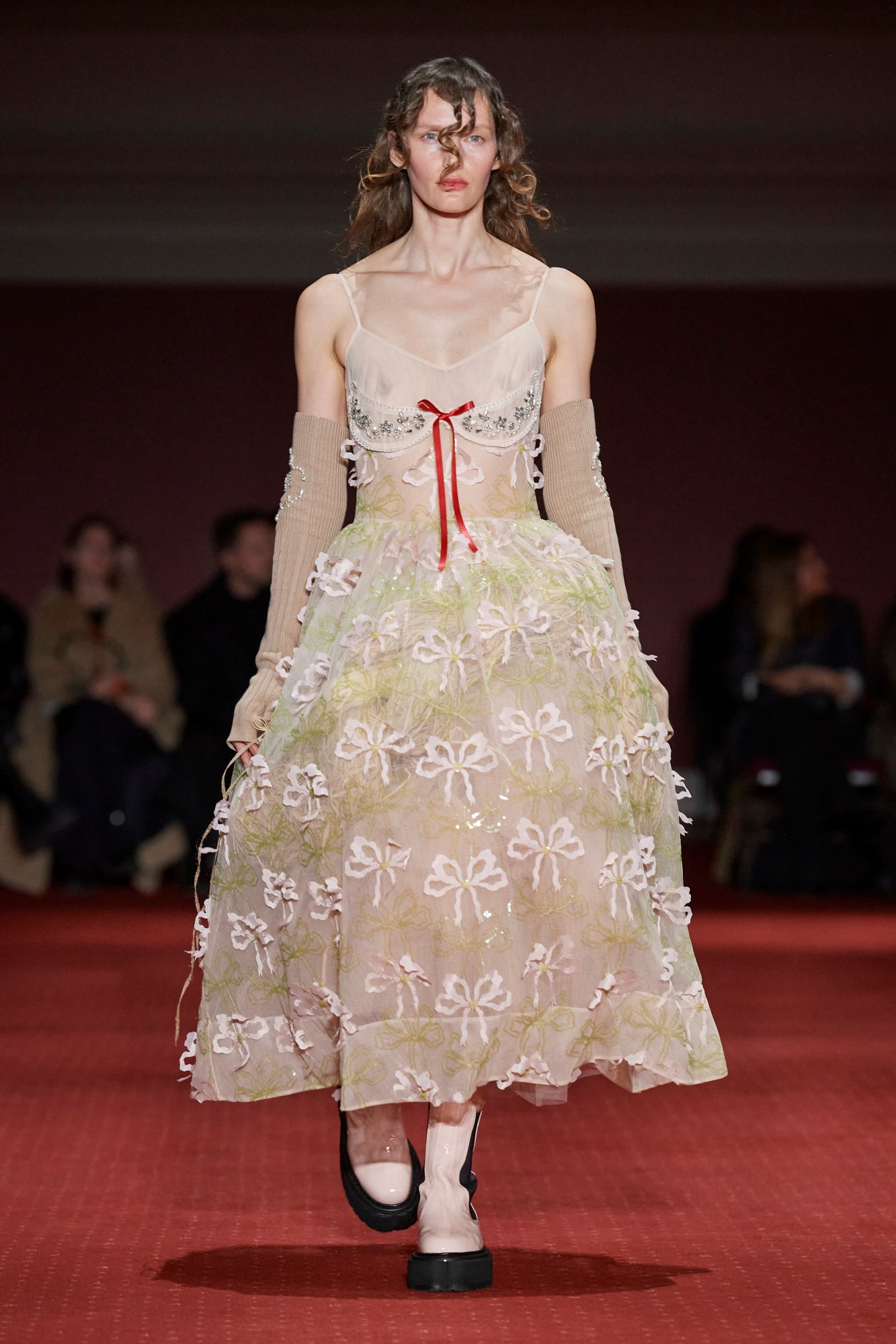
Simone Rocha
Is there a designer more poetic in London than Simone Rocha? Probably not. Simone’s latest collection was, as always, inspired by the folkloric traditions of her native Ireland, specifically Lughnasadh (or Lughnasa), the Irish harvest festival that dates back to pagan times, celebrating the spoils of the summer’s crop with feasting and dancing in the Irish countryside. “I wanted it to feel really grounded, like it was from the earth,” explained Simone, who invited the Irish folk band Lankum to perform live, their droning uilleann pipes and wailing lyrics setting the tone for a collection that she described as “standing stones”. A sense of celebration could be felt in the gold cloqué dresses that opened the show, and the glistening jewels that adorned the dark, boxy overcoats and dramatically bell-shaped bombers.
Throughout, Simone’s trademark sense of romanticism could be felt in the wide ballerina skirts, diaphanous nighties, and layers of sheer lace and organzas topped with macramé collars and Irish shawls fastened at the neck. But this being Simone Rocha, there is darkness to the decorative confection. Red ribbons were tacked onto thumbs and under cheeks, making some models look like they were crying blood as they glacially moved across the blood-red carpet of Central Westminster Hall, while the all-black looks elsewhere appeared broodingly funereal. The organza and lace dresses stuffed with raffia, typically used for harvest bonfires, hinted at an incendiary purpose — a woman about to be set on fire. And the final showstopper? An entirely woven raffia dress, which, though it will hardly fly off the store rails, demonstrated Simone’s towering technical ability and sense of showmanship. You can see why her work is attracting more customers than ever — specifically men. This season marked the return of the menswear the designer introduced last season, even if it felt like they were always there. As with the inspiration, the result was completely organic and natural, a complete cast of characters equally adorned in ritualistic splendour. OA

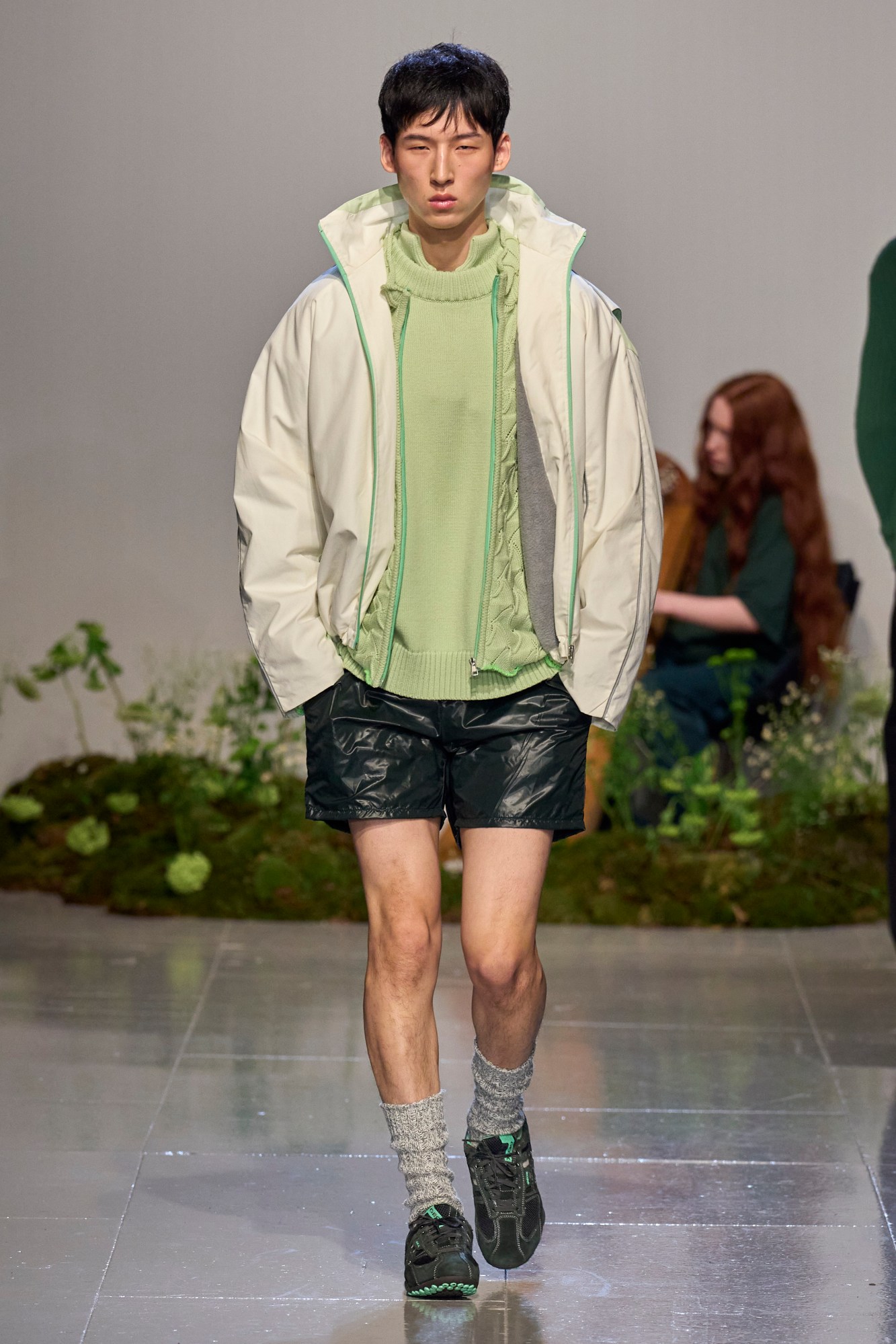
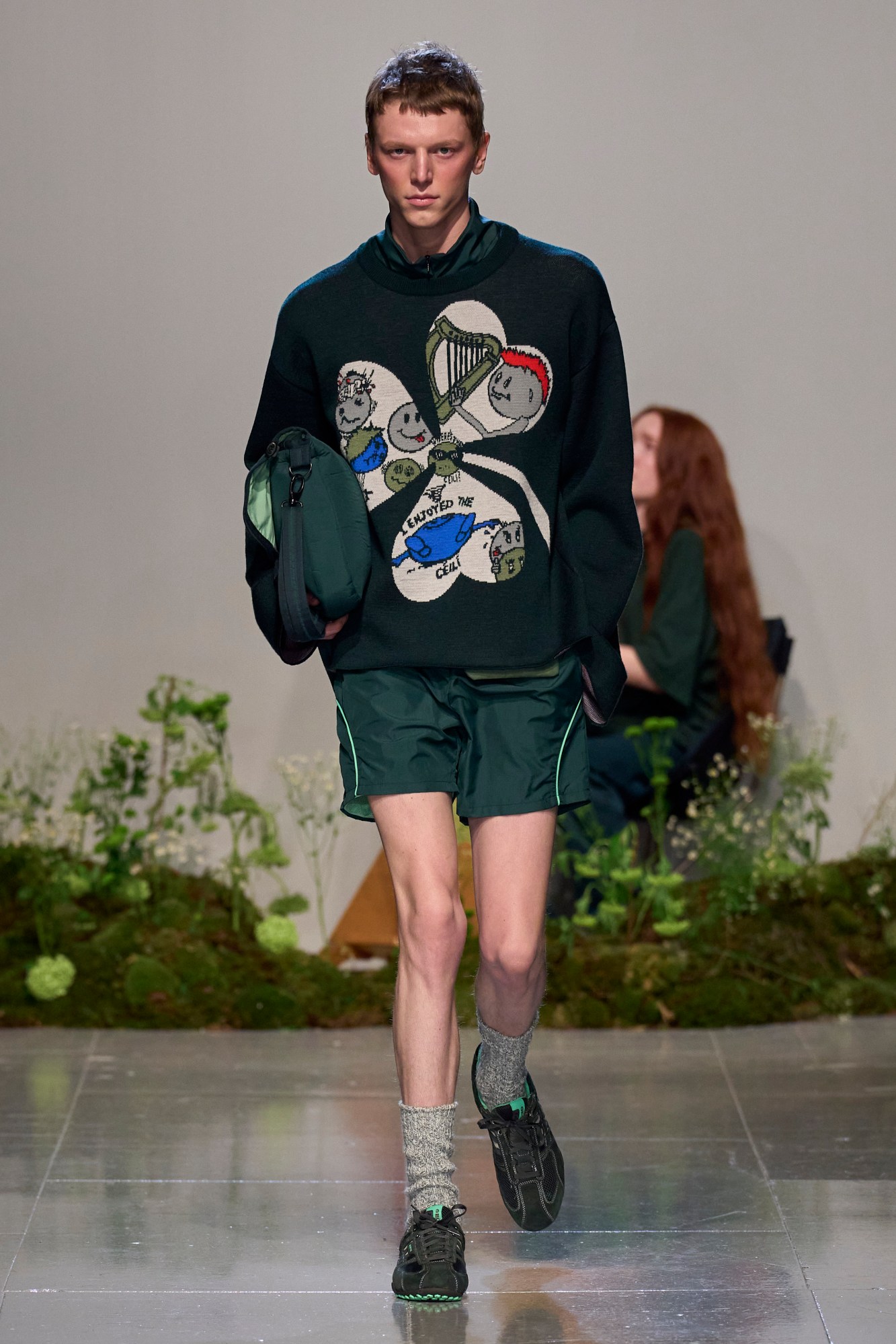
Robyn Lynch
Robyn Lynch loves being Irish. As she should tbh! Being Irish is class! But what we know of as ‘being Irish’ has changed and modernised, and it’s that question: what it means (and looks like) to be Irish today, that the designer aimed to tackle with her AW23 collection. The answer was a gorpcore take on heritage that modernised without losing the playfulness that comes with the associations we have with ‘the Emerald Isle’. Unsurprisingly, there was a lot of green here. Pistachio green, lizard green, sage green, phthalo green. Green, sheep-covered fleeces. Green, O’Neills-inspired shorts, the kind you could expect to see on a wild Paul Mescal jogging through Hackney with a tinnie in each hand. Green holdalls big enough to carry the whole team’s hurling gear (and camogie too). And balaclavas! If the models looked like they would be as much at home trekking across the Mournes (toasty and warmly) than walking the catwalk in Old Selfridges Hotel, then that was intentional: Robyn’s collection was a celebration not just of Irishness but of Merino wool, a fabric that’s been central to her creative process since her AW19 debut with Fashion East. It makes sense! Ireland is cold! The materials reflect the rainy inspiration, with a focus on Merino as a fully biodegradable, uniquely versatile source. Merino jacquard jumpers callback to 19th Century Irish ceili dances, while ocean waste-recycled Seaqual nylons, all custom dyed (guess which colour) brought the collection back into the 21st century. The soundtrack, as much as the clothes, were a celebration of what it means to be an Irish woman today, and Robyn’s take on the trope of the “strong Irishwoman”. Emerging musician Róisín Berkeley framed the runway, performing a custom track for the occasion on her own harp. For the finale, the models emerged walking fast – Irish people walk fast! – to Sinead O’Connor’s Mandinka. Hup the Robyn Lynch boys. RL
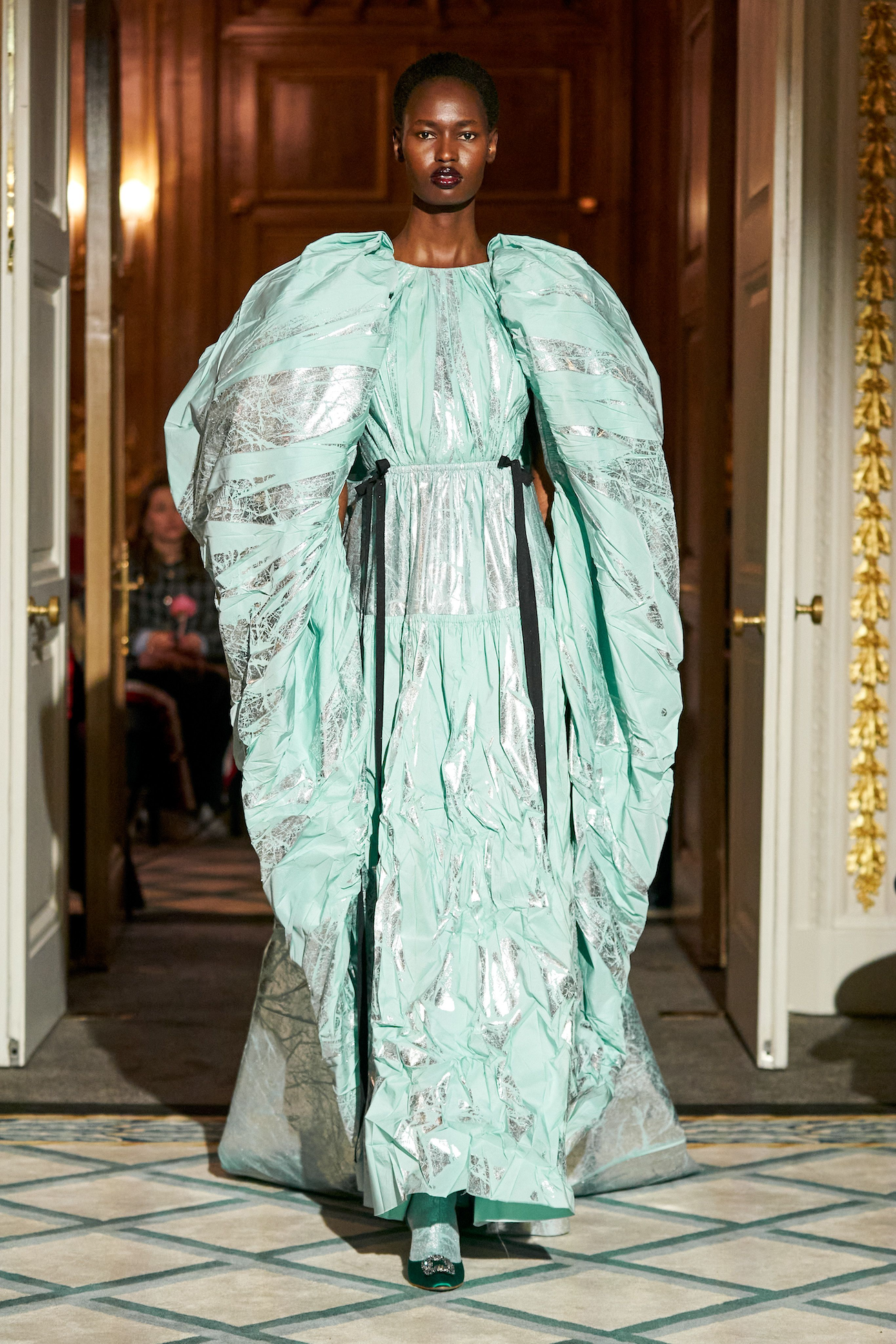
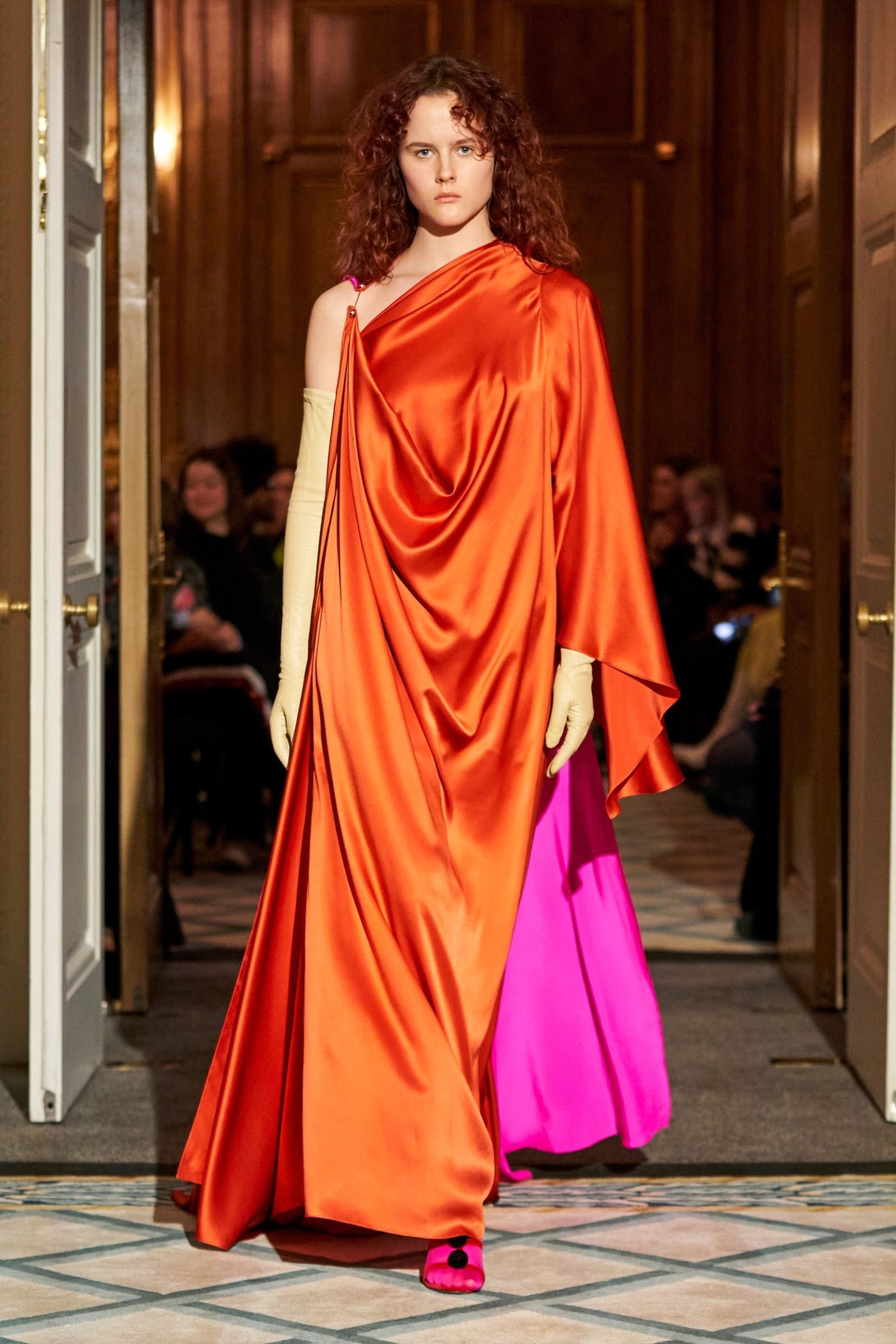
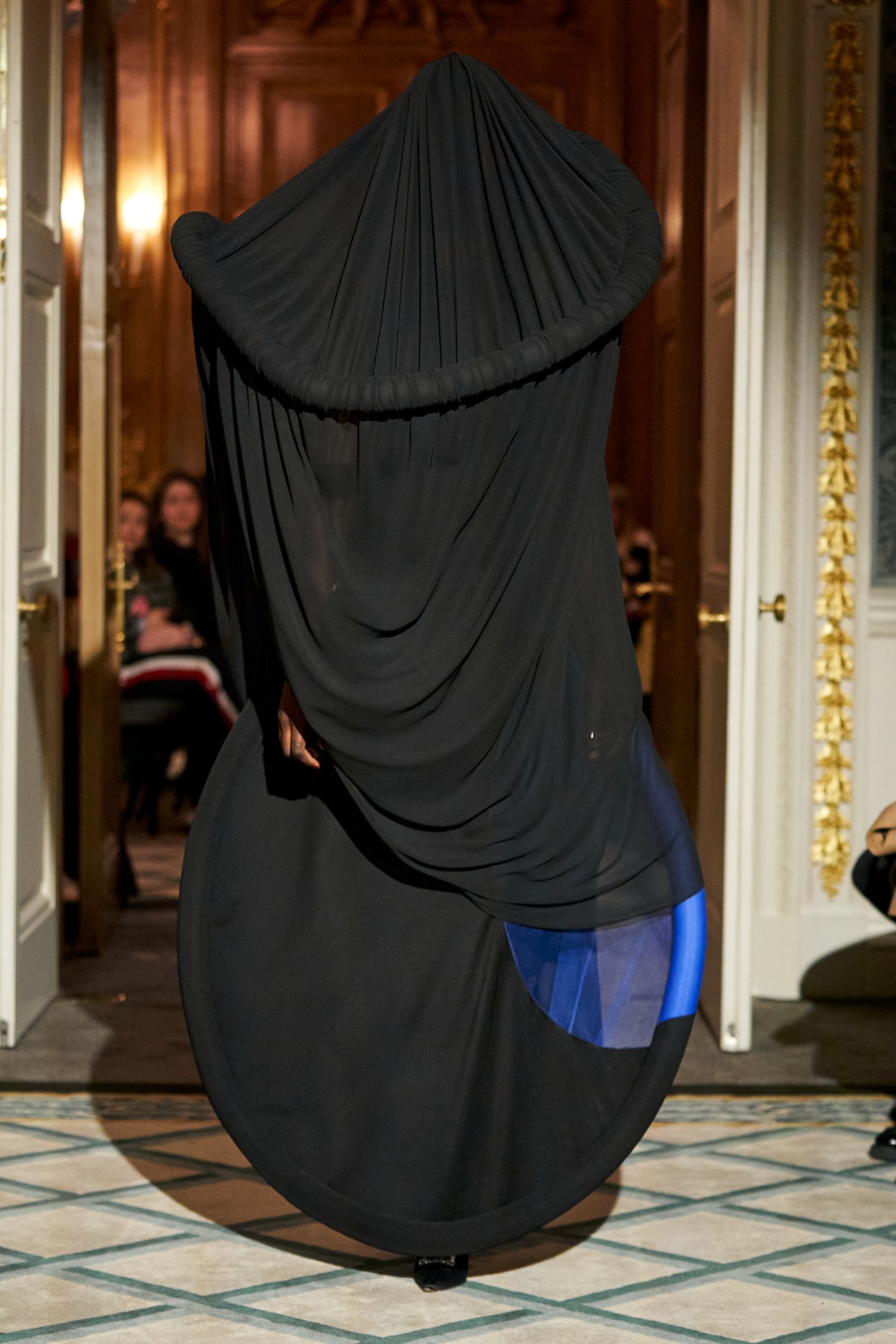
Roksanda
For AW23, Roksanda dared to ask the question: what if Brideshead Revisited was set in outer space? As ethereal models drifted around the art deco room in jewel-toned gowns, the poet Arch Hades recited Silence, The 4th Canto. Taken from her latest work, Arcadia, the poem was a reflection on beauty, silence, solitude and sensation. “Life’s great pleasure is pure sensation”, Arch told us, “to feel that we exist. To live each season as it passes and continue to persist, to breathe, to taste.” The brand (and the poet) were telling us to slow down, to put down our phones, to pause for a moment from the breakneck speed of modern life (and fashion month!) and really indulge in the pleasures of being alive. The clothes reflected that sensuousness, that pleasure. Draped gowns and long gloves in sumptuous metallics, pinks, yellows and sapphire blue. The models moved languidly, letting the drapery, towards the end of the presentation, the increasingly otherworldly construction of shapes, linger with us as they moved from room to room. This was a collection — and poetic performance — that at heart was about deciding your own path and pursuing it unapologetically, about finding meaning in absurdity and contradictions. Nihilism came to Claridges for the afternoon, who’d have thought it! Taking inspiration from the Japanese visual artist Atsuko Tanaka, the trompe-l’oeil effect of the increasingly outlandish structures, set amongst timeless, luxurious and delicate dresses and capes, mirrored the themes of the collection: the harmony and coexistence of opposites, of strength and fragility. Ultra feminine silk and organza swirled alongside gravity-defying, ultra modern abstract creations, representing a meld of beauty and technology. Volume was taken to new extremes, lifting from Atsuko’s famed ‘Electric Dress’, with exaggerated proportions and angles. Soft nappa leather accessories in the Serbian designer’s unmistakeable colours were reconstructed too, made weirder, more modern. The shoes, throughout all this, were classic Manolo Blahnik courts. Because even in the depths of absurdity and outer space: they have Manolos. RL

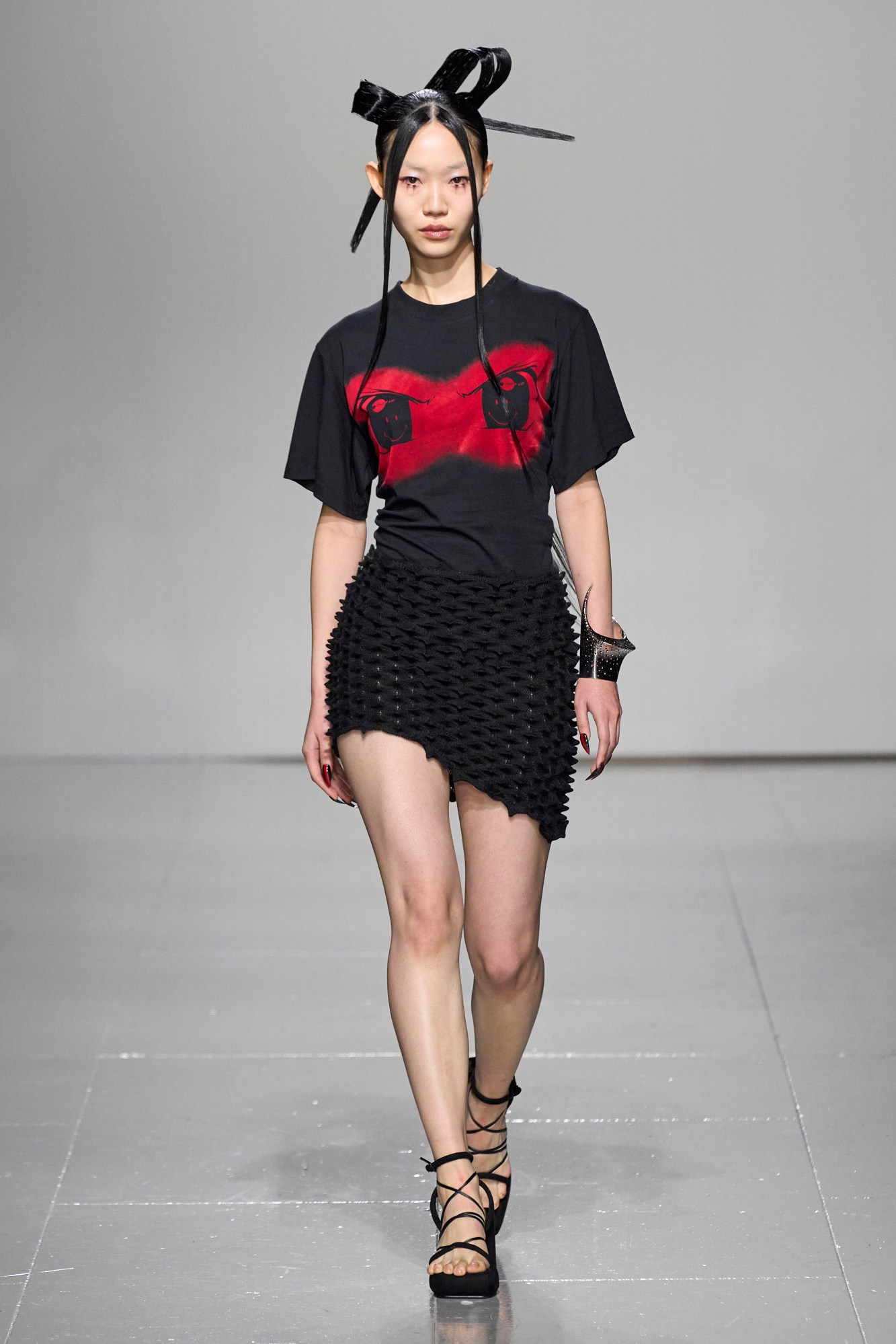
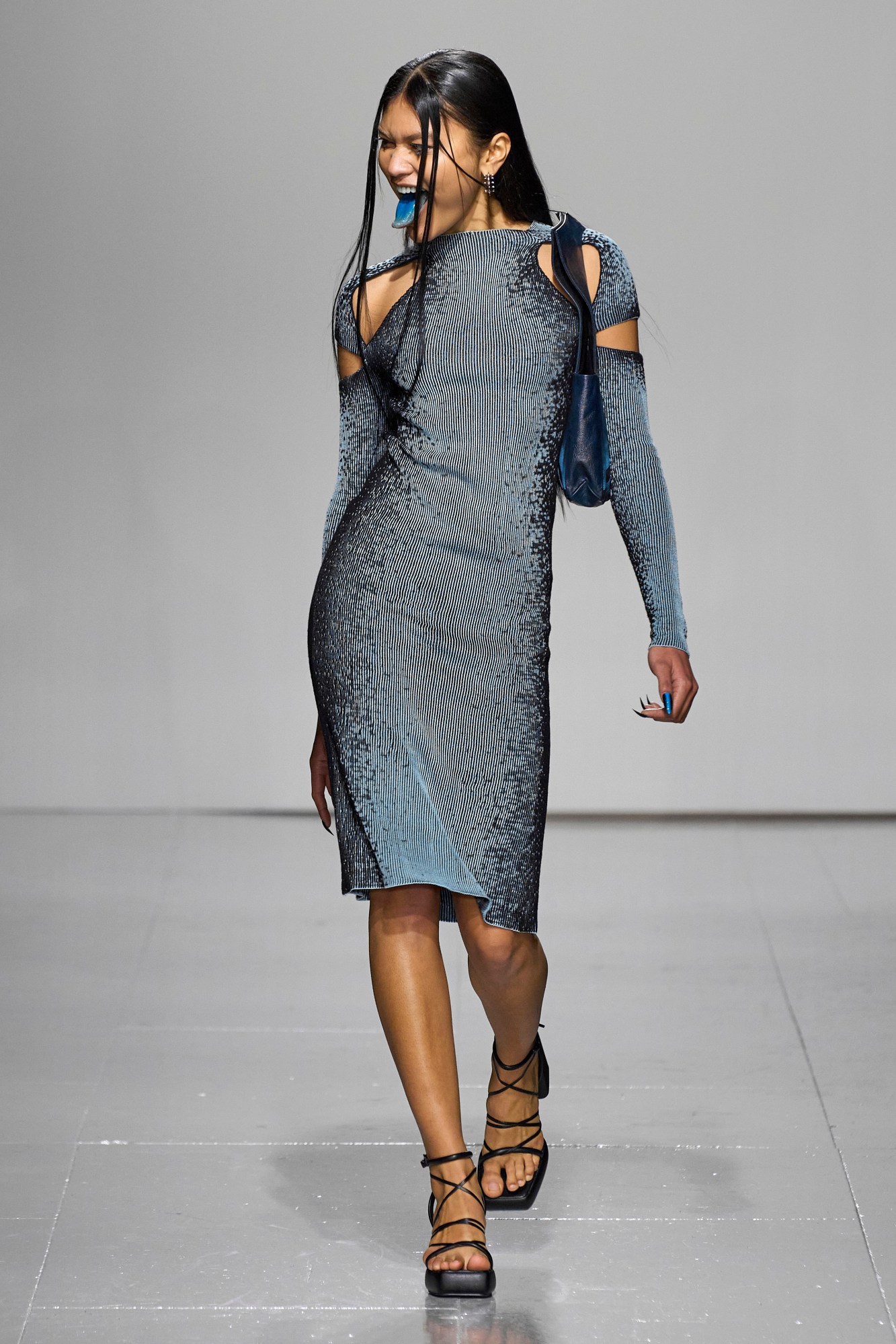
Chet Lo
Review to come.
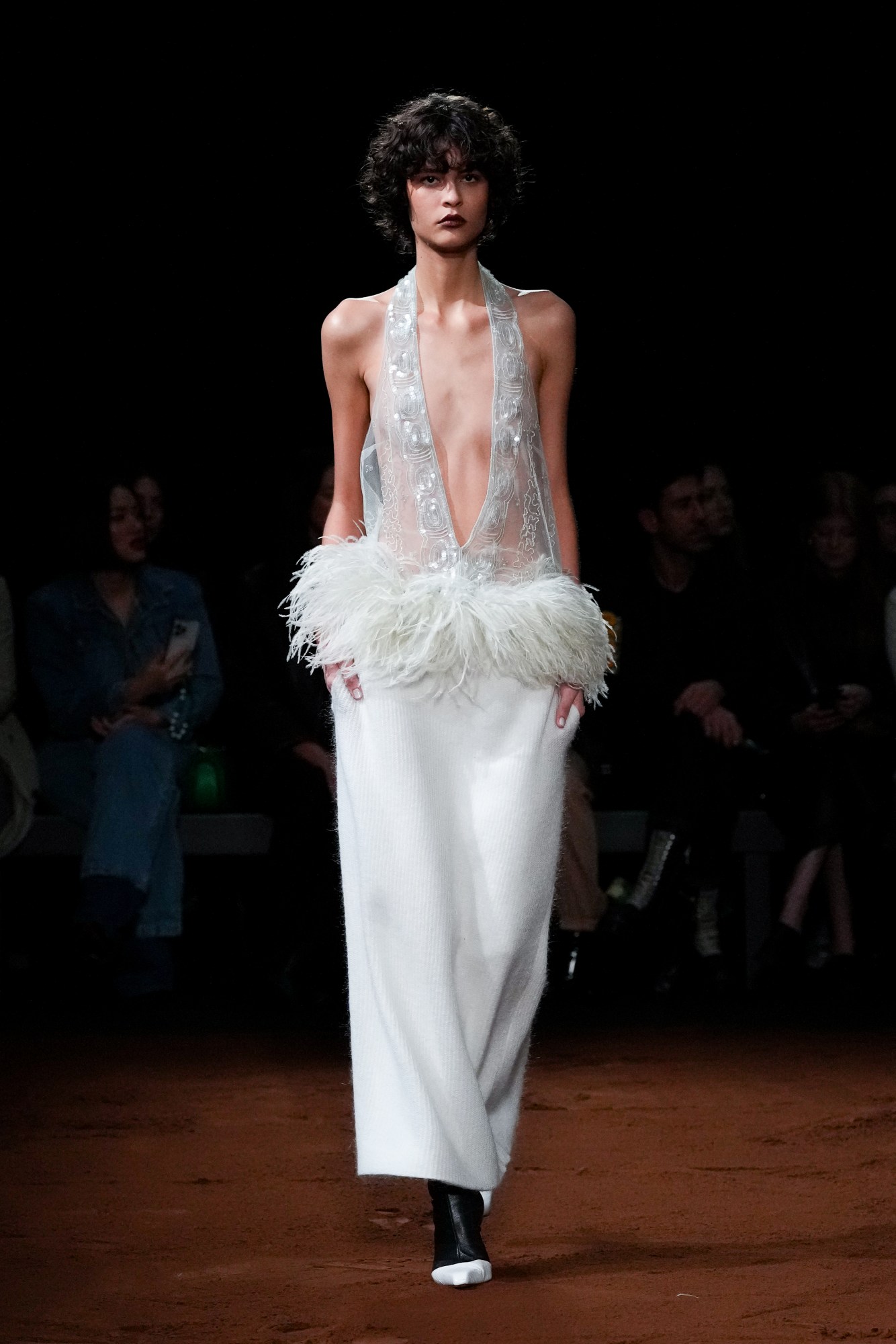
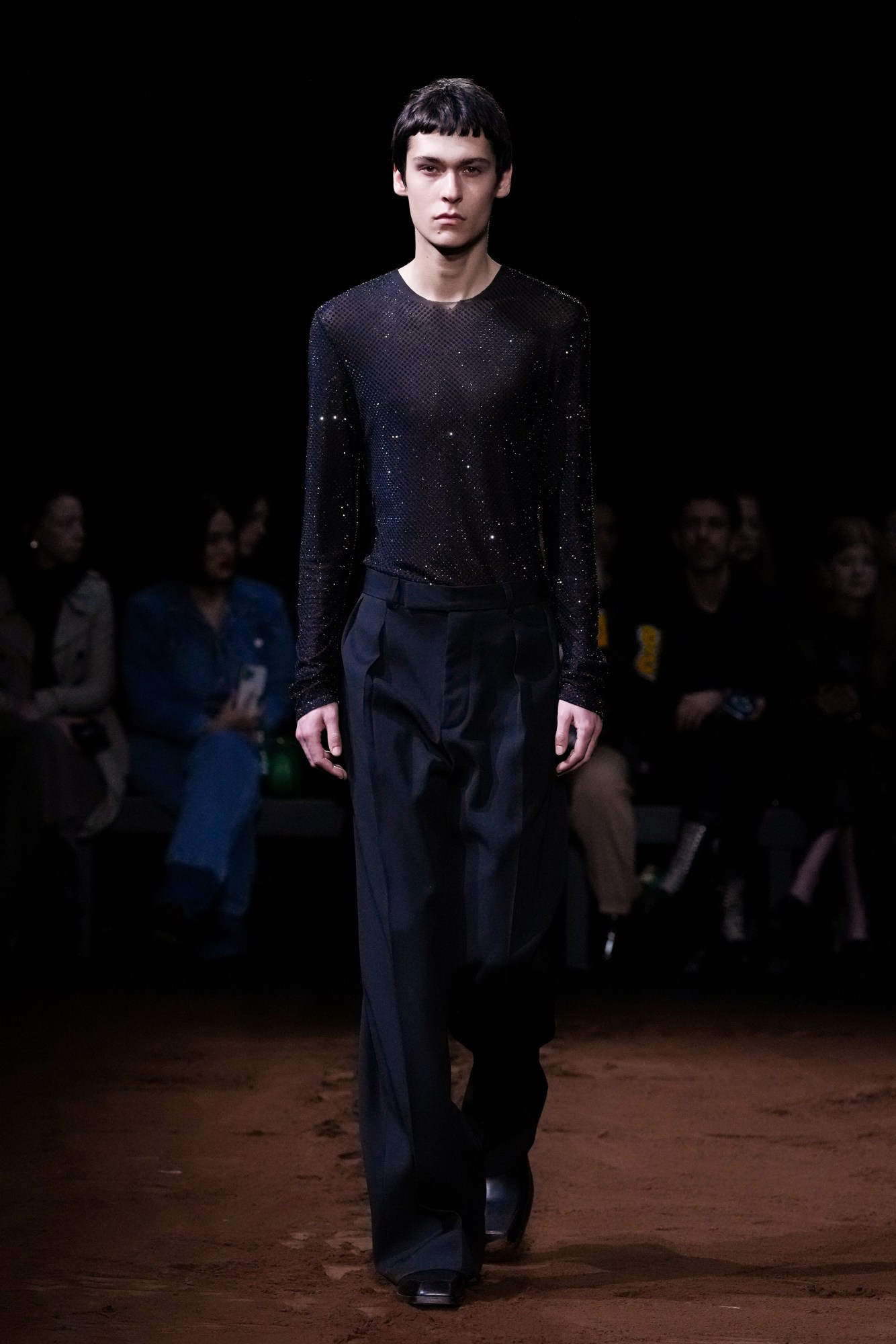
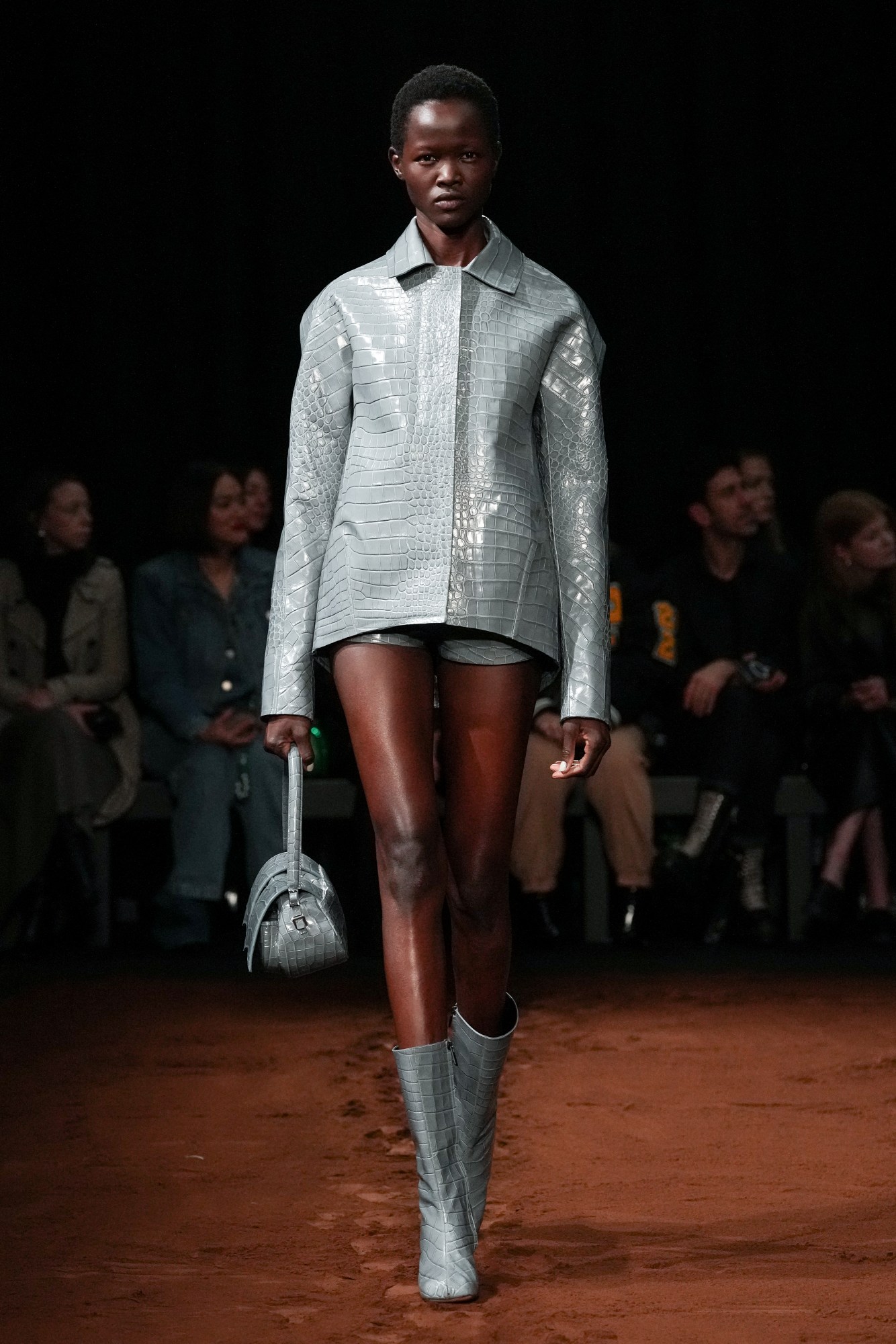
16Arlington
The title of 16Arlington’s AW23 show, Wake, is particularly evocative in light of the brand’s tragic history, particularly the sudden passing of the brand’s co-founder Federica ‘Kikka’ Cavenati in 2020. Connoting the ceremony held to commemorate and celebrate a life, it marks an important transition point — an essential part of the process of coming to terms with one of life’s hardest experiences. The collection that Marco Capaldo, now the brand’s sole designer, presented yesterday seemed to embody a similar sense of transition and processing, moving between looks that conveyed an angelic levity — bright white halter dresses speckled with glinting embroidery and trimmed with marabou feathers; slant-shouldered blazer dresses with scrims of chiffon tumbling down the front; a silver-sequinned bubble-hemmed minidress with a plunging neckline — into a more brooding suite of earthen mohair separates (including a first venture into menswear for the brand). It was also revealed in delicately appliquéd night-sky tailoring and gowns that rustled with shiny black wisps. The set that models walked, though — a square of coffee grounds, a welcome whiff at a morning show — gestured towards a secondary meaning to the titular term: the notion of waking, recollecting and moving on, a spirit that made itself felt in the general sense of poise, refinement and composure that marked the collection. Marking a new dawn for the brand, this was a body of work that paved the way for a bright future, informed by the bittersweet memories of its past. MS
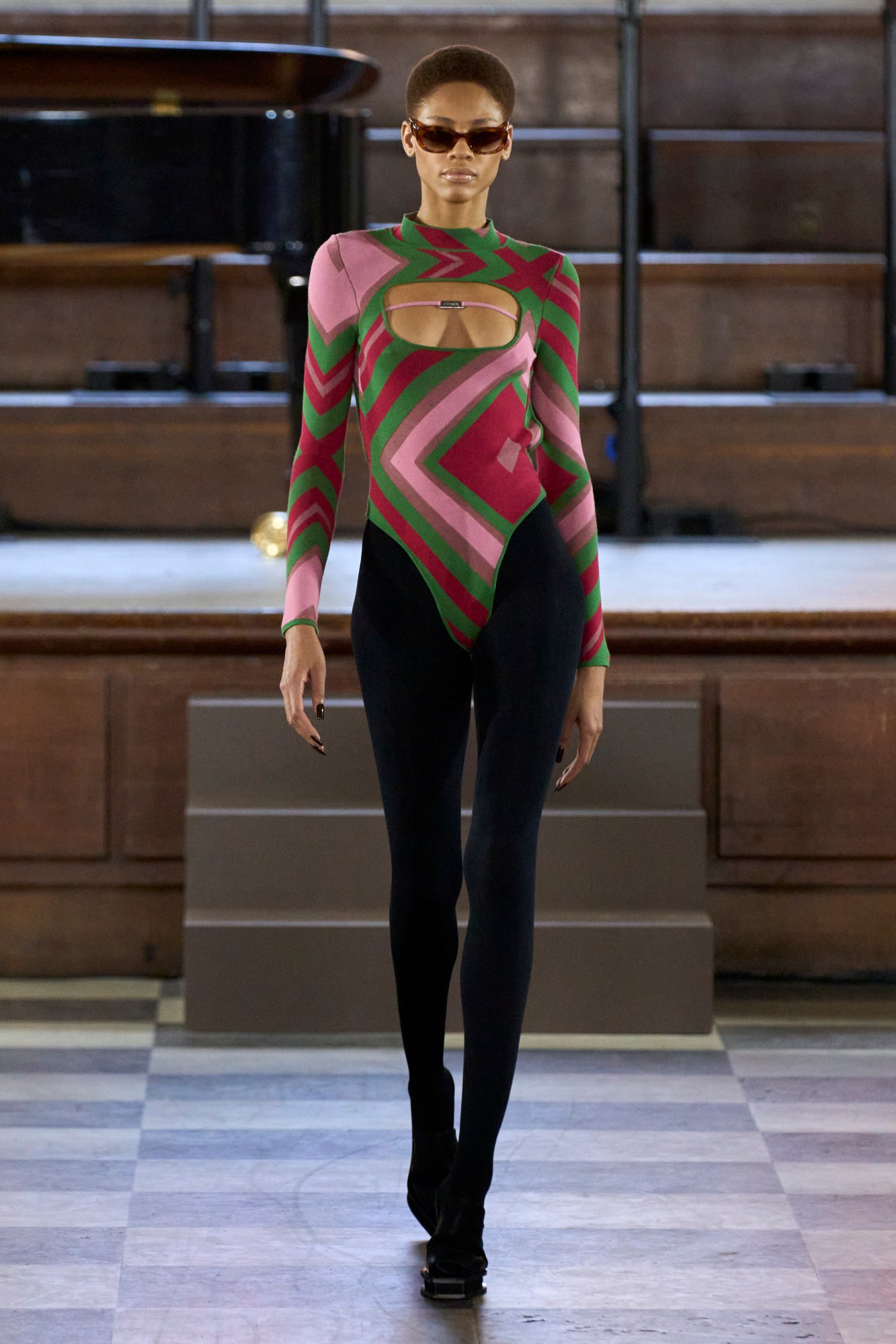
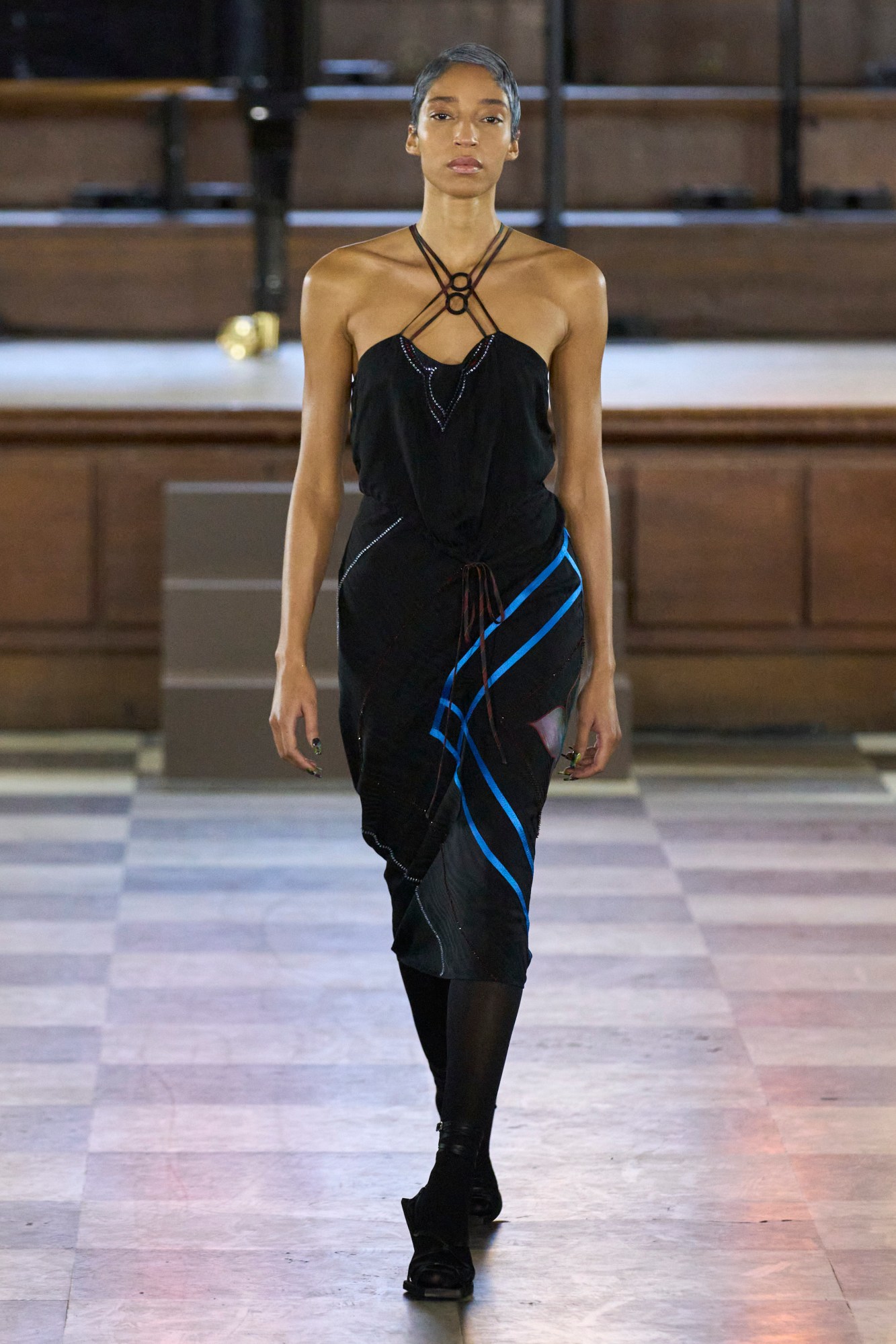
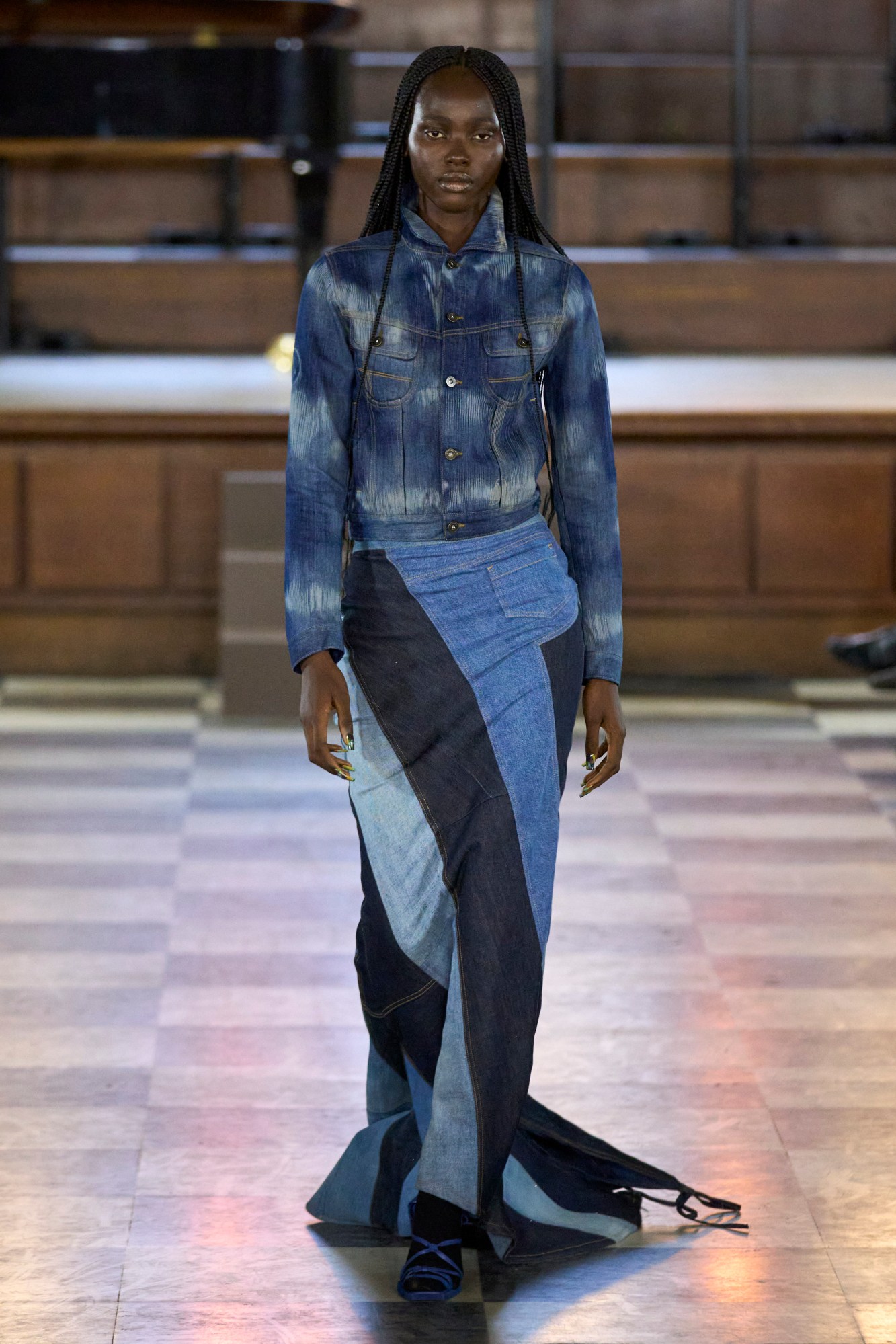
Ahluwalia
Ever since Ahluwalia’s AW23 show, we’ve all had the 2002 Missy Elliot track, “Work it”, stuck in our heads. That was founder and creative director Priya Ahluwalia’s intention. Playing on her own nostalgia by making a collection that spoke to the symphony of her life, soundtracked by a live band to the music that’s followed her through life, that, she hopes, the audience would pick out strands of, too and relate back to their own memories. “Everything about the collection relates to sound,” Priya shares after the show. Against a blend of the Bollywood movies she watched as a child, Y2K hip-hop, bashment and house music from teen house parties and the afrobeats and neo-wave R&B she’s into at the moment, all filling a baroque church turned concert venue in St. James Square, this nostalgic love letter to the music that Priya loves infiltrated the clothes and the casting too. “I really wanted to have a reflection of the diaspora, mainly where the music was from. So South Asia and the Black Diaspora is really where I tend to listen to and engage with music,” she said. What this looked like was models – cast by her friend Troy and completely styled by a team of women of colour – with glamorous Bollywood blowouts or who were reminiscent of the style of Sade, wearing dresses printed with the soundwaves of songs such as the legendary musician’s “Kiss of Life” or Whitney Houston’s “I Will Always Love You” – the song her mum says was playing when Priya was born. Sometimes these references were literal, like a male model in a slim two-tone utility vest in homage to Tupac and stunning waves of patchworked denim that formed dresses and skirts reminiscent of the looks Priya remembers Lauryn Hill wearing in the 00s. Elsewhere, the references were more subtle, with cotton and viscose separates and mohair knits in earthy tones such as umbers, reds and ochres that were picked out from the cover art of beloved albums, or ring detailing across the front of womenswear that was inspired by the way the ropes of an Indian tabla drum are threaded.
There was a celebratory tone to the collection too, not just because of the live band and club-ready tracks that were playing. From sharp tailored suits in bright, joyous colours and sleek hooded cocktail dresses, to rave-ready football tees and matching mini skirts and crop tops under billowing puffer coats; every look was ready for a night of partying. And, there was a lot to celebrate! This collection was the brand’s first venture into footwear with dramatic thigh-high boots, collab UGGs and angular-front, animal-print creepers, meaning, as Priya proudly shared, it’s the first time she has crafted an entire outfit worn by her models from head to toe. The letter ‘A’ brandishing belt buckles and printed over tees and shirting felt like a signal that this was clearly a deeply personal passion project for Priya, one that lifted Ahluwalia into exciting new realms and opportunities. TG

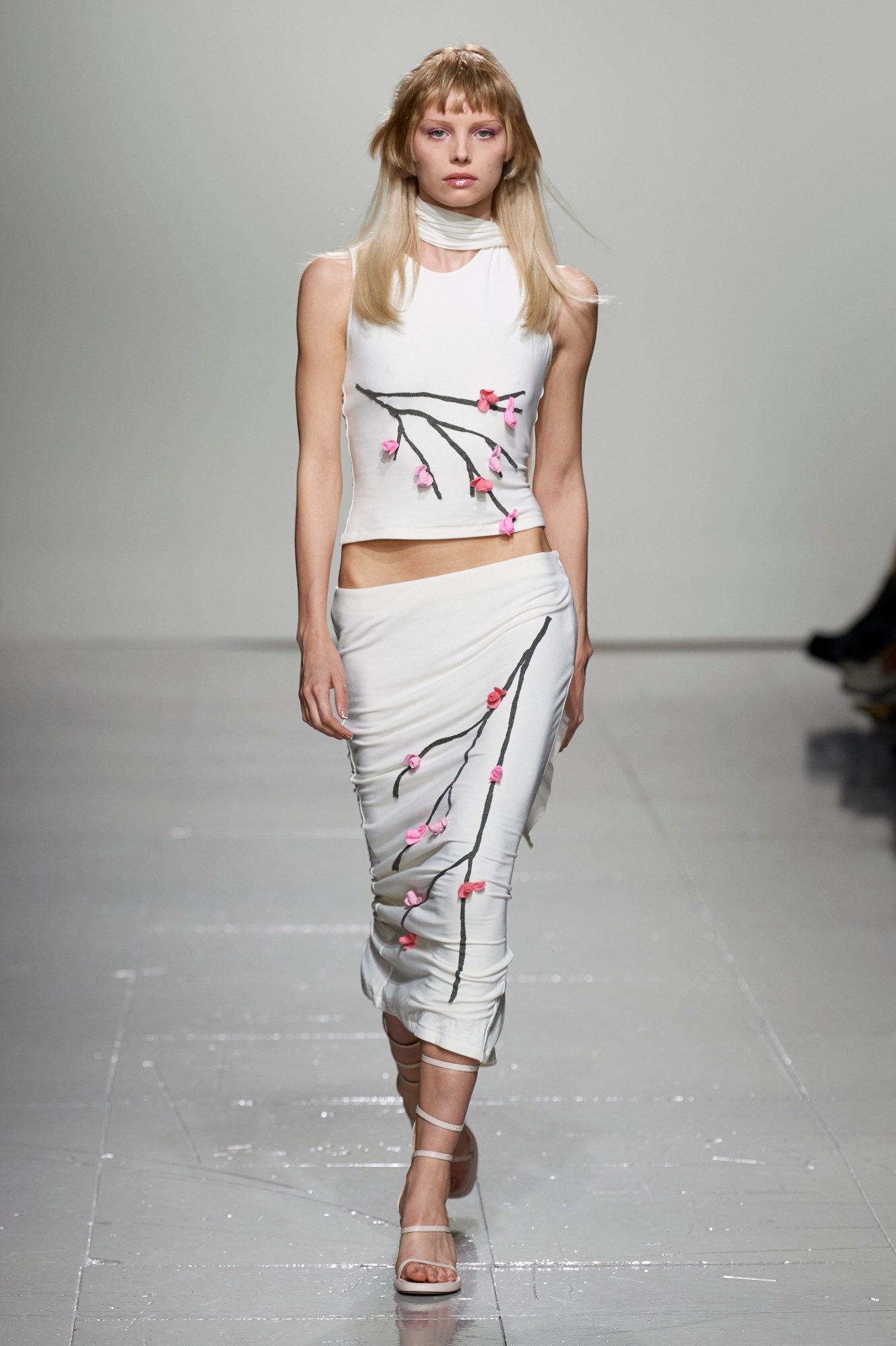
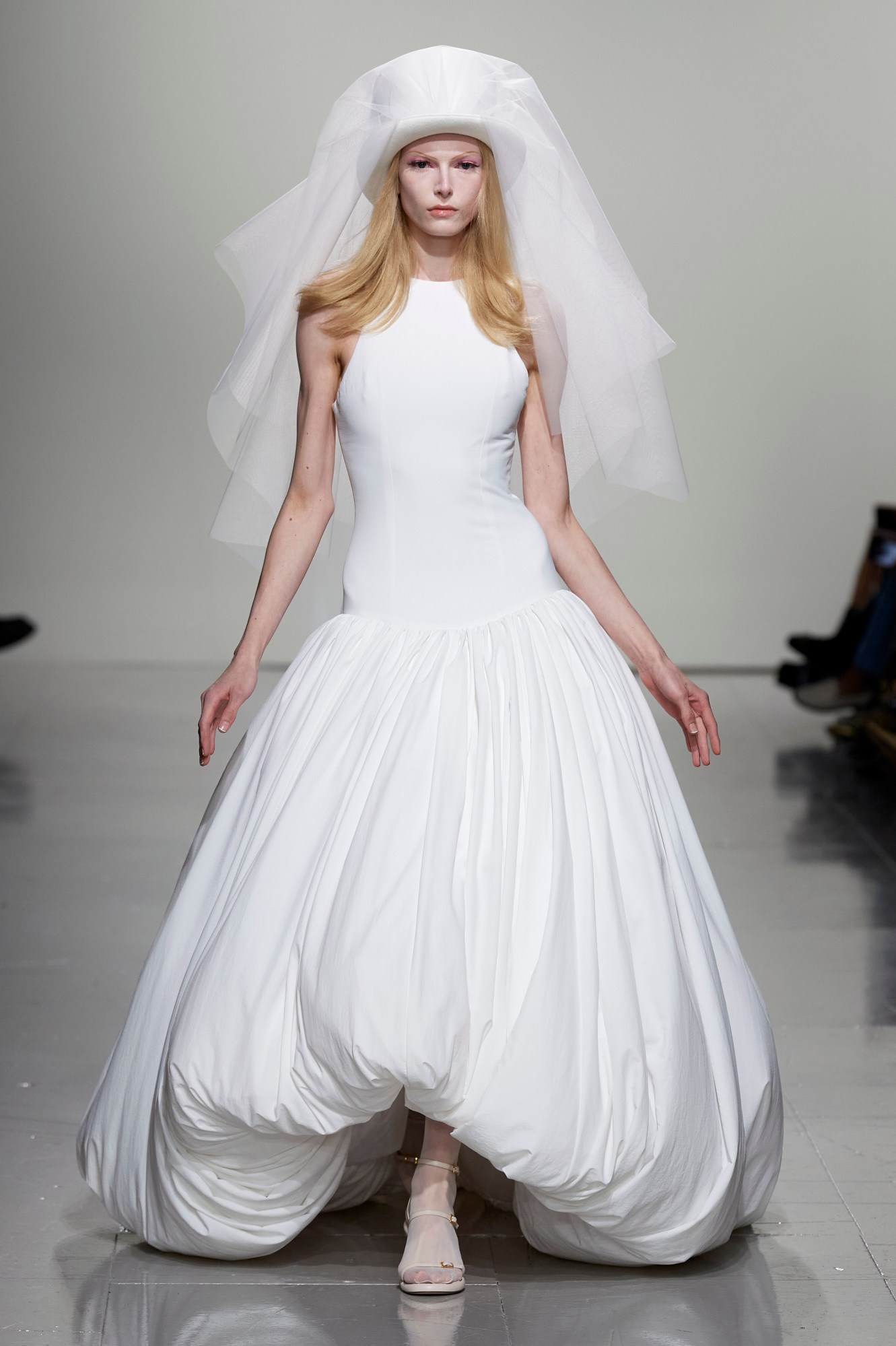
Conner Ives
Conner Ives’ latest collection took its title from Magnolia, Paul Thomas Anderson’s 1999 film — “a bricolage of different lives, as they go about trying to make sense of their past, and the emotion it still conjures in them,” as Conner summarised it. It may seem like an unlikely cinematic reference, given that the movie set in the San Fernando Valley is hardly known for its costumes or stylised visuals. Instead, the collection offered a cast of individual characters, their clothes denoting archetypes, social signifiers and sartorial clichés — in a good way! — that felt like peering into Conner’s obsessions and memories of soaking up pop culture in the 2000s. Each look came with a character description, often nodding to familiar faces. There was Kate Moss at Glastonbury (chubby shearling gilet, patchwork boots, micro-skirt), Carrie Bradshaw (bell-sleeved LBD, floating headwrap), Diane Keaton (slouchy white shirtdress worn agape, complete with a necktie), Nan Kempner (bias-cut slip dress, fashioned from surplus Americana t-shirts). This was a collection as varied and kaleidoscopic as your TikTok ‘For You’ page; a universe in which lavender camisoles worn over wide-leg jeans (very Lizzie McGuire) sit alongside the curved silhouettes of Modish coats and couture-inspired tweeds.
One of the great things about Conner, and perhaps an indicator of his generation’s attitude, is that he is an unapologetic fan of fashion — and he’s not afraid to admit it. That may sound obvious, but you’d be surprised by how unfashionable fashion is — even in fashion. Conner is emphatically open about his love for designers, shows, Hollywood movies and the pages of his mother’s glossy magazines that he devoured as a teenager. Case in point: he’ll gush about how he looked to Nicholas Ghesquière’s AW06 collection for Balenciaga, which he discovered as a tween, and lay out his canon of references in a way that feels radically different to fashion’s mystified creative process and snobby aloofness. It’s refreshing to see such a joyful celebration of clothes, a serious and sincere deification of the Y2K era, which is so often reduced to memes. In the words of Magnolia’s ‘Quiz Kid’ Donny Smith: “We may be through with the past, but the past is never through with us.” MS

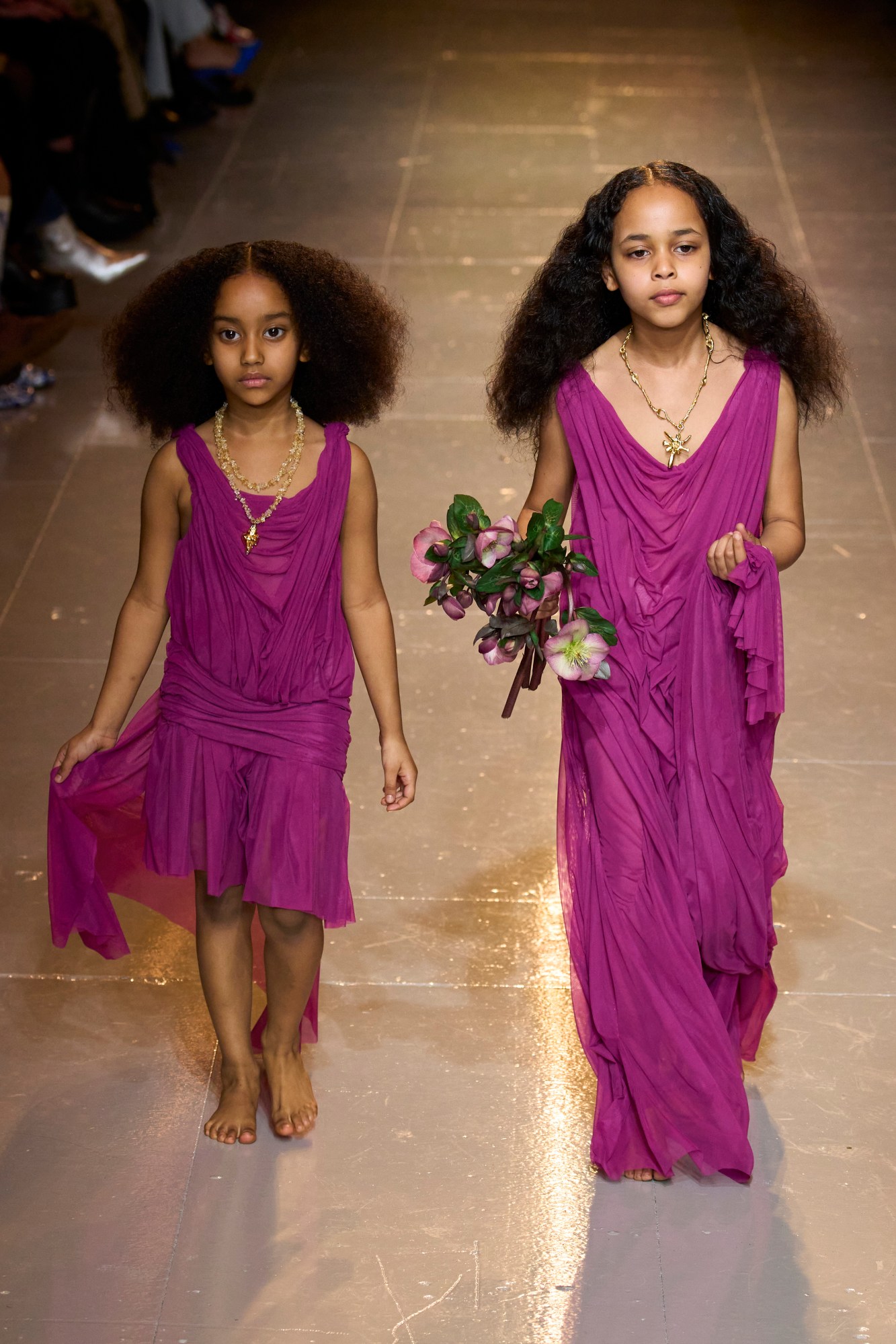
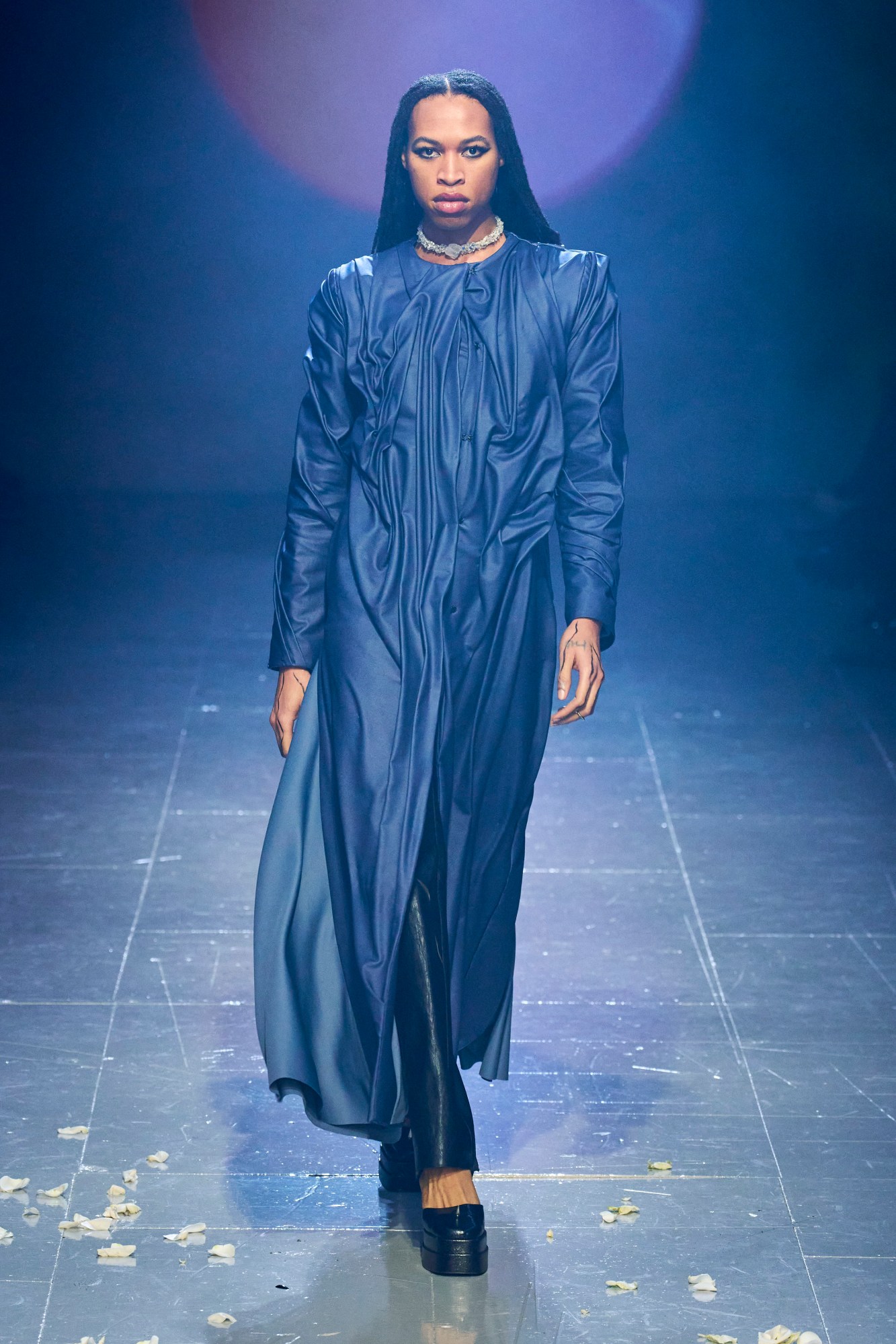
Di Petsa
Di Petsa‘s AW23 show was a celebration of femininity at its most ancient and visceral. Taking inspiration from one of our first ever female coming-of-age stories, Persephone (who went from standard Greek maiden to mythological goddess of the underworld – what a glow-up, honestly!), the brand turned their catwalk into a storytelling stage. The audience gathered around a rock, upon which Dimitra Petsa held court, performing a visceral piece on womanhood as the place where all life on earth comes from. Di Petsa’s signature wet-look drapery was updated to reflect the craggy surface of the rock Dimitra gyrated on, the fabrics mixed up with recycled, vegan leather corsets to look like cracked earth, dip-dyed as though the models had stomped through muddy waters, the tones and “broken drapery” meant to evoke ancient Greek archaeological sites. Inspired by Persephone’s mum Demeter, children and pregnant models — with bellies both real and constructed by fabric — took to the runway, swirling sage and handing red wine to the designer at the centre of the celebration. Just as Persephone mutated, the collection did too, from earthy greens and reds to silvers and blacks representing her descent into the underworld. By the end of the show, Dimitra was covered in wine and water and smoke, and we’ve seen every ancient archetype of woman pass us by, from mother to daughter, from lover to temptress, from maiden to demon. This was a story of creation and evolution (not just in the looks but in the brand itself, which introduced bridal for the first time this season). After sending us all into Hades, the final look is a chiffon-engulfed angel, to bring us back up. Truly, the duality of woman! RL
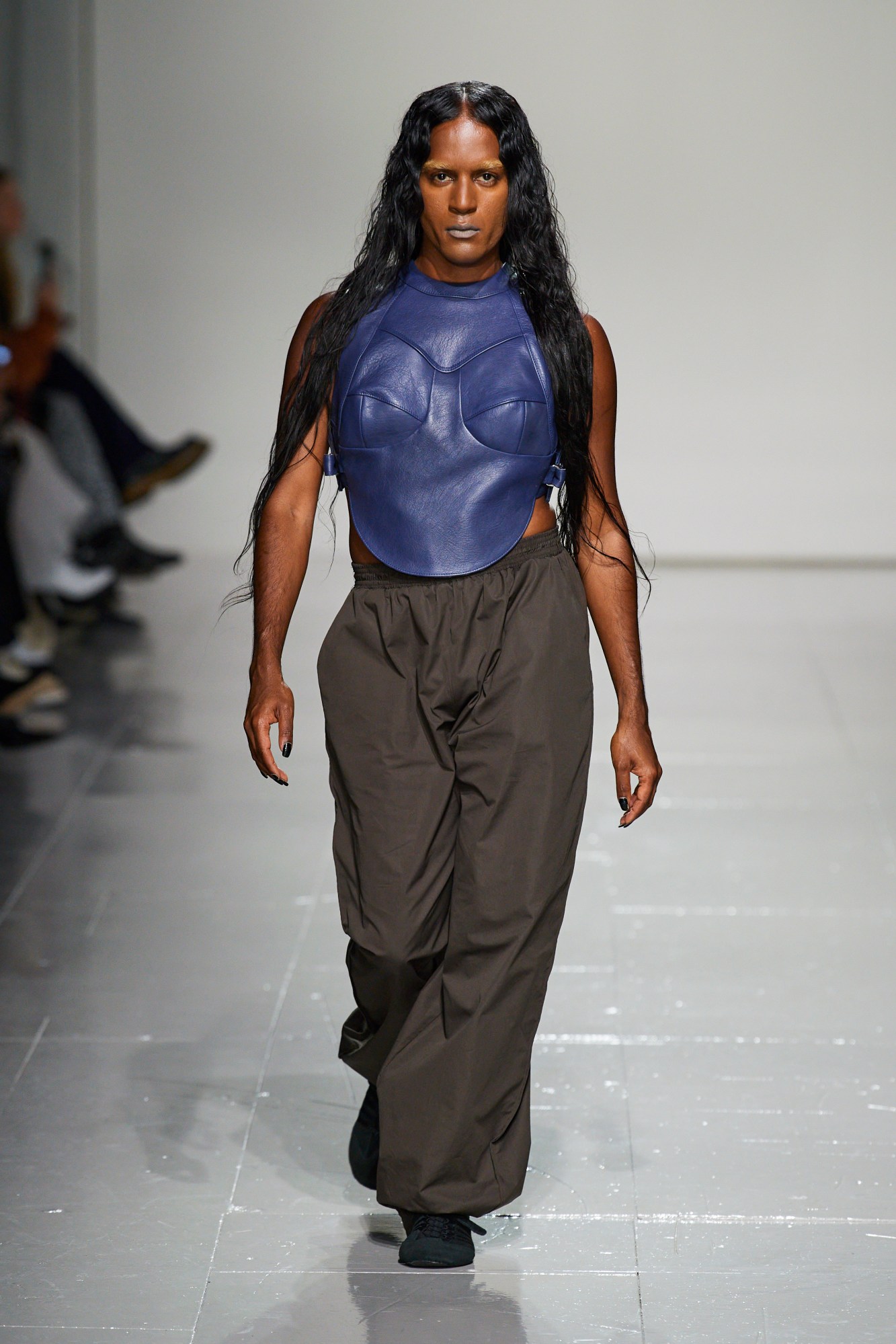
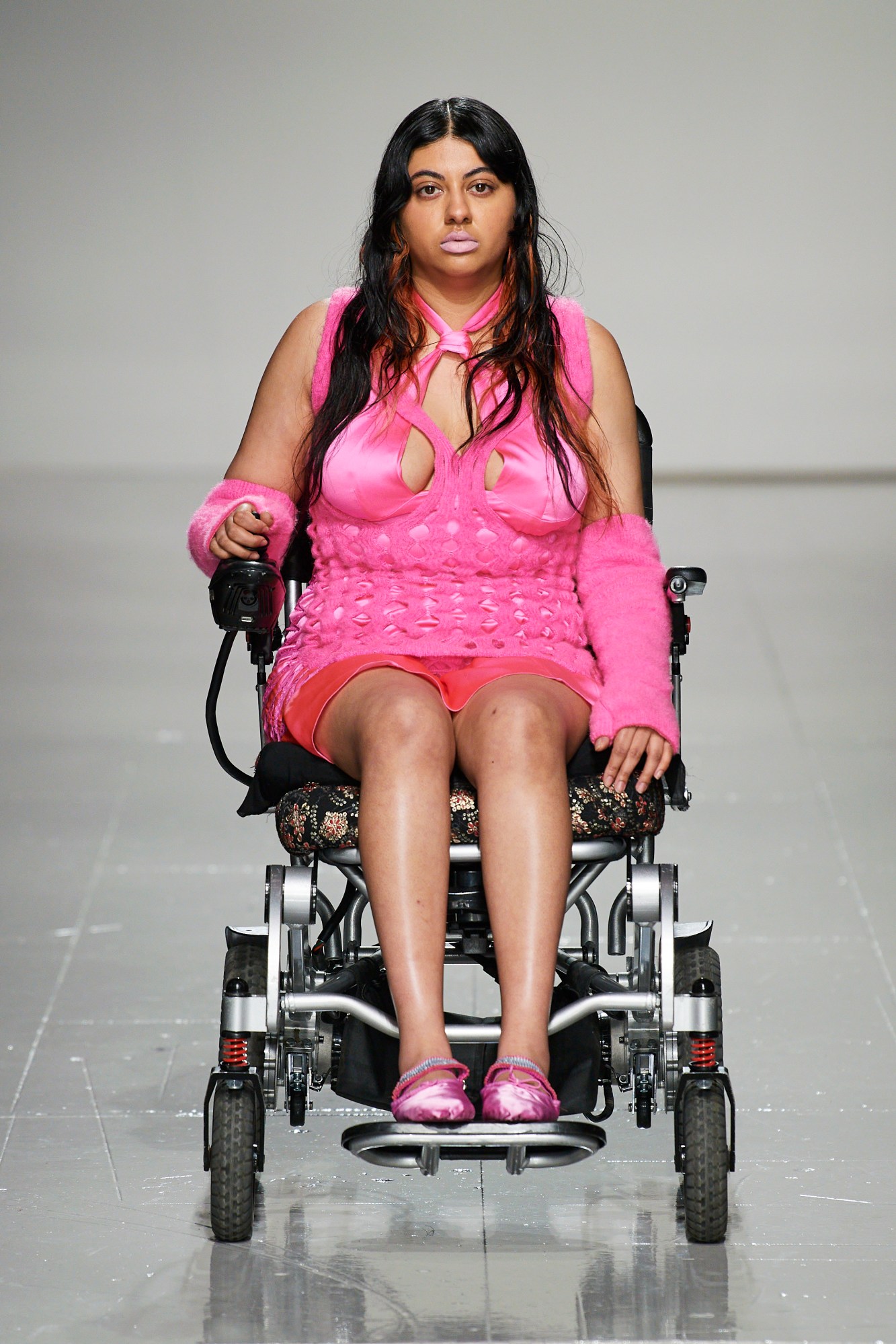
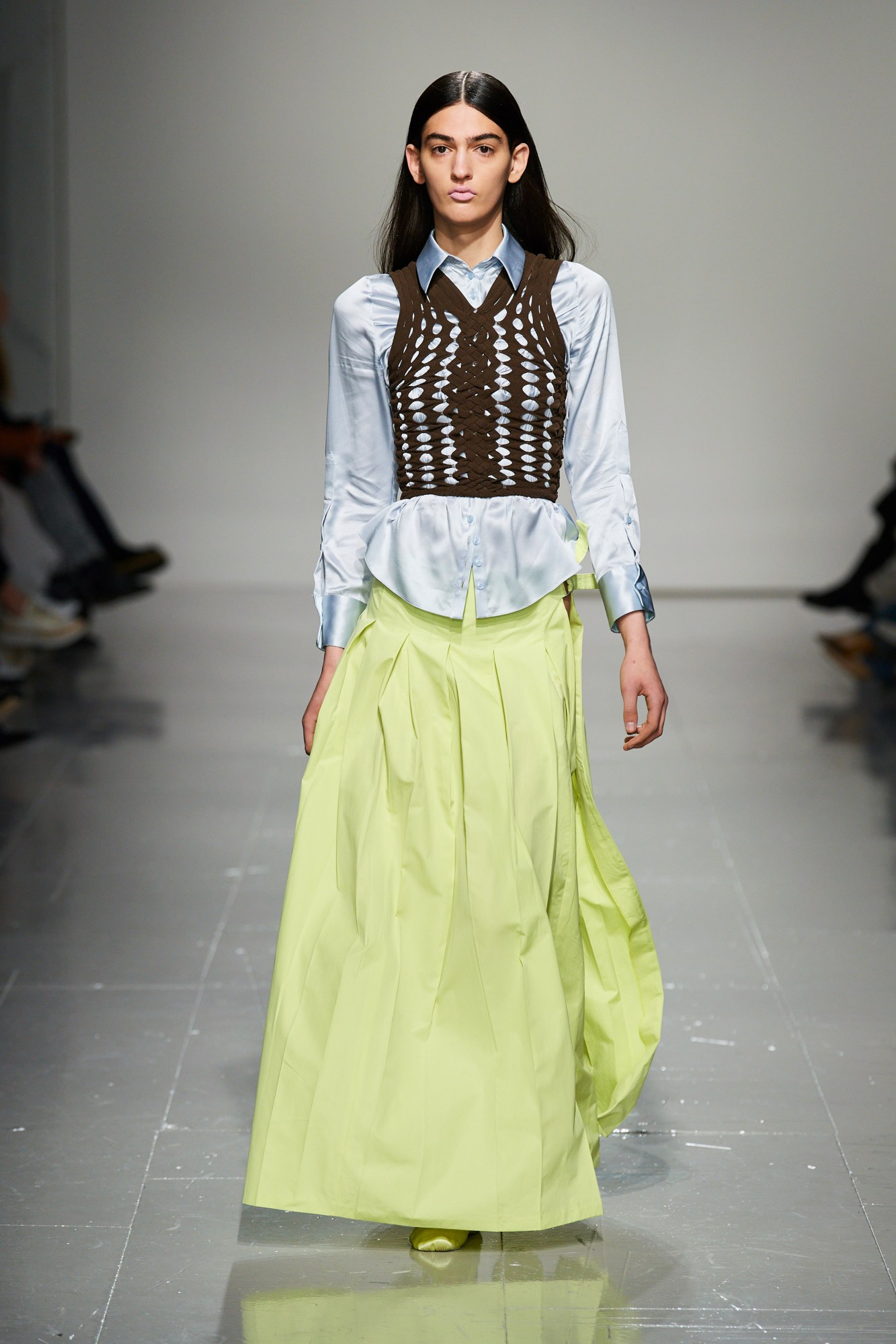
Sinéad O’Dwyer
That Sinéad O’Dwyer should open London Fashion Week felt fitting. Granted, the premium spot was well deserved, given that, last season, she was one of the designers who shifted to the sub-optimal Tuesday slot on account of the Queen’s passing. More than that, though, the collection she presented was an apt note to start the week on; a metaphorical dawning for the ethics that a new generation of designers – both in London and the world over – are insistent in placing at the heart of their work.
Easily the designer’s most accomplished body of work to date, it offered a meditation on notions of romance and desire – how our experiences of these emotions differ, and the fundamental roles garments play in expressing them. Drawing on her own recollections of being a wayward teenager in rural Ireland, the uniforms that Sinéad and her schoolmates wore while first coming to terms with those first swells of romance translated to poplin shirting constructed with necktie halters that scooped down and around the chest, tailored vests with the designer’s signature moulded bust construction, and straight-leg trousers in supple deerskin and cotton drill. Webbed merino slip dresses in mossy greens and deep navy, and shibari-inspired tights crafted from fused bands of shirred satin conveyed a flirtatious spirit, while abbreviated black leather wrap skirts and waistcoats suggested a darker, lustier timbre.
Balancing that out were pieces that conveyed a timeless sense of romance, clothes inspired by those found in the wardrobe of her late grandmother, Rita – to whom the show was dedicated. Fondly recalling her penchant for a well-cut trenchcoat, Sinéad created a navy blue number here as a tribute – and elsewhere, Rita’s love for the silver-screen romance of 1940s Hollywood informed louche satin blouses, dresses with plunging halter necklines, and dainty negligées in pink and periwinkle chiffon.
As ever with Sinéad’s work, the proposal went far beyond the beautifully constructed clothing, exhibiting profound consciousness and respect for the bodies wearing them. Though it is, at this point, a given for the brand, the cast – brought together by rising casting director Emma Mattell – was easily the most diverse we’ve seen in London, or anywhere for that matter. A truly representative spread of races, body types, abilities and gender expressions, it was an assured testament to the beauty of variety – a necessary reminder, it would seem, at a time when fashion increasingly seems to be slumping towards harmful (and frankly boring) entrenched body standards. The casting choices here were made more poignant, though, in light of the collection’s central theme – it served as a reminder that all bodies experience desire and romance, and are deserving of it, too. MS
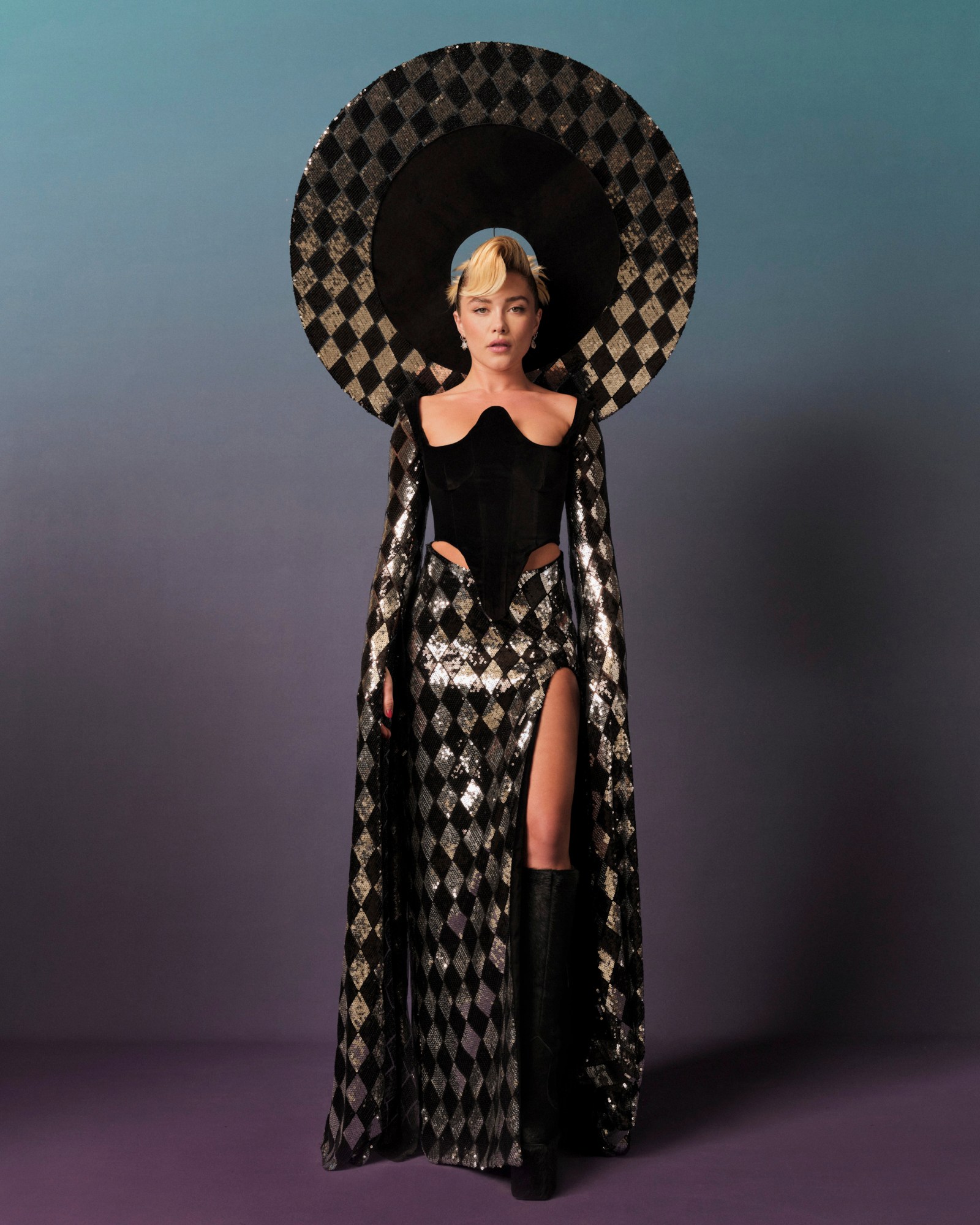
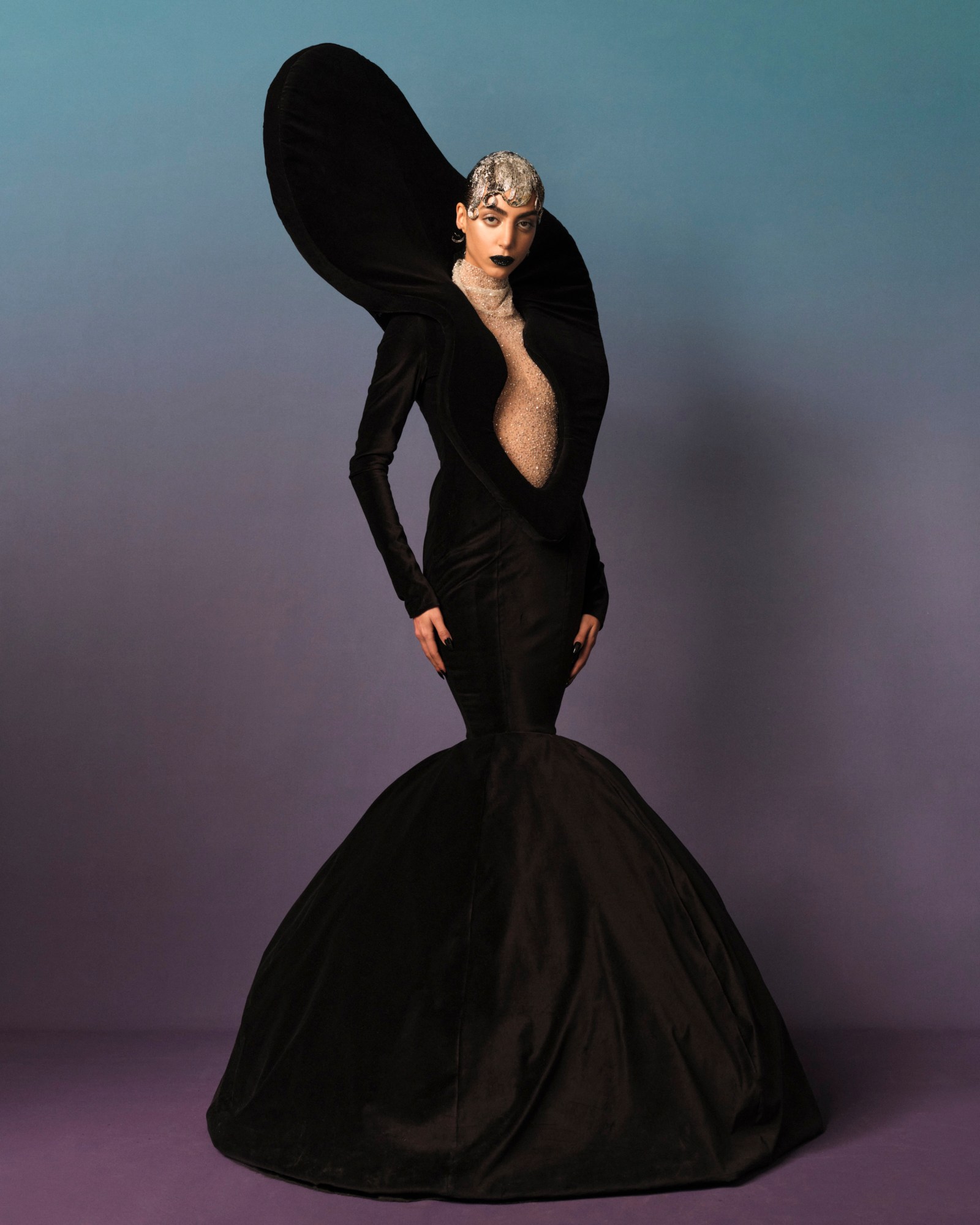
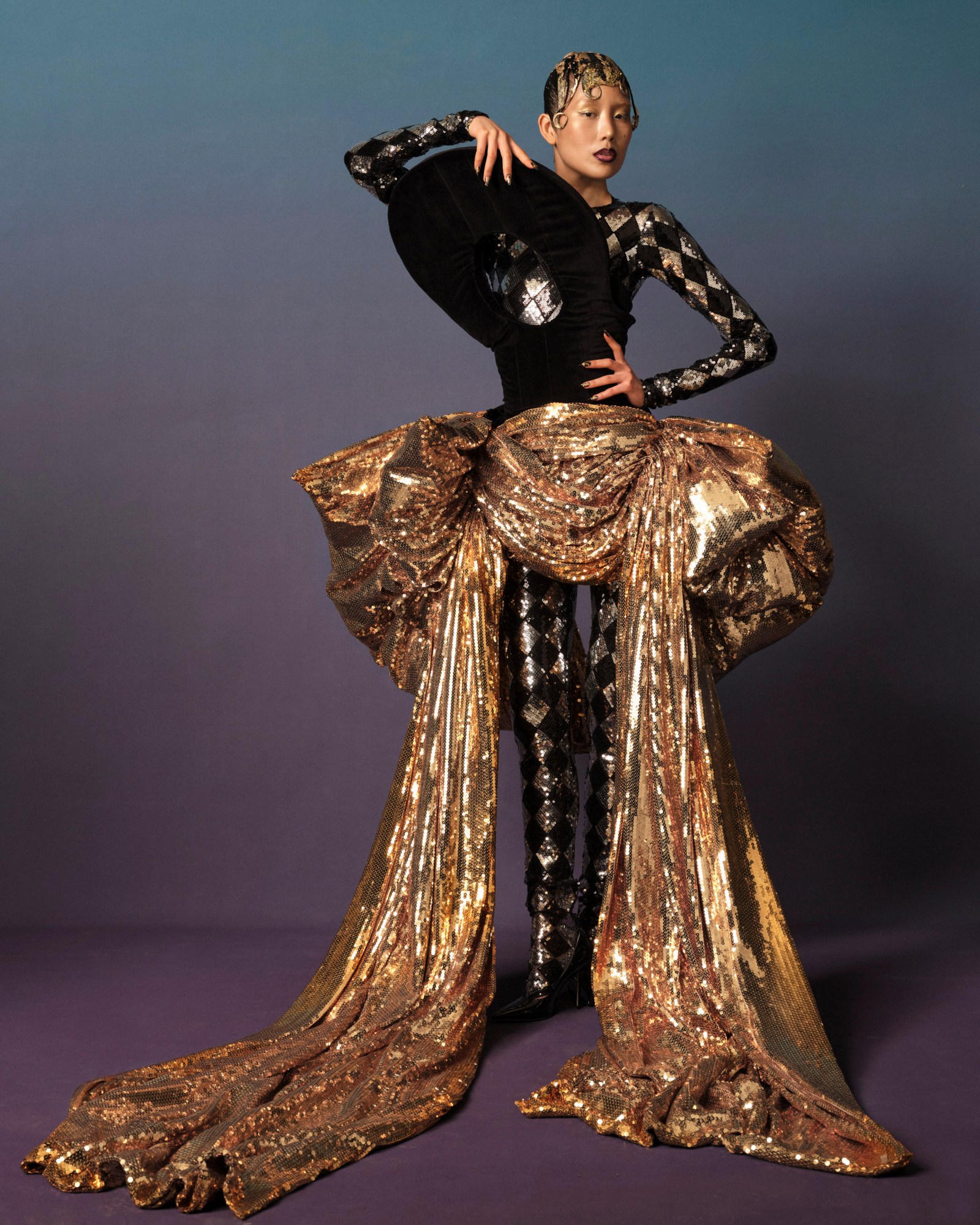
Harris Reed
All the world’s a stage was the incredibly apt title for Harris Reed’s latest collection. Just four seasons on from his graduation from Central Saint Martins, Harris is set to show his debut offering as creative director of Nina Ricci during Paris Fashion Week, and can count Harry Styles, Beyoncé, Lisa Rinna and Lil Nas X amongst the famous fans of his dramatic non-binary finery. And now Florence Pugh, too! The acclaimed actress continued the thespian energy of the collection’s Shakespearean name, opening the show that was held on a circular stage in the cavernous Tanks of the Tate Modern with a monologue about the power and performance of dressing. She called on us all to “embrace the lamé and sequins of life” while donning a signature Harris Reed oversized halo-esque hat and silver harlequin-print high-slit gown. What followed was a 10-piece collection of Harris’ demi-couture that celebrated the art of performance. Fishtail gowns in black velvet with necklines that scooped to the navel extended out at the back in bold curved shapes inspired by artist Henry Moore, mirroring the cellos being played in the centre of the stage throughout the show. Stunning gold drapes made from recycled theatre curtains hung from the arms of models in suiting and structural gowns, or ruched at the hip as if drawn back to reveal the bodysuit beneath. Harris also celebrated the act of dressing itself and the beauty, magic and sensuality that can be found before you arrive at a finished look. Corsets turned on the body in unexpected ways invited intriguing silhouettes, while a pleated skirt fanned upwards reminiscent of the famed pose of the ultimate star Marilyn Monroe. A fitting nod given that, if anyone knew the whole world to be a stage, it was her. TG
